Australian
and international
exploratory
performance and
media arts
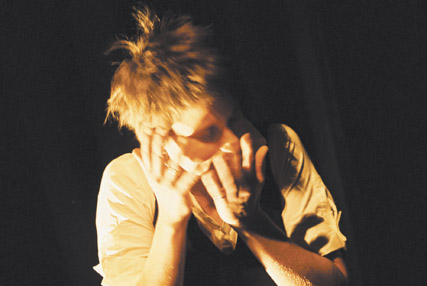
Rosie Dennis, Heidrun Löhr
photo Heidrun Löhr
Rosie Dennis, Heidrun Löhr
“EARLIER THIS YEAR I PRESENTED A SOLO AT NRLA 06. I PERFORMED BEHIND A SEATING BANK WITH A COUPLE OF HUNDRED PEOPLE CROWDED AROUND ME—HUDDLED IN A SEMI-CIRCLE. IT WAS THE FIRST NIGHT OF THE FESTIVAL AND I WAS THE FIRST LIVE EVENT. I REMEMBER FEELING LIKE I WAS GOING TO VOMIT RIGHT UP UNTIL THE AUDIENCE WALKED THROUGH THE DOOR. AT THE END OF 20 MINUTES MY SHIRT WAS WET WITH PERSPIRATION. OVER THE NEXT FEW DAYS I MET ARTISTS FROM ALL OVER THE WORLD, TALKED TO PRESENTERS ABOUT FUTURE POSSIBILITIES AND WATCHED LIVE ART FOR 10 HOURS A DAY. AS AN ARTIST IT WAS ONE OF THE MOST EXHILARATING EXPERIENCES I HAVE HAD TO DATE.”
These are the words of Sydney-based performer Rosie Dennis, who appeared in the 2006 National Review of Live Art (NRLA) as part of the Elevator program which highlights the work of emerging artists. For the 2007 program Dennis has been kicked upstairs to the One Year On program which keeps close track of artist development.
Dennis will premiere Hitting a Brick Wall Since 1984 which she describes as “examining the emotional fragility of a woman’s identity that has been fractured and fragmented under the strain of success. It explores the theme of long-term disappointment and the frustration and fatigue that can come with ongoing failure.” If this sounds a bit too much like a variation on the agonies of A Star is Born, the festival brochure also offers a corrective glimpse of “A school fete. A diamante tiara. A standing ovation and a girl lost in the glorious success of her own dreaming.”
The National Review of Live Art is a pioneering, 26 year-old annual festival of live and time-based art, an enriching, diverting and sometimes infuriating celebration of performance manifest in many forms and a multitude of bodies from around the world. In February 2006, the RealTime team caught a couple of days of NRLA in its new home, Glasgow’s Tramway, originally a public transport facility. Previously the festival had been presented in the Arches in the centre of the city beneath the main railway station. Artistic Director Nikki Millican (whose New Moves International runs the NRLA and the impressive New Territories dance festival) has a deep fondness for the Arches and its demimonde appeal describing it as “always night-like.”
If Tramway lacks the ambience of the Arches it certainly makes up for it with convenience, comfort (it was zero outide), big flexible performance spaces, numerous studio and exhibition areas, and a couple of cafes. Nor is it a slick venue; the internal architecture is mostly functional and the feel is all accessibilty—it’s not surprising to meet suburban locals and their children.
The comfort counts when you’re dashing between shows or queuing to see if you’ll get into one that word-of-mouth has pronounced a must-see. Aside from very intimate, small audience works you can’t book for NRLA shows, the result being a hit-and-miss festival experience. However, the NRLA’s appeal is also to be found in its open-ended relationship with time. While shorter performances are tightly timetabled and the daily printed program awaits you on arrival, durational works once commenced operate on their own terms for hours, a day or the length of the NRLA. You visit, you stay, you return, you witness or you miss the drama of an interruption—a fire alarm triggers evacuation of the building or an artist is suddenly unwell—or the completion of a work. (Poor Ron Athey had to be released from the many hooks in his skin as firemen hurried artists and audiences out of the building).
NRLA was well attended, many of the audience in it for the duration, student numbers strong (tickets are cheap), plenty of European visitors and a few from the US, and a contingent of key figures in UK live art infrastructure.
The main components of the NRLA are the Residency Artists and Invited Artists programs. Resident artists work throughout the event, making themselves accessible to other artists and audiences, as did photographer Manuel Vason who exhibited and spoke about the images (of performances no one but he witnessed) created in collaboration with leading practitioners (www.artcollaboration. co.uk). Live art duo FrenchMottershead orchestrated massive group photographs of audiences and artists in A Daily Ritual to Capture the Presence of Everybody (www.frenchmottershead.com). Shot and subsequently displayed in the Tramway foyer, these highly detailed images compounded the sense of community that was a feature of the event.
NRLA also runs The Winter School, an annual program of professional skills development and research projects open to artists, emergent and experienced, working in live art and related practices. Often the mentors will the artists featured on the Resident and Invited Artist programs.
The 2006 Invited Artists program included both established works and others commissioned by NRLA. Sekou Sundiata’s Blessing the Boats (US) was a poetic meditation on a life of poetry, drugs, racism and kidney disease: a time capsule from the 70s opened by this eloquent writer-performer. In Death is Certain, Eva Meyer-Kellers (Germany) conducted a quiet aesthetic assault on a punnet of strawberries as we gathered around her. She tortured, injected, burned and drowned the fruit, one piece at a time, producing a droll commentary on art practices along with some more disturbing resonances. Additional performances were staged to meet audience demand. Geraldine Pilgrim’s Sea View (www.corridor.eu.com) was like a stay at an eerie bed & breakfast, its wallpapered hallway punched with holes that reveal underwater swimmers returning your stare, its bedroom offering a vista of a tilting ocean horizon and, worse, a slow leak over the bed, a steady plop, staining the bed rusty red. Elsewhere, Sarah Potter invited her audience to be touched and cradled, to challenge our increasing sense of separateness and consequent lack of compassion, and her own feeling of being “detached all the time, like I’m sending information to the printer, but it isn’t connected.” At the entrance to this meditative event, a printer churned out Potter’s evolving thoughts.
One of my favourite NRLA pastimes was to visit Lisa Wesley & Andrew Blackwood’s (UK) growing maquette creation in a glass house in Tramway’s backyard. The all white modelling of buildings and objects and the artists’ play with perspective, revealed the sheer oddity of growth and decay in contemporary urban landscapes. Ron Athey’s Incorruptible Flesh (il luminous) was erogeneity writ large. Stretched out before us in a small dark space, face fish-hooked, scrotum massively ballooned with saline solution, anus tattooed and bared, flaring with its image of the sun, Athey’s HIV positive body was essentially a still image of pain as art and art as pain. Jennie Klein, writing on the NRLA website felt that the work was “unbearably beautiful, evoking in many viewers a feeling of profound tenderness and protectiveness towards Athey,” Some accepted the invitation to rub oil onto his body.
I admired NTGent’s Omvallen (Flemish for “to turn over”) by writer-director Sanne van Rijn. This fast-paced surrealist domestic farce for two masked female performers was staged in a small, magical wall-papered bourgeois home, a perfect companion piece for Pilgrim’s Sea View. The minimalist turnover of obsessive actions and murderous powerplays was grimly engrossing and exhilaratingly well choreographed. NTGent will be in the 2007 Sydney Festival collaborating with director Christoph Marthaler and ZT Hollandia on Seemanslieder.
I’ve only been able here to offer a glimpse of works from a huge program which included artists from Thailand, Japan, Taiwan, Philippines, Pakistan, India and Poland. Artists that attracted attention in the Elevator program included Rosie Dennis, Nic Green and Rajni Shah. Shah’s long overlapping performances included transforming from an Indian bride to Elizabeth I in an investigation, sometimes deft, sometimes awkward, into Englishness where costumes were lowered onto the performer by stage managers and the deployment of cloth, a salt border and makeup created an intriguing installation. Shah and Nic Green are also in the 2007 One Year On program.
nrla 2007
NRLA 2007 will take place again at Tramway with the Black Market International collective and Anne Seagrave as resident artists. Seagrave will perform a major work comprising a one-hour daily performance, Jamais Vu, a staged self-portrait publicly erased by the artist herself over five consecutive performances. The 11 member renowned international artist collective Black Market will occupy one of Tramway’s large spaces for the duration of the festival, creating a five-day “life installation” with audiences welcome to drop in at any time.
NRLA’s 2007 Invited Artists again come from around the world and with an astonishing range of projects that vigorously defy conventionality. The UK’s Simon Raven and Aaron Williamson present The Dawn of the Deli, which they declare “the realisation of a new ‘slow slapstick’ genre” with monks “attempt[ing] to answer the growing demand for monk-brewed condiments, authentic moon-dried tomatoes, goat’s brie…” to an accompanying Gregorian/Death Metal mix. From Quebec, performance poet, sound and live artist Alexis O’Hara offers herself as The Sorrow Sponge. Mistermissmissmister, from Portugal’s Ana Borrahlo and Joao Galante, is about the “erotic imaginary, confronting the viewer “with characters whose bodies are extremely exposed and that show a very obvious gender/sexual ambiguity.”
Chumpon Apisuk’s (Thailand) SilenceSilence is a meditative response to the disappearance of a human rights lawyer Somchai Nilapaijit. The program also includes, curious, the UK duo (Leslie Hill and Helen Paris) familiar to Australian audiences, in a new work, (be)longing. Guillermo Gómez-Peña & La Pocha Nostra members Roberto Sifuentes and Gabriela Salgado will boldly “create a poetic interactive ritual that explores neo-colonization/de-colonization through acupuncture and the re-enactment of the post-9/11 ‘body politic’.”
Gwendoline Robin from Belgium will be explosive in a different way, triggering small bombs on her body in the manner of stunt men but with poetic intent. The UK’s Richard Hancock and Traci Kelly present Dermographia, drawing on the Devils of Loudon, Genet, and the Deleuze and Guattari notion of ‘becoming-animal’, all “written through the skin of a static performer, a silent observer, and a solemn witness.”
On the multimedia front, there’s Res Publica from France in man in |e|space in partnership with Belgian collective LAb[au], creating a four-screen interactive environment with live dancers who, “under the cover of darkness, will be reduced to glowing lines emitted by costumes whose long light sticks will outline their body movements, captured and processed in a 3D digital environment, then projected onscreen.”
A strand of contemporary music works makes a distinctive and apt addition to the NRLA agenda. Daan Vandewalle (Belgium), in a work of pianistic endurance, plays the Alvin Curran marathon piece, Inner Cities, in which audiences can come and go at will. Electronic music pioneer, playwright and director Giovanni Fontana will present Electronic and Sound Mask. Jan Kopinski & Reflektor will play Kopinski’s Mirrors. This Opera North commission features the composer on saxophone, plus piano and soprano, in a work about “dislocation, memory, and transition” embodying reflections on Polish history using visual imagery and the country’s musical traditions. (NRLA 2007 also includes Poland’s Kazmierczak and Rybska, see p39.) The Panacea Society featuring leading European performance artist Andre Stitt on vocals and Matt Cook on guitar and laptop will play FREAKBEAT-PSYCHE-GARAGE-PROG-TECHNO-MUSIC with visuals from VJ Jacuzzi Junta.
The above is just a sampling of a packed NRLA 2007 program, enough to illustrate the astonishing range of work that falls into the encompassing live art ambit, an ample, fecund space for shows high budget and low, innovative, silly and outrageous, meditative and, not least, politically charged.
The National Review of Live Art, Tramway, Glasgow, Feb 7-11, 2007, www.newmoves.co.uk
RealTime issue #76 Dec-Jan 2006 pg. 44
© Keith Gallasch; for permission to reproduce apply to realtime@realtimearts.net
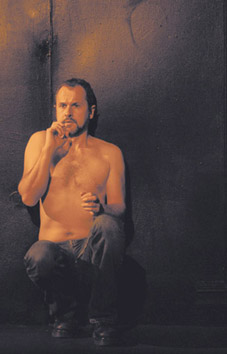
Humphrey Bower, Fyodor’s Demons
photo Nick Higgins
Humphrey Bower, Fyodor’s Demons
PHILOSOPHERS HAVE LONG THEORISED THAT THE UNIVERSE IS A PROJECTION OF OUR SELVES. WE SENSE THE WORLD THROUGH OUR SKIN AND VIA OUR CREATIVE GAZE, REPRESENTING IT IN OUR OWN IMAGE. A CRISIS OF SELF ENGENDERS COSMIC CRISIS, AND VICE-VERSA. THEATRE MAKER HUMPHREY BOWER’S ONE MAN SHOW, FYODOR’S DEMONS, RESONATED DEEPLY WITH SUCH EXISTENTIAL PROPOSITIONS.
Collaborating with dramaturg Sophia Hall, Bower placed a confessional narrative from Fyodor Dostoyevsky’s The Devils alongside the bleak parable of the Grand Inquisitor from The Brothers Karamazov. The former details the moral indifference of a self-interested layabout who seduces or rapes his landlord’s young daughter (Dostoyevsky’s text figures the acts as ethically indistinguishable) leading her to suicide. The second is a series of Orwellian pronouncements made by a Catholic Inquisitor who has imprisoned the reborn Christ for performing miracles outside of the Church’s authority: an aggressive justification of ruthless institutional power.
Although Bower’s pre-recorded voiceovers and performed millenarian musings on the presence of Satan in a Godless universe had little overt relation to the principal character’s story, the juxtaposition implied that each enabled the other. In a cosmically corrupt world, men have no values, while the protagonist’s behaviour created the conditions necessary for the victory of evil. This rendered Fyodor’s Demons a fable for our times of war, terror and torture, where political crisis and moral nonchalance go hand in hand. Will our leaders too come to make icons of those victims whose spectres haunt them and which can engender a tragic, ethical consciousness?
It was not however principally the text which distinguished Fyodor’s Demons, but Bower’s performance. The space was consistently portentous yet precise, a clearly demarcated area lit only by candles. A chair acted at one moment as a prop and at another as a resonant presence standing in for a figure whom Bower addressed. Opposite was a bed on which he variously lounged as though smirking at the universe, or collapsed into as though his very soul had reproached him. The actor effectively contrasted his normally relaxed, slightly doughy demeanour with moments in which almost imperceptible muscular flexion suddenly defined his body in space and in tension as his character leant back and folded his arms behind his head, smug in his cruel mastery of body and action. Like the Devil, Bower’s protagonist adopted an array of outwardly innocent masks, providing a parallel between his chosen method of theatrical exposition and the content—dealing as it did with moral deception and false, performed roles. Drawing heavily on the dramaturgy of Jacques Lecoq and Robert Draffin, and using a text which prefigured Albert Camus’ The Fall, Fyodor’s Demons was a masterwork of theatre craft.
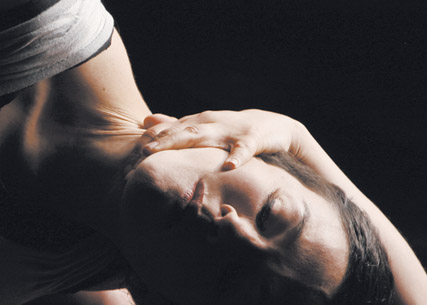
Paea Leach, Solos Project
photo Guy Willoughby
Paea Leach, Solos Project
Paea Leach’s two pieces in her Solos Project similarly depicted worlds which various forms of embodied perception engender. Devised with choreographer Shannon Bott, Housework created a realm and mode of being at once playful and easy, yet one within which Leach negotiated physical and spatial obstacles. Dressed in a baggy costume adorned with planetary bodies, Leach performed on top of and around a raised, inclined cruciform structure with two arms like a broken H. An illuminated model of a house floated behind, suggesting a Surrealist conflation of object and psyche. Who was dreaming whom, the performer or the house? Fabric flapping as Leach swung her arms or bounced in a standing position on her toes, the choreography often reflected a sense of playful interaction, roughly translating as ‘We both know you are watching me perform this slightly absurd action, but I will not let on.’
In the more serious second half, Leach rapidly swapped between two poses side-on to the audience, staring straight ahead as her feet deftly crossed the gap between the set’s arms, repeatedly placing herself on the brink of a miniature precipice—after which she stepped into this void and found rest. The speed and precision of Leach’s negotiation of Alex Jack’s and Jessica Hutchinson’s set implied the empathy between one’s home environment and one’s body. This house was custom built for these feet, just as these feet were shaped by familiar space.
Sustained by a wonderfully varied radiophonic score from David Corbet incorporating static, beats and plucked, pastoral guitar, Housework offered a gentle ambience of consistent, subtle developments. This contrasted with the aggressive bodily transits and multiple, distinct sequences which made up Leach’s collaboration with choreographer Simon Ellis, Four Acts of Violence Leading Up To Now. The “violence” of the title was somewhat misleading. Certainly, the driven choreography and the representation of those states approaching exhaustion (offered both live and through close-shot projected sequences) implied physical assault. Sharp, bright sounds of inspired breath and echoes of body slaps were played back, while spoken, projected and pre-recorded text intermittently referred to scenarios suggestive of recent attacks. Nevertheless, acts of violence were not depicted or named. Like pain, violence haunted the work as an unrepresentable presence, or an upper limit for the production’s aesthetics. Four Acts was redolent with the possibility that violence had precipitated its course, yet such acts were elided.
A comment on the Four Acts website (www.skellis.net/FourActs/index.html) was apt here in identifying the passage of time itself as the traumatic “act of violence” presented. Leach’s body smashed, whirled and collapsed within a markedly horizontal space, a realm defined by the passage from left to right—or of being squashed down, from above, and into the horizontal—rather than a space of depth. Leach was constantly almost hurtling offstage into a new cinematic frame, a new time, seeking release from traumatic endurance. The richly affective dramaturgy of Four Acts demanded one read through it, beyond suggestions of the representation of emotions or even ideas present within the work itself, and instead look for those absences and boundaries of what one witnessed on stage, transcending to some degree the experience of watching the show itself.
If Fyodor’s Demons and Housework offered worlds projected by bodies and individuals, Four Acts represented a thoughtful dissolution of body and presence through what was nevertheless a highly kinaesthetic experience.
Fyodor’s Demons, performer, devisor Humphrey Bower, designer Clair Whitley, lighting designer Nick Higgins, composer, painter Jess Ipkendanz, dramaturg, adaptor Sophia Hall; Blue Room, Oct 26-Nov 18; The Solos Project, co-devisor Paea Leach; Housework choreographer Shannon Bott, composer, projections, co-devisor David Corbet; Four Acts of Violence Heading Up to Now, co-devisor, choreographer Simon Ellis; designers Alex Jack, Jessica Hutchinson, costume Paula Lewis, lighting Richard Vabre; Bakery Artrage, Perth, Oct 27-Nov 3
RealTime issue #76 Dec-Jan 2006 pg. 33
© Jonathan Marshall; for permission to reproduce apply to realtime@realtimearts.net
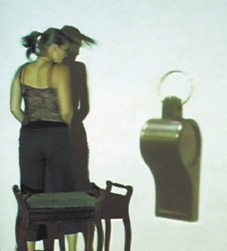
Aimee Smith, First Entry
photo Thao Ly
Aimee Smith, First Entry
IN WG SEBALD’S FINAL NOVEL, AUSTERLITZ, THE WRITER COMPARES THE NOCTURAMA OF ANTWERP ZOO AND THE WAITING ROOM OF ITS CENTRAAL STATION. BOTH IMPOSING BUILDINGS, ONE IS FOR THE DISPLAY OF NOCTURNAL ANIMALS AND THE OTHER FOR THE SHELTER OF TRAVELLERS.
Sebald likens his fellow travelers to “the last members of a diminutive race which had perished or had been expelled from its homeland”, suggesting “that because they alone survived they wore the same sorrowful expression as the creatures in the zoo.” This analogy exemplifies the liminal sensibility of Sebald’s travel narratives in which an openness to chance, recollection and coincidence has the cumulative effect of providing insight. Kylie Ligertwood has been inspired by the way Sebald’s acclaimed writing seems to be without deliberation and its content generated en route.
Ligertwood recently invited five artists of interdisciplinary persuasion to step into her darkened studio at PICA and in discrete improvised performances respond to the strangeness of her installation. Executed specifically for the performances, it comprised a shifting, abstract projection and a pensive arrangement of components such as clock, red rug, piano stool and suspended door handles. It was personal in scale and the audiences who were squeezed into the studio felt physically implicated in the work. Due to the precision of Ligertwood’s arrangement, it could have read like a surrealist painting that had jumped out of its frame. However the artist, more animateur than stage manager, ensured that the configuration was pared back. Her installation did not disturb the chamber-like structure of the room but did cue our imaginations for the performances about to unfold.
For Ligertwood, and any audience members who attended all five shows, the residue of previous performances must have hung in the air. This was certainly the case for the two successive performances I experienced. Tanja Visovesic’s jerky movement reminded me of the neurological disorder once known as St Vitus’ Dance and Roderick Sprigg matched Visovesic’s psychic torment in a punishing physical workout. Sprigg’s performance was more akin to sculpture because he remained mute and relied on a disembodied recorded voiceover while the primary function of Visovesic’s body was as an instrument for her voice.
There was a sense that a kind of transference from one artist to another was possible. Ligertwood’s twilight installation had a watchful quality that seemed to absorb the performers’ energy both physically and metaphorically. The dust disturbed by Visovesic as she ripped up the turf laid in the studio became airborne and mingled with Sprigg’s perspiration. Both artists underwent painful and obscure processes of retrieval—Visovesic communing with the dead and Sprigg tapping into muscle memory to complete his grueling routine. Their powers of concentration were formidable. Visovesic called on all present including those who had previously inhabited the studio when it was a schoolroom. Sprigg, however, shut down from his surroundings more and more as the gap between his mind and body visibly closed. The walls of the studio were imbued with the artists’ slant on memory but also traces of any previous activity.
The selection of artists attuned to Ligertwood’s melancholy poetics was crucial. These two understood that their task was not to blend performance and installation nor to be interpreters of the underworld feeling created by Ligertwood. Their approach set up an exchange with the installation rather than any relationship between performer and backdrop. On this count, the restrained, compressed nature of Sprigg’s performance was more effective than Visosevic’s, which was occasionally too overwrought for the soundtrack provided by her minstrels. Coming second, Sprigg also benefited from the way in which Vivosevic’s performance had deepened my level of attentiveness to the space.
First Entry triggered musings about what the artists might have had in common and how they diverged. In the charged atmosphere of the Tower Studio, inexplicable echoes and flows between the six artists and the five audiences did not seem far fetched. Although Ligertwood’s citing of Sebald did order my response to the performances, any chain of influence between them was not even or regular. Ligertwood and her collaborators successfully eluded any suggestion of a domino effect. In the reciprocal spirit of the project, Ligertwood is now responding to the performances with audio works to be broadcast across the Perth Cultural Centre and with video and further installation in PICA’s clock tower.
First Entry, insallation, Kylie Ligertwood, performers Tristen Parr, Clyde McGill, Aimee Smith, Roderick Sprigg, Tanja Visosevic; presented by Perth Institute of Contemporary Arts & Artrage; PICA Nov 1-5
RealTime issue #76 Dec-Jan 2006 pg. 34
© Jasmin Stephens; for permission to reproduce apply to realtime@realtimearts.net
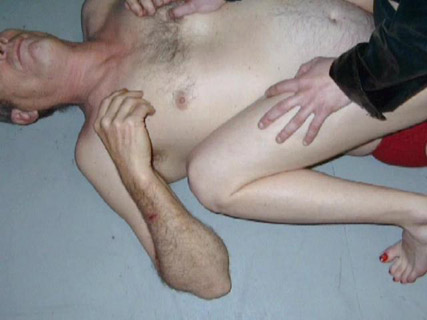
Scene
DEBATE SURROUNDING DANCE FILM IS HARDLY NEW, BUT IT SEEMS FROM THE FORUM, CUTTING FILM FOR THE BODY HELD IN PERTH (AS PART OF ARTRAGE AND IN ASSOCIATION WITH REELDANCE), THAT THE DISCUSSION IS HOTTING UP.
This passionate and crucial debate is about the hybridisation of art forms and the role dance film plays. Does the human body need to be ‘present’ in dance film? Should there be an emphasis on the role of film rather than dance in critical analysis? There was choreographical dissent in the forum. Multiple voices interjected, chuckles and scoffs from frustrated participants and a dancing around the potential for offence. Unfortunately, the Body Cuts selection of local dance films following the forum was, with several exceptions, less provocative and stimulating than the debate surrounding the medium.
The 14 films, curated by Edith Cowan University Research Fellow Jonathan Marshall, was a mixed bag of student and professional choreographer and filmmaker excursions to the very boundaries of dance film. An Apple a Day (director Jeremy Stuart, choreographer Emma Chatt) is influenced by the choreography of bygone musical cinema. Dirty Laundry, by DJ Childsplay and Tanja Visosevic, provocatively stretches the limits of what might be considered dance film with a furiously repetitive movement of a fist in a washing machine. Scene (led by Tanja Visosevic) is a series of still images of bodies: an armpit, an ankle, a painted toenail, a body mounting a body. However, in some films the camera seemed to be removed from the moving performer as though the filmmaker, or choreographer, was scared of the potential of their own embodiment.
In opposition to the dislocation I sensed in Body Cuts is the extraordinary repertoire of dance film by the ReelDance award finalists. Watching these films was like witnessing a living, breathing, dancing painting. Each finalist creates a dialogue between (notions of) landscape, the corporeal and narrative. However, three of the films in Body Cuts did achieve this sense of dialogue. Threads, directed, choreographed and performed by Claudia Alessi, is about a solitary woman in a confined domestic space caught on a super-8 camera, giving the impression of a fading memory. The film incorporates a lovely manipulation of light, repetitive and scattered movement with some fabulous choreography against a window—a possible escape from isolation and confinement—which ends with Alessi sewing together the loose ‘threads’ of her dress, a closure of the foggy and frenzied, yet remarkably warm, moments of memory.
Lapsang, with cinematography, editing and direction by Andrew Ewing with a remarkable soundscape by Found: Quantity of Sheep, is a masterful excursion into the embodied movement and temporal score of water, death, light and touch. The film is of a woman dying in a bath, and then later in the ocean, interrupted by shots of a man frantically removing bloody evidence while dressed in an anti-toxin suit and mask. The film plays with repetitious movement—an extreme close-up of a revolving eye, the man scared to touch the plastic body bag, the woman sucking in air bubbles underwater, a frenzied gesture of wiping her face and smearing her makeup. As the film progresses the score incorporates more instruments until a crescendo matches the turbulent movement and fast paced editing. Lapsang is fleshy, dynamic and rich.
The untitled film directed by Zena Loxton and choreographed by Jessyka Watson-Galbraith is as subtle in its choreography as it is playful with light and space. Two neighbours meet. The first, wearing a white pleated skirt that reflects a silhouette like a window blind along her corridor wall, moves with spiralling extensions of her elbows and arms. We see the neighbour: she wears a black pleated skirt. She is all ankles and pointed toes. The score is a fluid mix of soft jazz and as the two meet winding up the stairs, it is as if they embrace. These three films captured a conversation between dance and film by exploring movement, light, sound, space and time in a way that left me aware of the potential for such a visceral and emotive experience.
Forum: Cutting Film for the Body; Body Cuts, A Selection of Short Dance Film from Western Australia; curator Jonathan Marshall, presented in association with ReelDance, Artrage, PICA and Edith Cowan University; Cinema Paradiso, Perth,
Nov 5
RealTime issue #76 Dec-Jan 2006 pg. 34
© Renee Newman-Storer; for permission to reproduce apply to realtime@realtimearts.net
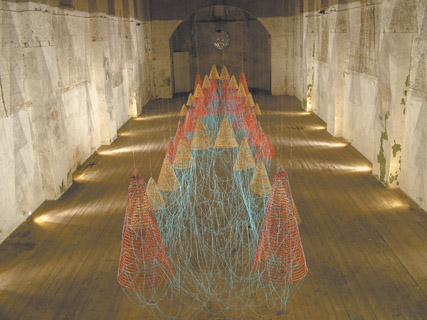
Anne Bean, Twelve Hundred Fathoms and Ashes
ON OCTOBER 29, 2004, ANNE BEAN DELIVERED A SHORT PERFORMANCE, CALLED YEARNINGS, TO A GROUP OF FIVE YOUNGER WOMEN ARTISTS IN LONDON. THE WOMEN HELD THE PERFORMANCE IN THEIR MEMORIES. THERE WAS NO DOCUMENTATION, THEY WROTE NO NOTES, AND THEY DID NOT DISCUSS IT.
On October 29 2005, one by one, each of the women, followed by Bean herself, re-created the performance—or what they could remember of it—to a small public audience, including myself, in the original venue. As the seasons have turned, I’ve continually found myself wondering how much of that performance might still remain with me. A year on, it’s 8pm on October 29 again, and time to sift through the residue.
Autumn came late that year, and the trees were more golden than ever I remember. Drizzly and dark, driving out that night. That big turquoise scarf draped round my neck, new and glorious on its first outing. Days before, I’d walked through the park in a red summer dress, but this was the evening the weather changed. Tonight the world is framed by warm woollen tassels.
The Yearnings performance had taken place as part of Reap, an expansive year-long collaborative investigation into the nature of time, memory and ephemerality, led by Anne Bean, in and around Southwark Park in South London. Throughout the complete cycle of that year, dozens of installations, actions, films and rituals charted patterns of growth and decay, accumulation and dispersal, absence and presence, memory and metamorphosis. Month after month, I had travelled across the city, to observe time’s transformations.
Months of cancelled trains, snarled traffic and lost ways. Tomorrow I’ll make the same journey yet miss Reap’s final firework: the clock that’s been counting backwards all year will explode without me. But tonight I glide through the city.
In the disused church at Dilston Grove, Twelve Hundred Fathoms and Ashes, Bean’s immense installation of slow-burning incense had hung from the ceiling in coiling red and yellow cones, interlaced with a web of thin blue threads. Smouldering continuously for a year, a glowing ember and a wisp of fragrant smoke counted off the days until nothing remained but curls of ash patterning the floor. Remember Me, a carpet of 5,000 apples, stayed stubbornly rosy for over half a year, until suddenly the fruit began to crumple. Briefly, the healthiest-looking apples revealed a hidden phrase, but then, as the rot took hold, the message slipped elusively back out of view. Meanwhile, that same line of poetry was being passed around the world for a year, being translated from language to language, stretched further and further from its origins until no trace of the source survived.
Repeatedly, Reap would reveal the unpredictability of time’s processes. Like recessive genes, long-abandoned words would mischievously reappear in the translation, the promise of meaning flickering in then fading out. One apple would scarcely wrinkle, while its identical neighbour collapsed in on itself in a frill of white mould. Count on change, and it throws back continuity. Expect consistency and encounter capricious shifts. In Yearnings, the materials offered up for testing were the human mind and body. Could a brief performance be successfully transported in a woman’s memory across 365 days?
They can close the tunnel under the Thames without warning, and you’ll never reach the other side. No second chance with live performance. So much uncertainty, always, chasing that moment. Catch the moment and hold it close.
In the traditions of oral poetry, or religious ritual, initiates learn through repetition. In Yearnings, however, the participants had just one opportunity to absorb the performance. Anne Bean was investigating not the capacity to memorise but the process of remembering.
I’m looking for a scout hut. What will a scout hut look like? So much anxiety, always, finding these scattered sites. Does the stress of site specificity heighten awareness and intensify experience? Stress, they say, can stretch time.
Alongside her award-winning solo career, collaboration has been a regular feature of Bean’s practice (one of her longstanding collaborative relationships has been with artists Richard Wilson and Paul Burwell, notably as the Bow Gamelan Ensemble).
Just as her work has responded to the everyday metamorphoses of natural phenomena—the weathering of stone, the melting of ice, the sudden shifts of shadows and sunlight—so Anne Bean has been drawn to the shapeshifting slipperiness of collaboration. Many of her solo actions have played with ways of affecting and distorting her own voice (filling her mouth with pearls, pouring honey down her throat, tampering with recordings). These vocal manipulations are analogous to the effect of collaboration on her artistic voice—allowing an idea to eddy in unexpected directions by diverting it through another person. Bean’s willingness to embrace the random interference of chance in all its forms is an extension of her belief that the artist can never be in full control of their work, since “time is an inescapable collaborator in all art and life.â€
That teapot! The biggest teapot you’ve ever seen, with two spouts. Two streams of tea, to fill double the cups, in double-quick time. A plate of madeleines, to aid recollection of temps perdu; and the Reap wine for later, bottled exactly a year ago, for drinking tonight. Six streams of recollection: Miyako Narita, Lucy Baldwyn, Lucille Power, Holly Darton, Meg Mosley, and Anne Bean. One performance poured into six vessels, exactly a year ago, for sharing tonight.
The idea for Yearnings evolved partly through a brief mentoring relationship Anne Bean had earlier had with those five participating artists. At the time, Bean had been both reflecting on the role of the older artist, and revisiting her own early work. In 2002, she agreed to re-do a live performance from 1973 for the Whitechapel Gallery’s A Short History of Performance. Meanwhile she recreated a further 30 actions that she’d first made between the ages of 18 and 24 (1969-1974) and performed them to camera (1996-2005). These “reformationsâ€, as she described them, she titled “shadow deeds†and showed in her zretrospective, Autobituary. But which was the shadow? The deed which existed a third of a century ago, fractured into a few black and white photographs, and the hazy testimonies of a handful of witnesses? Or the crisp colour footage of the freshly committed but copied act? Which was more authentic—a lifeless record of the original, or re-embodied experience?
Six faded photographs are propped along the wall. Quick snaps taken a year ago, the day the women met. Rain-splattered and sunburnt, they tell a deceptive story. Advanced in their disintegration: they seem relics of another age. Time has been tampering with the evidence.
The question of what remains is performance art’s most enduring dilemma. Is it possible to make work which transfixes its audience unequivocally in the here and now, but which still leaves something meaningful for posterity? Photographic documentation is no less subjective or untrustworthy than the recollections of witnesses. When the bulk of a video camera swoops down between the audience and the artist, it critically alters the tension/tense of the live event. This artist isn’t here with you, in the present; it says, she’s there with someone else in the future.
How many witnesses? Twenty-five perhaps, on the municipal stackable chairs—five placed in a circle, the rest clustered behind. Five of us beckoned to the circle. Between each re-rendering, we will shuffle and switch places, relinquishing the central vantage. Recollections from the circle so much more potent than when relegated to the rear.
Any performance will splinter into many independent co-existent realities. Like the biblical loaves and fishes, it can be sub-divided endlessly without diminution, and still serve all. Every audience member, every artist, every anecdote, every film frame, holds their own piece of that reality. Multiple and mutable, the truth expands, contracts and adapts, transformed by time and context.
Experience percolates through the cells of the body like water through limestone, changing and being changed. Memories, like apples, experience different rates of decay.
Six times the room descends into darkness as each woman takes her turn. In the gaps between, I sweep the floor clean of petals. Piecing together the past, some women have yearned for a colour, others a scent. Curls of pungent yellow chrysanthemum, or crushed red roses. In the dustpan I watch the remembered and the misremembered mingle.
Yearnings acted as a metaphor for memory, and the multi-directional communication of experience.
Beginning in darkness, a woman enters the circle, lights shining from her dress. Bare feet, long black dress, flowers from a basket strewn on the floor, trodden in until the scent releases. She turns to each witness, placing in their hands a wooden spindle wound with thread, and one of the lights from her dress. Lines of thread radiate from her. She turns, slowly, and the thread unspools, wrapping her in its web. Perhaps she speaks as she turns: her voice mixing with the gentle rattling of the unravelling spindles. Gathering pace as she spins now, the illuminated spindles are pulled violently out of grasp. For a few moments the lights hang free; are then extinguished; and darkness resumes.
With a look of intense concentration, like a child entrusted with a brimming glass of water, the first woman has allowed her memory to spill through her fingers. The performance is at its most condensed. She shrugs and flees. The next, enters, then immediately realises the flaw in her order of events—retreats, rethinks, restarts. Body memory has suddenly been re-activated, with its own overriding logic.
As version followed version, the pattern became clear. The performance’s metaphor, and the actions and symbols that carried it had survived. The words that were spoken had evaded recapture. A quirk diverted the pattern: Lucy Baldwyn, from the original quintet, was unavoidably abroad, and chose to write instead about her memories and send her friend to read them. Baldwyn was no nearer to reproducing the incantatory text Bean might have voiced, yet the delivery of her rich and poetic meditation redressed the balance of wordlessness in the evening overall. Together, the succession of reinterpretations formed a composite truth. The intensive inquiries of the intervening year had subtly redirected the focus of Anne Bean’s own thinking. A year on, even Bean was unable to sift for certain what might have been from what has been; the things she thought about saying from the things she decided not to say. Bean was not the gatekeeper to the memory. We all had a key.
Tomorrow we’ll return to the church for one last event. We’ll string together letters bent from glowsticks and spell out the phrase that had been hidden in the apples. ‘At the still point there the dance is.’ In glowing green letters suspended from helium balloons, a line from TS Eliot’s “Burnt Norton” bobs against the rafters of the church in darkness, before floating off across the dark city sky. “Anne,” I asked, surrounded by glowsticks and sellotape, “do you want me to make a full stop”, “Why not” she said. And the full stop drifted far away.
RealTime issue #76 Dec-Jan 2006 pg. 35
© Judith Palmer; for permission to reproduce apply to realtime@realtimearts.net
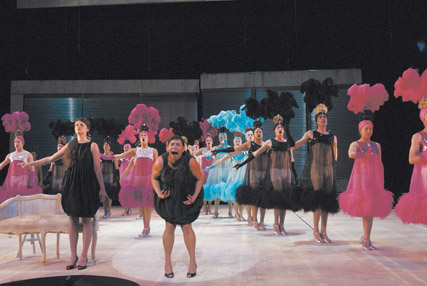
Amber McMahon, Deborah Mailman
photo Heidrun Löhr
Amber McMahon, Deborah Mailman
TO BEGIN AT THE END. IN THE SONG OF ORPHEUS, THE FINAL ACT OF THE BARRIE KOSKY-TOM WRIGHT THEATRICAL EPIC THE LOST ECHO, THE STAGE IS FILLED WITH BEDRAGGLED, EXHAUSTED FIGURES, MANY STRIPPED TO THEIR UNDERWEAR AND SEATED ON PLASTIC CHAIRS. TWO MEN IN BLUE BODY BAGS ARE NEAR DEAD, FROM TIME TO TIME TOPPLING TO THE FLOOR
We may well be in the underworld that Orpheus entered in search of his Eurydice and simultaneously immersed in the story of Narcissus (wrapped in photographs) and Echo (doomed forever to repeat the words she’s just heard), but mood and performance are predominantly embodied in a performance of Schubert’s Wintereisse song cycle. For the anonymous singers in this limbo of lost love there is no heavenly consolation for their sorrow, no gods to blame or to turn to, no sense-making cosmology. Schubert’s love madness is doomed to repetition and echo, lost in a romantic narcissism that will reverberate into the 20th century and the present as psychology. Nor is it now a young man’s angst, the lead being taken by an older man (Peter Carroll in superb voice and with bursts of mad energy) and then, in turn, the voices of all the key players, young, old, male and female.
The Act IV stage seems full of the ghosts (the many mythic roles these actors have played in The Lost Echo’s earlier acts) of ancient Graeco-Roman polytheism as told by Ovid. We have journeyed from creation, and its near undoing in the story of Phaeton taking on his father’s chariot of the sun, into a plethora of grimly funny and then dark, demanding tales. In Acts I and II gods, demi-gods and humans mingle and the line between humans, flora and fauna is easily traversed, as in many creation myths, in cruel or occasionally kindly metamorphoses enacted by the gods. In Act III, a version of Euripides’The Bacchae, an early rationalist and pragmatic stand is taken against women’s secret Bacchanalian rites with disastrous results for its politician instigator, Pentheus; but the seeds of doubt have been sown and a new order prophesied. And so, some six to seven stage hours after creation, we find ourselves in the eerie world of Act IV’s Wintereisse.
The grand arc of this journey, from polytheistic plenitude to its mere echo, is realised in a bravura display of story-telling techniques. Myth is the stuff of story-telling and Kosky and Wright structure The Lost Echo around ways of telling, often true to Ovid’s methods and spirit. For these tellings, the raked stage is essentially bare if frequently transformed by the deployment and choreographing of the Actors Company and a chorus of NIDA students, lighting, objects and huge concrete and glass rooms that come and go, hovering in the space. Most commonly tellers address the audience directly and action either emerges around them or absorbs them into it.
Act I is a wild, dense world populated with many figures, suited gods, strange boy-girl creatures with bloodied genitals and a mass of uniformed school children among whom is Callisto (Amber McMahon). The act begins with Teiresias (John Gaden), seer and once-upon-a-time a woman, as our narrator describing Phaeton’s near destruction of the world as he loses control of Jove’s horses who pull the sun across the skies, the disaster graphically evoking our own fears of environmental ruin. But engrossing plain telling soon expands into what Kosky describes in the program notes as “an erotic satyr-panto”, all movement, grimly funny farce and music—Coward, Cavalli (from his 17th century opera, Callisto), Kern and others springing out of tales as musical and theatrical forms meet seamlessly and magically metamorphose into 21st century hybridised theatre.
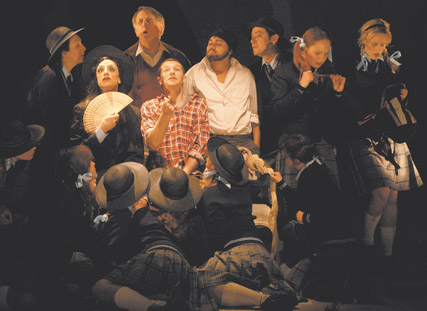
Paul Capsis (with fan), John Gaden, Dan Spielman, Deborah Mailman, Brandon Burke, Hayley McElhinney, Marta Dusseldorf, The Lost Echo
photo Heidrun Löhr
Paul Capsis (with fan), John Gaden, Dan Spielman, Deborah Mailman, Brandon Burke, Hayley McElhinney, Marta Dusseldorf, The Lost Echo
Kosky and Wright push Ovid’s transformations into our times, preoccupations and fetishes. When Jove disguises himself as Diana to seduce the young Callisto it’s as if exploiting a schoolgirl lesbian attraction—Jove transforms himself into an older schoolgirl, but she is played by Paul Capsis. Amber McMahon is superb as the eager, powerless, bewildered child trapped by manipulative adults including Pamela Rabe’s vengeful gothic cocktail queen Juno, all elegance a-totter, the actress executing a superb near fall when slipping on a puddle of semen. Callisto is punished for a sin not her own by being transformed into a bear, our sense of her sheer vulnerability heightened by her nakedness save for a cheap bear mask. Her final metamorphosis, a kind of redemption, is to become the Bear of the heavens, and the theatre fills with stars.
In Act II each telling of profound loss is very much the performance: the female speakers appear downstage, addressing us intimately but with action elsewhere producing a disturbing visual and thematic counterpoint, for example, an orgiastic mass of men in a glass-fronted room. Mostly we can’t hear them but, phalluses in hand, they will burst into song or dance. Hayley McElhinney as the suicidal Myrrha fatefully desires her father, Rabe as the nymph Salmacis rapaciously becomes one with Hermaphroditus, Marta Dusseldorf as proud Arachne weaves her portrait of the gods as brutal seducers and is turned into a spider by Minerva, spited goddess of weaving. In the final story, there’s a more layered telling. Procne (McMahon) tells of her sister (Deborah Mailman) Philomela’s plight, her tongue torn out by Procne’s husband after raping her. Philomela, by her side in an identical dress simultaneously signs the story, the lyrical dance of her hands increasingly desperate as we learn how the sisters kill Procne’s son and feed him to his father, and the gods benignly turn the sisters into birds. The stage now fills with birds of an altogether secular kind, the rest of the cast, male and female, as Las Vegas showgirls with high feather head dresses, glittering gowns and high heels in slow procession aptly singing Purcell’s “Remember me, but ah! forget my fate” from Dido and Aeneas. Our anthropomorphism is but an echo of ancient metamorphoses and kitsch becomes high poetry as Mailman’s silent scream visually pierces such aural beauty, Philomela’s pain undiminished.
In Act III Dan Spielman adroitly deploys curious speech rhythms and a quirky physicality to create an otherworldly Bacchus, drawing us into his tale which soon transforms into Euripides’The Bacchae staged in a toilet block and the only portion of The Lost Echo that approaches conventional theatricality. In a mix of argument, song and farce that climaxes in the bloody demise of the stiff, unyielding and suited Pentheus (Martin Blum), we encounter Tieresias (Gaden) and Cadmus (Peter Carroll) all frocked up. They could be off to the Mardi Gras, but it’s the secret Dionysian women’s’rites, taboo to men and extremely dangerous, with a deep cultural and spiritual appeal that appals the censorious Pentheus who would like women to simply sew, spin, work. Now the music is Bach, monotheistic, supremely orderly but equally complex, juxtaposed with Kosky’s settings of Ladino songs (Jewish-Spanish, echoes of kindred monotheisms).
<img src="http://www.realtime.org.au/wp-content/uploads/art/0/92_kg_lostecho_105.jpg" alt="Martin Blum, Peter Carroll, John Gaden
The Lost Echo“>
Martin Blum, Peter Carroll, John Gaden
The Lost Echo
Act IV takes us back into story-tellings, but the Wintereisse songs (with “Blame it on the Boogie” as antidote and some astonishingly vigorous dancing from the whole cast) do most of the work, Kosky describing them as “two dozen heart breaking postcards from a journey into exile”, a reminder too of the poet Ovid exiled from his beloved Rome for slighting imperial Augustus. Amidst the songs and Echo (McElhinney) and Narcissus’(Eden Falk) distress, Paul Capsis enacts another secular metamorphosis, drolly delivering cooking instructions to a bothersome caller, banal interruptions to exquisite miseries.
All this, and more! The Lost Echo was a rare and treasurable theatrical experience, a work of intelligence and aesthetic boldness on a scale rarely encountered in our theatres. Kosky himself was a palpable presence, playing piano and conducting throughout, visible in his prompt pit. There was committed and convincing singing and dancing from the Actors’Company (notably Carroll, Spielman and Capsis, outside his usual territory) and the NIDA students, and great performances—among the many: Mailman as a totally convincing blokey Satirino and the eloquently silent Philomela; all the women story-tellers of Act II (including Colin Moody as Beryl); Spielman’s Bacchus, Peter Carroll’s singer in Act IV and Pamela Rabe’s Juno.
If Acts III and IV don’t quite have the power of I and II (which could be re-staged as a satisfying whole) they nonetheless formally transform the thematic and aesthetic world of the first two, where polytheism is a given, into something more recognisably our own and, so, complete a great theatrical journey. Of course, it’s all ours, ancient and modern, part of our European heritage, but too much of it has become echo.
We might ask, however, what is more agreeable—the indifference of one God, the cruel antics of many, or lonely interiority? That aside, The Lost Echo calls up myth via Ovid to amplify its echoes and resonances into something palpable and contemporary. At a time when the warriors of the culture wars and anti-sedition legislation shut down civil rights, tearing out the tongues of dissent and difference, we should ask, as playwright Timberlake Wertenbaker does in The Love of the Nightingale:
What is a myth? The oblique image of an unwanted truth, reverberating through time…
Sydney Theatre Company, The Lost Echo, director, musical director, designer Barrie Kosky, translator, dramaturg, writer Tom Wright, performers STC Actors Company, NIDA 2nd Year Drama Students, choreographer Lisa O’Dea, co-designer Ralph Myers, costumes Alice Babidge, lighting Damien Cooper, sound design Max Lyandvert; Sydney Theatre, Sept 9-30
RealTime issue #76 Dec-Jan 2006 pg. 36-
© Keith Gallasch; for permission to reproduce apply to realtime@realtimearts.net
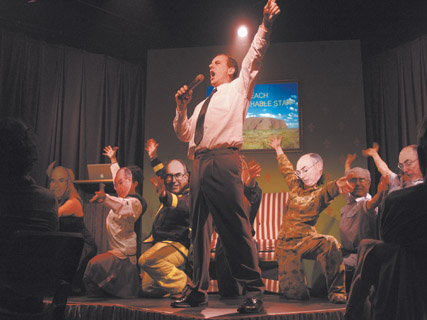
Tony Osborne, Ten Wonderful Years
photo Sandi Rapson
Tony Osborne, Ten Wonderful Years
TWO VERY DIFFERENT SHOWS ABOUT TWO VERY DIFFERENT AUSTRALIAN ICONS. BOTH CHALLENGING EXPECTATIONS AND IMMENSELY ENTERTAINING. THE ‘HEROES’ ARE NED KELLY AND PRIME MINISTER JOHN HOWARD.
In both instances I thought I knew what the performances would involve—the dramatisation of the well known aspects of Kelly’s life and a partisan sideswipe at the ‘achievements’, platitudes and hypocrisies of John Howard after 10 years in power. I should have known better: press releases alerted me to some promising aspects of both productions: Terrapin Puppet Theatre had negotiated the use of Sidney Nolan’s Kelly series with the National Gallery of Australia and Ryk Goddard, artistic director of is theatre, had just returned from a Churchill Fellowship working abroad with major figures in improvisation.
Whatever side of the political fence you sat on, you could enjoy the ‘theatre restaurant cabaret’ of is theatre’s Ten Wonderful Years (with a beer and a very good curry thrown in). The show comprised non-stop skits, the compere Tony Osborne tying it all together, sometimes with just a bit too much ‘are-we-having-fun’ enthusiasm. There was sexual innuendo, a deliberately silly and transparent magic act involving a woman in a bunny suit, a thought-provoking if a little laboured (pardon the pun) sketch about working for Labor and voting for Howard, and the astute Howard litany—‘alert but not alarmed’, ‘comfortable and relaxed.’ The show also featured the astounding Rotating Rhonda-Felicity Horsley twirling 10 symbolic hoops, keeping everything moving using some extraordinary arm moves while partially disrobing—nothing sexist, though! There had been a major competition prior to the show’s season to find a theme song for it—won and performed by the extraordinarily talented 17-year old singer-songwriter Alex Duncan with a fine voice and subtly ironic lyrics.
Terrapin’s The Legend of Ned Kelly was, of necessity, more cohesive, and no less interesting. Performers Gai Anderson, Clinton Barker, Laura Purcell and Sam Routledge sing and mime their way through the less familiar earlier stages of Ned Kelly’s life. Large scale puppets in the Nolan style, are used to great effect: Kelly’s mother complete with numerous babies seamlessly ‘born’ from beneath her skirts; two-dimensional near life-size figures in serried rows on moving frames, whirling across the stage as a posse of police officers. Against black tabs, seven large mobile panels fill the stage in various configurations in the unfolding of the story and provide screens for the digital projections (by Cazerine Barry) which extend the narrative. Poetry and text by Finegan Kruckemeyer and music by IHOS’ Constantine Koukias hit the right historical note and mood in an hour crammed with action and detail. Director Annie Forbes, cast and crew are to be congratulated on creating a strong, moving entertainment, suitable for youthful and older audiences alike.
In 2007, The Legend of Ned Kelly is touring to the Come Out Festival, Adelaide, May 14-18, Arts Centre Melbourne, May 29-June 1 and the National Gallery of Australia, Canberra, July 1-15 [Melbourne and Canberra dates to be confirmed].
is theatre, Ten Wonderful Years, Backspace Theatre, Hobart, October 3-7; Terrapin Theatre Company, The Legend of Ned Kelly, co-devisor, director Annie Forbes, co-devisor Richard Jeziorny, animation Cazerine Barry, composer Constantine Koukias, lighting Daniel Zika; Theatre Royal, Hobart, September 7 -11
RealTime issue #76 Dec-Jan 2006 pg. 38
© Diana Klaosen; for permission to reproduce apply to realtime@realtimearts.net
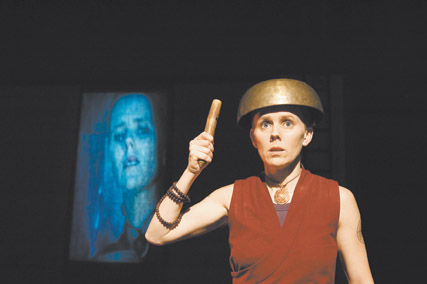
Stace Callaghan, Between Heaven and Earth
photo Juanita Broderick, Broderick Photography
Stace Callaghan, Between Heaven and Earth
STACE CALLAGHAN’S LATEST ONE WOMAN CELEBRATION SEES THE PERFORMER DRAW INSTRUCTIVELY ON HER RECENT ON AND OFF-STAGE LIVES. LAST SEEN ON STAGE IN ACTIVAT8’S THE KNOWING OF MARY POPPINS, IN A ROLE THAT SIMILARLY CAPITALISED ON CALLAGHAN’S UNIQUE PHYSICAL STAGE PRESENCE, BETWEEN HEAVEN AND EARTH TRACES HER FICTIONAL ATTENDANCE AT AN ENLIGHTENMENT TRAINING CENTRE: A “BOOTCAMP FOR YOUR SOUL.”
Hosted by Guru Frank, the first of eight characters to appear throughout the show, bootcamp is, Stace hopes, a place to meditate and reflect. It becomes, in fact, much more. Diagnosed as F.I.N.E. (Frustrated Insecure Neurotic Emotional), Stace is instructed to relinquish her “E.G.O” (Everybody’s Got One) and surrender to Frank’s advice because he’s the “G.U.R.U” (God, U Really Understand). Inoffensively accompanied by a church hall dance beat and armed with a dangerously elucidative talking stick, Frank comes across as a thinly veiled jab at the capitalisation of Enlightenment, but his direct address and ad-lib manner quickly set the tone for the performance to come.
Early audience involvement establishes what will become a familiar interactive convention for the evening. This is a show that is meant to move its audience, first literally, but ultimately, spiritually, and Guru Frank’s ritualistic interrogation of the L.A.T.E. (Lazy Ass Time Eaters) comers begins the process with audience members continually being drawn on stage throughout.
Stace’s journey for enlightenment begins on a wooden pallet that defines her meditation cell. After settling in to her task she is visited by religious figures St Hildegard von Bingen and then by St Teresa of Avila. Both women experience intense, physically altering encounters with their God and encourage Stace to continue in her search, mindful that one must be prepared to feel as well as listen. Marie Byles, the first female lawyer in Australia and Muriel Cadogan, the first woman to promote physical fitness in Australia, subsequently visit and each inspires Stace to persist through physical injury in the process of caring for her body. The intersection of the body with the spirit is an ever present theme of the show as Callaghan highlights the profundity of embracing an embodied spirituality.
Alison Ross’ peopled, yet practical, set design provided a utilitarian platform for Callaghan to communicate plainly and acutely with her audience. Under the cohesive direction of Leah Mercer, Callaghan’s unique performative and healing abilities have coalesced into a show that has come quite a way since its creative development.
Ultimately, Callaghan’s audience are encouraged to use the performance as the beginning of their own journey of healing. Stace manages to overcome the charlatanism of Guru Frank and does make some sense of her place in the Universe. This is an honest and charming performance that, while never quite following through on its barbs at organised religion, does present a compelling case for the continuing celebration of spiritual diversity.
Between Heaven and Earth, devisor, performer Stace Callaghan, director Leah Mercer, designer Alison Ross, lighting designer Clytie Smith, composer Robert D Clark, dramaturg: Shane Rowlands, Visy Theatre, Brisbane Powerhouse, Oct 10-14
RealTime issue #76 Dec-Jan 2006 pg. 38
© Neal Harvey; for permission to reproduce apply to realtime@realtimearts.net
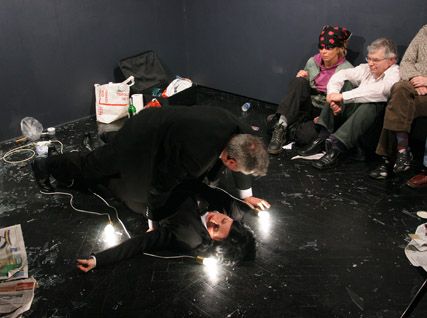
Wladyslaw Kazmierczak and Ewa Rybska, Sonne Statt Reagan
THE BARE, WHITE HALL OF THE EMPIRE STUDIOS IN LONDON RECENTLY HOUSED AN AMBITIOUS POLISH ART PRESENTATION ACCOMPANIED BY POLISH VODKA AND BEER.
There were three performances by four artists—Pawel Kwasniewski (London Tango), Karolina Stepinowska (untitled) and Wladyslaw Kazmierczak and Ewa Rybska (Sonne Statt Reagan). For those of us who don’t know much about Polish Performance Art, there was also a program briefly outlining its history and a talk on the subject the following day. That history may be shaped by independence and isolation, but the work in this presentation seemed haunted by relations with the outside world.
Kazmierczak’s enthusiastic program prose is a performance in itself—performative writing that exudes both enthusiasm about his subject and a distinctive, clipped-English voice. Performance art in Poland, he writes, “was for artists mainly a form of expression which sidestepped political censorship and did not lead to contention with the circles of vanguard and conceptual art.” Without the political freedoms of the West, Polish artists turned to performance as a way of escaping both the evolutionary thrust of dominant practice and the oppression of the censors.
Kwasniewski embodies capitalism and socialism, left-wing and right-wing. As a not-for-profit artist, he calculates the economic worth of his performance. He describes the steps that have lead him to the Empire Studios—the cost of his travel, his loss of work, his reputation and career—and punctuates each with two ping pong balls: “a little to the left, a little to the right.” The balls bounce merrily off in opposite directions, a metaphor for Kwasniewski’s life. By the end of the performance this scruffy middle-aged man has revealed himself to be a successful journalist and businessman, worth over four million pounds in property and assets. But his art, he reminds us, is not-for-profit. He cuts a square centimetre of his arm and wipes the blood onto his financial calculations. Nobody buys it.
Here is a united Europe’s dream—what successful integration, what seamless suture of East and West. For a London audience, Kwasniewski also questions a number of Polish stereotypes—is he really a media mogul? (Not a plumber?) By declaring his (real or imagined) economic worth he disrupts the conventional wisdom of an Eastern Europe under the spell of a wealthy and complacent West. He captures and redirects the gaze of economic history that underpins Western Europe’s relationship with the former Soviet bloc.
Stepinowska is not so lucky. Cutting her hair off, banging her head against a wall, eating carnations and drinking red wine until she is sick, she enacts the trope of heartbreak. Whoever has broken her heart is unknown, and irrelevant—the fact of her forced transformation is compelling enough. It’s clearly a profound and internalised loss, and one that descends into self harm. Unlike Kwasniewski, the emotional clichés in Stepinowska’s piece imply a generality to her state; in the context of the show, it’s tempting to read it as the state of Poland in modern Europe. Her earnest, but doomed, transformation is echoed by Kazmierczak’s description of Poland’s ‘trauma’ of exposure to the West after the fall of Communism in 1989.
As she leaves, Stepinowska takes the mirror, her reflection. Has she won back her identity after her body literally vomited in protest at the change? Or is she condemned to be defined by how others see her— from the outside in?
Completing the trajectory of political engagement, Kazmierczak and Rybska’s piece tackles international relations on a large scale. Their performance begins with them playing toy electric guitars with pious enthusiasm, and ends with rubbish and firecrackers being chucked onto the stage. Kazmierczak wears glasses with the lenses whited out, and two crucifixes like black clown eyes, painted on. They place cards at the front of the stage detailing Iraqi civilian deaths since the ‘allied’ invasion.
Kazmierczak and Rybska’s demented, anarchic protest has both the US and Christian Imperialism in its sights—huge targets that are matched by their depth of angry feeling, but not their power. Their impotence could be speaking from within the notorious phrase, “You forgot Poland.” (George W Bush’s retort to John Kerry after the Democrat belittled the strength of allied forces; liberal US media was quick to suggest that Poland didn’t count for much.) Even their reference to Joseph Beuys’ “Sonne Statt Raegan”, the famous artist’s pop song against Ronald Reagan’s arms policy that plays in the background, seems outdated and strained.
While this piece dramatically asserts Poland’s place in the world—both as participant and protestor—it also dramatises its ineffectiveness. Emotions are delineated by other cultures—a German song, images of US presidential history—and the artists’ expression reduced to infantile tantrums.
It seems characteristic of the struggle for the voice of Polish performance art that it will be defined in these terms—the infant brother in the shadow of a better established cultural tradition. Kazmierczak cites RoseLee Goldberg’s famous tome on performance as both a model for a Polish history and a paradigm that’s difficult to escape. Perhaps that is why Kwasniewski’s piece seemed the most successful: personal and intimate, it doesn’t extrapolate Polish sentiment to an unrealistic scale.
But it is simplistic to chart these works as emotional points on a map of Polish relations, just as it is anachronistic to imagine a British audience will fulfil or remain within the boundaries of Polish cultural understanding. (Does Kwasniewski know about Polish plumbers? How many UK viewers will understand a German song?). And yet the presentation is shaped by the responsibility of Polish history and relations. Curator Beata Dudzic says that the show was inspired by “thousands of Poles coming to England seeking jobs”, and Kazmierczak wants the program to serve as an “introductory monograph of Polish Performance Art.”
In the end, it’s the scale of these aspirations that undermines each individual piece: successful on their own, they buckle under the weight of representation. Kwasniewski stands the tallest, redirecting the assumptive gaze and asserting his independence. Poland’s isolation is over, and compromises will be made—Kwasniewski, at least, makes them on his own terms.
Polish Art Presentation, curator Beata Dudzic Empire Studios, London, Oct 28
Kazmierczak and Rybska will appear in NRLA 2007, see p44
RealTime issue #76 Dec-Jan 2006 pg. 39
© Mary Paterson; for permission to reproduce apply to realtime@realtimearts.net
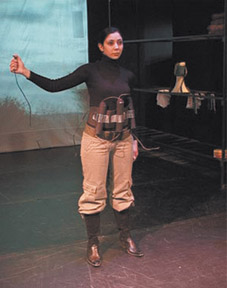
Bayan Shbib, Safad-Shatila (Vice Versa)
The world is developing and changing every day and our responsibilities do not allow us to let our life remain the way it is. We cannot change however, without dialogue, by opening up to the other, defying isolation and rejecting silence.
Farouk Husni, Minister of Culture, Egypt
I WAS ON THE JURY OF THE 18TH CAIRO INTERNATIONAL FESTIVAL OF EXPERIMENTAL THEATRE, ALONG WITH 10 ARTISTS, PRODUCERS, CRITICS AND ACADEMICS HAILING FROM MANY COUNTRIES—MOROCCO, MEXICO, CHINA, GERMANY, RUSSIA, EGYPT AND OTHERS.
A government sponsored event, in a great international city, the festival featured 62 works from 47 countries. Each company registers to participate and raises its own resources to present their work in Cairo. Once there, works are shortlisted by an international Viewing Committee into the ‘official’ and ‘fringe’ parts of the event. The 25 works in the official program are part of a competition for a range of awards—best performance, direction, scenography, ensemble, actor and actress.
Every night, we were driven in convoy to a series of venues across the city. We’d arrive and be ushered into the first few rows of the theatre to watch works from Libya, Palestine, Iraq, Lebanon, Ghana, Japan, Bangladesh, Croatia, Uzbekistan and others. If the performances were in Arabic, our interpreters would simultaneously translate the text into the first language of the jury member. The hubbub created by the translations joined the general noise of the space—the sound of mobile phones ringing and being answered, people coming and going and discussing the work throughout. The theatres, during the festival at least, are lively social spaces.
The work we saw was incredibly diverse, formally, technically and aesthetically. From the simple storytelling theatre of Ghana’s Abibigroma Theatre Company, in their joyous fable The Story Aranse Told, to the overwrought incoherence of King Lear As A Sufi by The National Theatre of Jordan. From the visceral physical ensemble work by the all male cast of the Russian company Moon Theatre’s Romeo and Juliet to the intense vocal ensemble work by the women in the Armenian Experimental Group’s production of 4:48 Psychosis by Sarah Kane. And from the austere representation of rural life and courtship in Uzbekistan’s Bukhara Puppet Theatre’s When Stars Are Lit to the intricate mediatised scenography in the Japanese company Chiten’s production of The Crucible.
Given Western neo-colonial ventures in the region, the ongoing violence in Palestine and Iraq and the recent July war in Lebanon, it wasn’t surprising that representational forms exploring issues of violence, war, forced migration and grief dominated the Arab works in the Festival.
Nisaa’ fil Harb (Women in Wartime), by the Iraqi National Theatre focused on the experiences of three women displaced by war and terror, seeking asylum on the borders of Germany. Rithaa Al-Fajr (Lamentations at Dawn) by Mazoon Theatre from the Sultanate of Oman was a dialogue between the ghost of a dead warrior and his grieving widow.
More complex and controversial works were presented by the Palestinian Ashtar Theatre and The Experimental Theatre of Syria.
Safad-Shatila, Vice Versa, is a solo work by Bayan Shbib for Ashtar Theatre tracing a young woman’s decision to counter violence with violence. One Palestinian woman’s loss of home and country, during Al Naqba in 1948, merges with another’s loss of her husband and family during the Shatila massacre in Lebanon in 1982, prompting a response that grief is futile and only direct action is viable.
Written and directed by Jawad Al-Assadi, Hammam Baghdadi (The Bath of Baghdad) is a sophisticated and devastating work. It’s set in a public bath-house in Baghdad where the competitive relationship between two brothers, who drive trucks between Amman and Baghdad, is played out. They share horrendous stories of finding a mass grave, playing football with the severed heads of the enemy and trying to avoid violence only to stumble into more. Textual references to, and physical actions of cleansing, spiritual purging and burial rituals merge with the imagery of the city as a blood bath. Saddam’s reign of terror melds seamlessly with the terror of the American occupation in The Experimental Theatre of Syria production.
The diversity of work in the festival prompted many debates among audiences, the Jury and in The Experimental, the daily publication of the festival. Just what does ‘experimental theatre’ mean across east/west cultural contexts? Is it useful, indeed possible, to compare work from first and third world economies and from countries where contemporary practice has been institutionally supported for generations and those where it is not? Isn’t it disingenuous to present (and judge) what are ostensibly subversive practices in Egypt in the context of the government’s patronage?
This final paradox and the absence of independent artists around the festival, prompted me to visit Townhouse Gallery, an independently run arts space in the back streets of Downtown Cairo.
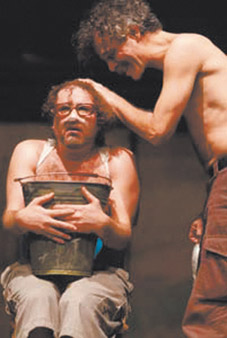
Fayez Qozoq & Nidal Al-Sigary, Hammam Baghdadi (The Bath of Baghdad)
It’s in a poor area that’s dominated by tiny engine repair shops. The locals in the surrounding streets welcomed us with pride, knowing we must be in the neighbourhood to visit their arts centre. They took us to the beautiful old building that had been abandoned in 1956. The genesis of the centre, established in 1998, has been totally connected with the lives of the locals, who have renovated the building and continue to work, play, visit and pray in the space daily.
It’s a great story of community interactivity, lateral business planning, arts and audience development. It emerges from the social context of poverty and working children alongside the cultural context where artists are subject to censorship and an official expectation that phaoroanic culture and its imagery is the most legitimate representation/content for Egyptian art.
Townhouse programs are a mix of contemporary arts development and presentation, community development and business training. They include participatory programs, open access spaces, exhibitions and events. They have street front galleries, a library, rehearsal and residency spaces and are in the process of developing a new space for live performance. They host a range of international artists each year whom they invite to interact with and respond to their part of Cairo. High profile initiatives include: Photo Cairo, an annual regional photographic survey show and symposium and the Open Studio Project hosting process-based projects with local and international sound artists.
The government, media and art schools have ignored or attempted to blacklist Townhouse, but international foundations, development programs and businesses have funded to the extent they have 22 staff and are expanding their programs each year. All this operates alongside the policy: “all decisions are made in conjunction with our neighbours.”
Minister Husni’s call for dialogue informs not only his prestigious Festival of Experimental Theatre but is enacted here in the back streets of Downtown Cairo in an everyday, potent and politicised way.
RealTime issue #76 Dec-Jan 2006 pg. 40
© Fiona Winning; for permission to reproduce apply to realtime@realtimearts.net
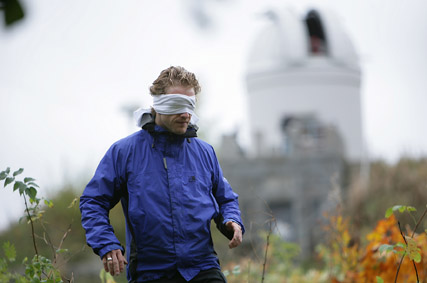
Howard Matthew, Terrestrial
photo Pekka Makinen
Howard Matthew, Terrestrial
STRIDE UP MINNA CANTHIN KATU TO THE SITE DESCRIBED AS THE “BALCONY OF THE CARSLON DEPARTMENT STORE.” AN EMPTY, INACCESSIBLE BALCONLY SPACE; ITS ORNAMENTAL NON-FUNCTIONALITY AT ODDS WITH THE FUNCTIONAL POLITE MODERNIST STYLE THE BUILDING EMPLOYS. THIS IS NOT A TRAVEL GUIDE TOUR OF THE SITES OF KUOPIO; I AM FOLLOWING THE ANTI-CONTEMPORARY ART FESTIVAL MAP IN ORDER TO LOCATE NOT JUST ANY SITE BUT THE SITE OF MY SITE-SPECIFIC WORK.
It is this vacant space that I had committed to ‘fill’, both with activity and with cardboard boxes over the period of the festival; did the proposal equate with the brochure’s introductory suggestion, that the works would “seek commitment to a site and a certain situation”?
Now in its fifth year, ANTI continues to alter its physical character through a program that each year occupies numerous very different sites in this Finnish lakeland town. This time around, in addition to the balcony, works also inhabited the city hall, a tennis court, an observatory, a youth centre, a hotel, a cinema, the airport, the university, an apartment, an office and an empty property. By occupying these sites the artists appropriated them for new purposes, whilst Kuopio’s inhabitants continued to use these spaces and the extended matrix that connects one to another. On a basic level, this dual usage of public space amounts to “an imprint on Kuopio and its inhabitants” but what kind of imprint? By and large the sites were mediated by the ANTI organisation, with artists having never been to Kuopio, never mind having haptically engaged with their chosen site.
A discussion of the problematics of site-specificity is of course commonplace. The ANTI introduction itself references Miwon Kwon’s One place or another, site-specific art and locality (London and Cambridge, Mass: Massachusetts Institute of Technology, 2002), in relation to the festival’s own ongoing attempts to integrate into Kuopio and the life of its citizens. The term ‘site-specificity’, Kwon suggests, has been replaced by an array of novel terms, which include site-oriented, site-responsive, context-specific or socially engaged. In relation to particular works, and approaches, the list could also include type-specific, kind-specific, sort-specific….
Of course, each work has its own specific take on this growing list, some more apparent than others. In Howard Matthew’s Terrestrial (UK), this is one of a number of concerns that are addressed, head-on, through the CD monologue that accompanies and chronologically frames our ‘one-to-one’ encounter with the artist: “Terrestrial is a piece that I’ve performed across the world. As a site specific performance the content has been re-worked to respond to each respective site. But increasingly I’ve found it more problematic to respond to a site I know little or nothing about prior to my arrival.” This awkwardness seems physically manifest as Matthews stumbles, blindfolded, in expanding circles around the perimeter of a small hill, on which sits an observatory. Hands outstretched, using all four limbs to find his way, as though using these bodily mechanisms to feel around questions such as, is performance “still a tool I could use to articulate my feelings or explore and meditate on issues”
Each person watching, and listening, to these intertwined concerns does so through the opening in the observatory dome, focused on an exploration of where the work is positioned, as much in relation to the festival and the artist’s own practice, as much to physical site. Using a telephoto lens to track Matthew’s stuttering perambulation involves manually winding the observatory dome and clumsily repositioning the camera tripod in order to take our instructed one shot. This act of watching brings into question our relationship to his predicament; should we be watching as he stumbles at this juncture, both physically at the base of the observatory and metaphorically as he questions his own practice.
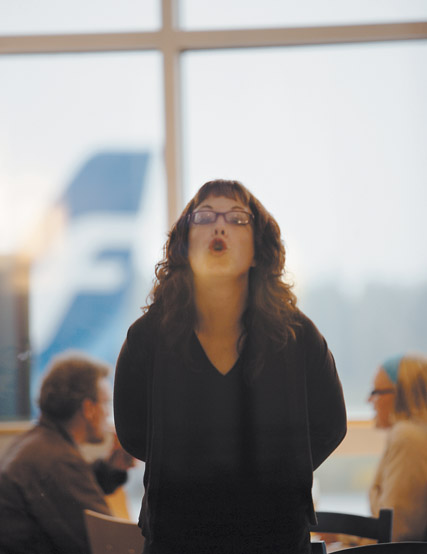
Aileen Lambert, Breathe
photo Pekka Makinen
Aileen Lambert, Breathe
This dilemma over my own viewing position carried across to Aileen Lambert’s work at the airport. Situated some 17 km away meant catching the bus and the driver’s quizzical look when I requested a day return only heightened a sense of being out of place. In hindsight and given more time, I would have spent the day at the airport, read a book, done something else, and waited to see if I noticed the work. Instead I was there on time, waiting for the performance to start, to experience the work. A similar effect had been noted in relation to my work on the previous day, as a string of people followed me along the street: a particular type of audience functions as a big arrow pointing out the ‘art.’
Strolling around the tiny airport, Lambert hones in on the desired glass surface, leans forward, hands behind her back, and goldfish-like exhales onto the partition that separates her from those inside. This simple gesture, repeated time and again, mirrors the festival’s own desire to leave its mark, but creates only a series of ephemeral traces. This intimate relation between the artist’s body and the skin of the airport is in stark contrast to the environment as the departing passengers are processed and leave without forming any kind of bond, or direct engagement with place. Lambert’s is a vain attempt to reclaim something of a personal relation from what remains, on the whole, an ungenerous non-place.
By adding a social dimension to the various spaces that artists occupy, there is the potential to transform places into situations. This notion quite aptly pertains to a festival such as ANTI, where the negotiation of the work is as much down to experiential circumstances as to any specific presentation: travelling from site to site by foot; a chance meeting with others; accepting an invitation into a home to hear a series of resonating trial tones that would otherwise have gone unheard; arriving only to see the performer exit, leaving you in an empty cinema, the used props littering the floor and the smell of popcorn lingering in the air.
Cognitively, these situations can only be grasped from where we stand, from our own personal experiences of them. My participation in the festival, walking repeatedly up and down the grid of streets that make up the town, allowed a wealth of time to perceive its inhabitants. On the one hand I passed numerous people, ANTI brochures in hand, searching out the various works; on the other I was involved in ongoing relations, where what we were looking for was less clear, and there was no brochure to guide us. I passed one small shop numerous times over the four days, and each time, without fail, a man watched from the window. This is by no means the type of “local encounter transformed into long-term commitments and unretractable social marks” that Kwon appeals for, but it is a form of acquaintance that the situation allowed.
ANTI – Contemporary Art Festival, artistic directors Johanna Tuukkanen, Erkki Soininen, Kuopio, Finland, Sept 28-Oct 1, www.antifestival.com
RealTime issue #76 Dec-Jan 2006 pg. 41
© Niki Russell; for permission to reproduce apply to realtime@realtimearts.net
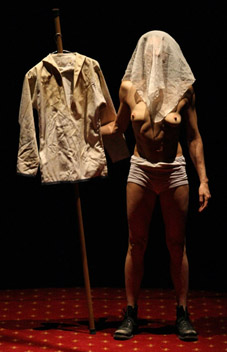
Jo Lancaster, Acrobat
photo John Sones
Jo Lancaster, Acrobat
IT’S BEEN A LONG TIME SINCE WE’VE SEEN ANYTHING FROM ACROBAT, THE BRILLIANT BUt UNLUCKY TROUPE THAT WAS LAST SEEN IN AN EPONYMOUS SHOW AT THE 2004 MELBOURNE INTERNATIONAL ARTS FESTIVAL.
It was during this season that Jo Lancaster, co artistic director with Simon Yates was struck down with such violent morning sickness that she was virtually unable to perform, leaving the show only 40 minutes long. It was still celebrated, despite obvious and glaring holes—the tumbling routine at the end in which Simon Yates heroically performed line after line with no respite for example.
Acrobat announced during that season that they were folding. So it was ironic that next May the company was awarded $30,000 by the Sidney Myer Foundation. Since then we have only seen Circus Ole, a fabulous collaboration with The Snuff Puppets.
So we were very much looking forward to seeing Smaller, Poorer, Cheaper, Acrobat’s latest offering at The Melbourne Fringe Festival. To write this article I’ve interviewed Mike Finch, Teresa Blake and Karen Hadfield.
Smaller, Poorer, Cheaper is essentially three solo pieces: Jo Lancaster on difficulty and motherhood; Mozes in an extended exploration of disease and toxicity; and Simon Yates finishing. As with all Acrobat shows, the skills are primary and performed at a very high level. I began by asking if the show had an underlying theme or cohesiveness.
Blake says of the show, “All of the pieces have a simplicity and an artlessness. It’s a very essential show. It feels like each of the performers doesn’t actually have to do as much as they do. There seems to be hardly any attention to transitions. It isn’t very sophisticated theatrically.”
Simon’s slack wire routine really sticks out. It has a Flying Fruit Fly or Circus Oz aesthetic (Simon has performed in both, and the act was created during a stint at Circus Oz), a sort of goofy, full scenario. It’s been performed a lot so it has a polish that the rest of the show doesn’t have. People have commented that Acrobat would benefit from using a director. But maybe it is this ‘artlessness’ that is their appeal. Maybe a director or a more sophisticated dramaturgical approach would lose something.
I ask Finch what the performers wear. “Not much”, he says. Acrobat’s aesthetic has always been functional. It could be described as a non-aesthetic. They don’t dress up the tricks, they strip their routines back to essentials. Costuming in this show is virtually non existent. Jo begins naked, sniffing through a pile of undies until she finds a pair to wear that smell the least (we assume, and hope). Mozes is also nude for a lot of the time. Apparently the roller skating brings to mind Helpmann’s comment about male nudes in ballet: that you can’t get some bits to stop when the rest does. Simon begins in undies and dresses himself in a suit on the slack wire, his much loved routine, which while largely unchanged manages to convey something new in this context.
So a lot of the visual information of the show is about the body. Jo’s body shows us the results of having two children and constant, demanding training. It is sinewy and hard, like a farm worker’s body, says Teresa.
Mozes finishes his solo with his Blood Rope act. The rope begins to drip and then pour blood down his body as he contorts and entwines himself in it. This is about the inside of the body coming out, the way disease can become primary, can hold a body hostage.
Simon uses a repetitive handspring drill as a study of limits and endurance. He handsprings onto a table, then raises the surface by a centimetre and does it again, and again, and again until the height defeats him.
Both Jo and Mozes do a swinging trapeze act. The same skill, fairly similar acts. This doesn’t seem to worry or tire the audience, who are instead interested in the different executions of the same skill. Jo strips it of performativity, preferring to let the moves speak for themselves. Mozes is a consummate showman complete with compliments and flourishes. And then Simon brings the trapeze down too. But instead of a trapeze act he sets a rope loop and, surprisingly, does a back ‘sault to toe hang in the loop. This is a trick you don’t see often. Well, it’s quite difficult and is over so quickly…I suspect that the “bang for buck” quotient seems too low for a lot of performers. But then this is Acrobat and they’ve never been very interested in the “bang” anyway.
I asked Karen for her favourite moment in the show: “Jo holding a vacuum cleaner to her breast to show how it feels sometimes to be a mother. All the information came together. The look of her body, the difficulty of the tumbling (she does a tumbling routine wearing heavy boots).”
Teresa mentions that “Simon does Jo’s hair for her before she goes onto the swinging trapeze. This simple act is incredibly moving. It gives us a glimpse into their relationship. It speaks of a couple even though they perform solo. It speaks of interdependence and loyalty and, I suppose, love!”
Mike describes Simon “desperately struggling to do circus by himself. He drags on a large boxer’s punching bag. It looks almost heavier than he is. He hangs it from a snapshackle and drops a plumb bob underneath it. He painstakingly sets up the teeter board underneath that. When he is satisfied that everything is correct, he stands on the other end of the teeter board and pulls the snapshackle open, dropping the bag and pitching himself into the air.”
I ask, “Was it sad?” Mike says, “No! It was funny! And heroic!” Teresa agrees, “Heroic is a good word.” I suspect that it was sad though, underneath. Sad because the performers don’t work together. Sad because it’s so tough. Sad because even though they seem to conquer adversity, to triumph through sheer physical prowess, the adversity is always there.
Apparently Acrobat already have some European work lined up for this show. I hope that luck goes with them this time.
Acrobat, Smaller, Poorer, Cheaper, Arts House, Meat Market, Melbourne, Sept 21-Oct 1
RealTime issue #76 Dec-Jan 2006 pg. 42
© Anni Davey; for permission to reproduce apply to realtime@realtimearts.net
BALI IS AN ISLAND EMPTIED OF TOURISTS. THE BOMBINGS OF 2002 (REPEATED THREE YEARS LATER) WERE THE CATALYST FOR THE FIRST UBUD WRITERS AND READERS FESTIVAL IN 2004.
As the island commemorated both terrifying events this October, it also welcomed visitors to this year’s Writers Festival. On the night we left Bali, we were among a handful of guests in a large, old hotel not far from the bombsites; stray dogs and skinny cats prowled through the empty tropical grounds.
A tribute to Indonesia’s most famous writer, Pramoedya, who died earlier this year, opened the 2006 festival. His life spanned Indonesia’s turbulent 20th century, from Dutch colonialism to Japanese occupation, the battles for independence, political purges, the corrupt rule of Soeharto—who kept Pramoedya in prison throughout his 35 years of power—and the recent democratic elections. Shameful events in a country’s history have a way of reappearing. During the week of the Writers Festival, the Jakarta Post referred almost daily to the events of 1965 when up to 2 million people were disappeared or murdered in Indonesia in an anti-communist putsch.
The festival was an opportunity to hear Indonesian writers, poets and intellectuals (Goenawan Mohamad illuminated the work of Pramoedya; Acep Zamzam Noor, Nirwan Dewanto, Linda Christanty and Ketut Yuliarsa are poets and writers to seek out). Writers, many of them South-East Asian, attended from all over the world: Sri Lanka, Pakistan, Malaysia, Britain, Canada, Singapore, Hong Kong and Australia. We heard about the relationship between modernity and Islam, the future of Asian literature, and the relationship of writers to the places in which they find themselves—so often, in a globalised world, places they call home. These writers are featured in the Autumn 2006 edition of the Asia Literary Review.
The Bali bombings have made the once ubiquitous tourism a rare commodity; the searing events have created a new focus for traditional dance (legong), music (gamelan), shadow puppetry (wayang kulit) and performance poetry on the island. As you watch you’re struck by how artists and performers are using their work to comprehend events, inventing new forms to express change. In Bali, writing is an art connected to all the other arts and to all the senses; only in Ubud would a writing event integrate all the manifestations of culture.
The highlight was Wayang Kulit on Skateboards. The dozen shadow puppeteers used adapted skateboards to shimmy smoothly back and forth behind the giant screen, lit by a video projector, subtly changing scenes provided by a power point display. Along with the traditional characters of princes, villagers and Balinese mythical figures, we saw soldiers, a petulant tourist and two quaking kangaroos. The story, performed in Indonesian Bahasa with English bits thrown in, included allegorical references to the cataclysmic bombings and ironic commentary about the relationship between Indonesia and Australia. Accompanied by a gamelan orchestra, the performance communicated sharply and sometimes hilariously, even to those of us illiterate in Bahasa. Made, the director/voice of Wayang Kulit on Skateboards is planning a collaboration with Australian hip-hop performer Morganics, another guest of the Ubud Writers Festival, on The Tempest. That’ll be worth a trip to Ubud.
A need to protect the openness and tolerance of Balinese culture was the impulse for the closing night celebrations, held in the opulent baroque grounds of the late, self-aggrandising expatriate Spanish artist ‘Don’ Antonio Blanco. Balinese playwright Putu Wijaya performed a riveting tale of a caged bird set free, despite protest by his old loving master, only to be devoured immediately—an allegory for the dangers facing his country’s fledgling democracy. The most spectacular performance of the night featured girls and women iridescently costumed, combining traditional southern Indian traditional dance with Balinese legong.
As the visiting London-based Pakistani writer Ziauddin Sardar (Why the World Hates America) commented, “We write to ensure our culture survives, that the culture and knowledge is passed on; we write our culture alive.” There is a deep pleasure in being part of a community that is passing on traditions to the next generation, connecting tradition to the present and bringing the present to life.
RealTime issue #76 Dec-Jan 2006 pg. 42
© Cassie Plate; for permission to reproduce apply to realtime@realtimearts.net
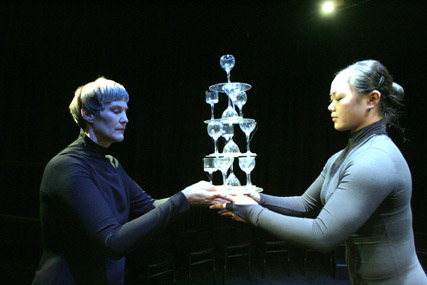
Rose English, Ji Maoling, Ornamental Happiness
photo Alastair Muir
Rose English, Ji Maoling, Ornamental Happiness
PICTURE A JEWELLERY CASE: A SMALL CIRCULAR BOX EXPENSIVELY LINED WITH BLACK PLUSH; AND DISPLAYED IN THE CENTRE AN IRIDESCENT PIECE OF EXQUISITELY CRAFTED SPARKLE. THIS IS ORNAMENTAL HAPPINESS, THE LATEST PIECE FROM ROSE ENGLISH, WHICH PREMIERED ON THE OPENING WEEKEND OF THE 2006 LIVERPOOL BIENNIAL.
An intimate 25-minute confection for a maximum audience of 50, Ornamental Happiness, is allegedly an hors d’oeuvre for a much grander show planned for 2008, when Liverpool becomes European Capital of Culture.
Tantalised by the scent of fresh deep-pile carpeting, English’s audience at the Unity Theatre queued behind velvet drapes before being ushered to the close-set rings of seating surrounding a circular podium. Here, a pair of Chinese acrobats (Ji Maoling and Lu Dan) proceeded to move through a succession of graceful contortions, poised on top of one another, whilst simultaneously balancing pyramids of cocktail glasses on the tips of outstretched toes. In each dainty glass hung a tiny bead betraying each subtle tremor in the near-stillness of their taut bodies with the shiver of delicate tinkling. From the edges of the curtains, came the occasional voices of singers, and a steady supply of ever-more vertiginous trays of glassware. For the final pose, glasses on foreheads were joined by curvy, transparent candelabra affairs clenched between the ladies’ teeth, as the podium gently rotated.
Rose English herself—the performance diva once renowned for her eye-popping sequinned showgirl costumes and luxuriant eyelashes—merely padded in stockinged feet, in demure matronly black, appeared on the perimeter of the action from time to time, serving up another round of tinkly balanceables. A peripheral, unspeaking figure, she’s reduced here to stagehand. English’s work, whether in solo performances or extravagant theatricals, has always engaged with the thrill and artifice of spectacle. Skilled aerialists, contortionists, tango dancers and Olympic ice-skaters have swung, sashayed and swooshed around her, whilst English has spun her humorous philosophical riddles and verbal pirouettes. In her 1988 piece Walks on Water, a stuntwoman leapt dazzlingly through hoops, whilst star-of-the-show English comically lapped up the applause. “I don’t want to be an acrobat anymore…I want to be a comedian”, the unsung heroine had lamented. Something of the irony of Walks on Water (the star couldn’t—and got wet) is mirrored in the title of Ornamental Happiness. Rapt in their concentration, the Chinese duo may provoke happiness in their audience but they fail to embody it themselves. Silenced by their shimmering mouthpieces, these women, however skilled, are ‘mere ornament.’
The memorable and mesmerising sound of that delicate crystal clinking, remains beautifully haunting. Ornamental Happiness is a celebration of the purity of unadorned performance, and the capacity for its essential spirit to resonate within us; yet the gagging of its protagonists leaves a quiver of unease.
Liverpool Live (the Biennial’s 4-day “festival of urban apparition”) played with the notion put forward by Manray Hsu, Taiwanese co-curator of the 2006 International, of ‘Archipuncture’, or urban acupuncture. Live artists were scattered around the streets on the premise that strategically placed artistic interventions might help release blocked energy flows and heal the ailing body of the city.
Action Hero’s To My Island offered safe passage under flyovers and across busy roads in search of ‘a place to call our own’: the eventually unreachable promised land of a petunia-planted traffic island. Kazuko Hokhi (Evidence for the Existence of Borrowers) wandered bewitchingly around the back corridors of the Parr St recording studios, revealing ingeniously constructed objects (including a fully functioning teaspoon guitar) made from rescued everyday detritus, as if by the tiny folk in the children’s novel.
Bound by a large piece of white elastic, the groups in the care of Gustavo Ciriaco and Andrea Sonnberger were led on a long ‘silent walk’ through shopping malls, back alleys and cathedral gardens. Loosely confined within the elastic, the participating walkers moved amoeba-like through the city, sometimes bunched up tight in a long shuffling snake, sometimes spread amblingly wide, as the roadplan dictated. Part individual, part organism, we took up simultaneously more and less space than we’re used to, jammed up close to our fellow walkers, yet distanced from the Saturday morning shoppers around us. Here Whilst We Walk (which has also trailed through Rio, Lisbon and Madrid) offered a strangely altered spatial sense of the city, a shifting dynamic of shared perception and an accentuated sense of the present.
Joshua Sofaer presented a sly critique of the ‘look how many nations we’ve got represented’ tendency of international art biennials, in a piece that stole Liverpool’s Capital of Culture slogan: World in One City. Slick in his pinstriped suit, Sofaer whisked groups around the Tate Gallery in the style of the curator-led tour. With wickedly well-observed gestures and tone, he introduced each of the works in a persona reflecting the perceived nationality of the exhibiting artist. Juggling stereotypes, Sofaer morphed from voice to voice, speaking in made-up languages. His perfectly honed gibberish, sounded convincingly like Japanese, Arabic or Australian English, but was empty of all meaning; reflecting the reductive absurdity of gallery labels which present singular views of each artist’s complex cultural identity.
Liverpool Live 06, A Festival of Urban Apparition, Bluecoat Arts Centre & Liverpool Biennial, Liverpool, UK, Oct 26-29
www.bluecoatartscentre.com/liverpoollive; www.biennial.com
RealTime issue #76 Dec-Jan 2006 pg. 43
© Judith Palmer; for permission to reproduce apply to realtime@realtimearts.net
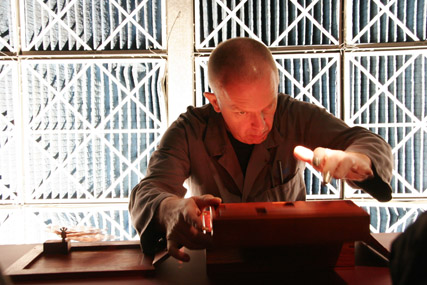
Fritz Hauser, Schallmachine 06
photo Phil Chung
Fritz Hauser, Schallmachine 06
LEGENDARY SOLO PERCUSSIONIST FRITZ HAUSER’S MODEST INSTRUMENTATION COMPRISED SOME SMALL CYMBALS, A SNARE DRUM, two SMALL GONGS, AN ORCHESTRAL BASS DRUM AND A FEW HAND-HELD THINGS TO SHAKE AND RATTLE. THIS SET UP IS SIMILAR TO THE ROCK OR JAZZ DRUMMER’S KIT, THOUGH FOR HAUSER IT IS AN EXTENDED ARRAY—HE HAS BEEN KNOWN TO PERFORM ON A SINGLE DRUM.
Hauser was a central figure in the music program for this year’s Melbourne International Arts Festival, and he gave an additional concert in response to popular demand.
The performance begins with the nearly inaudible but sensuous touching of a seed pod. As he shakes the pod with one hand, he begins to touch a cymbal with the other, developing a quietly droning harmonic second voice. He then exchanges the pod for a tiny tambourine that speaks over the cymbal, developing a more complex voicing. He taps his fingers on the snare and a cymbal, moves to another cymbal and bass drum and then progresses to drumsticks. A rhythm emerges, sustained like a ritualistic chant, building to a crescendo before a clash of cymbals and a sudden pause. Gongs, cymbals and drums then alternate in a series of dramatic gestures.
Hauser clatters a set of wood blocks, moves again to finger the cymbals and then builds a drone in the bass drum; its resonant groaning speech is mournfully articulate. Declamatory rhythmic thuds overlay this voice, as he explores the perimeter of the drum skin, building a conversation. Abruptly, he strikes with small towels, creating a duller thud and introducing a light-hearted feel. He even blends in the whooshing of drumsticks through thin air, before extending the comedy by rubbing his own body with bunches of rubber tubes that make bird-like chirping sounds. He concludes the hour-long work at the snare, building harmonics in a crescendo before fading out.
Fritz Hauser is a veteran in the field of percussion music. His hands are as finely tuned as a surgeon’s, the precision and control in his playing producing a purity of sound. His movements and gestures recall some of the great jazz drummers, suggesting his tutelage, but he has pared back percussion to its essentials. Hauser’s work is really about making sound from simple objects, and emphasising the uniqueness of these through contrasting textures and resonances. He develops an extraordinary variety of sounds, immersing us in kaleidoscopic tones, colours and patterns. It seems so easy, yet it’s enthralling.
In response to overwhelming applause, Hauser offers a short encore, meditatively bowing a cymbal and then clattering it on the snare’s skin, a delightful vignette that neatly epitomises his oeuvre.
schallmachine
Hauser was also part of the team, with Boa Baumann and Aphids’ David Young and Rosemary Joy, which produced the intriguing Schallmachine performances in the normally hidden interstices of the Federation Square buildings. Audience members arrive at 40-minute intervals and are divided into groups of three. My group is guided by torchlight through a darkened, narrow, winding corridor with corrugated concrete walls to a dimly-lit section with three raked seats in single file. In front of us, a man sits at a small table with a wooden box like a large shoebox, perhaps 60 centimetres long. He begins to touch and tap the box with his fingertips. He lifts the box a little, causing it to emit chiming and rattling sounds. In this silent space, it is all we can hear (apart from the occasional distant rumble of a train below the square).
The performer (John Arcaro of Speak Percussion) now opens a creaking lid—the top of the box divides into three lids hinged at the side—to reveal small, beautifully crafted brass chimes that he strikes with sticks, and small ceramic tiles that he touches or taps. He opens drawers at the side of the box, inside which are more brass plates, ceramics and tiny ball bearings that slide around. He uses a variety of sticks and his fingers on these objects to generate sounds, and slowly pours the ball bearings onto a resonant surface. The box seems to have an endless variety of magical cavities and each object inside produces its own enchanting sound—a cabinet of curiosities. For 20 minutes Arcaro plays the box and its contents, teasing our ears with an unfolding symphony of taps, scrapes, chimes and rhythms. Both the ritual and the sound of manipulating the lids and drawers are essential elements. The work possesses a Cageian charm in its lightness and simplicity, enlivening our perception and renewing our appreciation of the complex and heavily saturated world of sound in which we live.
The word ‘schallmachine’, a composite of the German schall (‘sonic’ OR ‘sound’) and English machine, suggests a machine for making sounds. Beautifully constructed by Rosemary Joy, these are unique instruments, sound-making kits with which anyone could create improvised or scored works. They recall Marcel Duchamp’s Boîtes en Valise (Boxes in a Suitcase) that contained samples of his artworks. Aphids have been using Joy’s instruments since 2004 in more extended performances, such as David Young’s Scale (see p49).
sonic essences
The Hauser and Aphids performances address the essence of sounds. At one end of the sonic spectrum, an infinite variety of sounds can be orchestrated into a coherent passage of music; at the other, a single sound can live on its own. The musician plays with time, memory, weight and texture and synaesthetic response. Terms such as ‘drummer’ and ‘percussionist’ locate this music within particular musical traditions but don’t fully acknowledge the dramatic, compositional and improvisational elements of these performances. Rosemary Joy’s instruments make magical sounds but test the idea of the musical instrument, and a concert for an audience of three in an air duct shifts the paradigm further. It is delightful to encounter these ideas in this way.
Fritz Hauser, Solodrumming, BMW Edge, Federation Square, Oct 20; Aphids, Schallmachine, Federation Square, Oct 22-23 & 25-28
RealTime issue #76 Dec-Jan 2006 pg. 32
© Chris Reid; for permission to reproduce apply to realtime@realtimearts.net
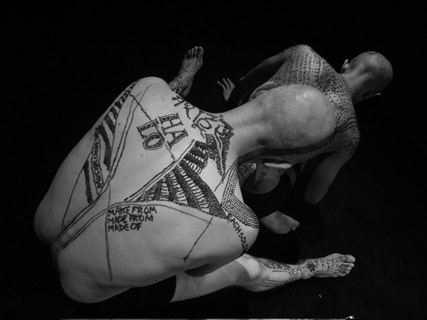
Alex Bradley, Hetain Patel, Migrate
photo Tanuja Amarasuriya
Alex Bradley, Hetain Patel, Migrate
THERE ARE TWO MEN IN THE ROOM. I DO BELIEVE THEY ARE WEARING NEAT BLACK UNDERPANTS. THEY GLOW UNDER THE EXHIBITION LIGHTING, TAWNY SLENDER ANIMALS, ONE SLIGHTLY MORESO THAN THE OTHER. Behind them, through the small window, the harbourside gleams in shades of orange, as though the day were turning—there is a sense in this room of perpetual sunset.
Gallery 5 in Bristol’s Arnolfini is small for a gallery, about the size of a child’s bedroom. There is dark blue carpet on the floor. The window facing the entrance is covered in sun-screening film. During the course of Migrate the walls to the left and right of the door, facing each other, are mirrored.
“Migrate
A duration performance by Alex Bradley and Hetain Patel
Migrate, verb; to move from one specific part of something to another.
Cells that can form pigment migrate beneath the skin.
Over two days (the artists) will occupy Gallery 5 using henna to transform themselves and their environment. Through this process, the artists will explore how the perception and meaning of the body can be altered and redefined… this collaboration of bodies, one black, one white, will dissolve opposites and suggest more complex relationships.”
The men are intent, they look at each other, they are serious, and it is impossible to cross the sight lines between them. One draws on the other: lines accumulate on flesh in a rough looking, crusty green paste. The other watches the growing effect on his body in the mirror—back, arms, feet. Each will draw on his own skin as well. There is a heavy, sweet smell, a slight chemical catch in the back of the throat. A dish of little silvery cones is on the floor. One of the men—just now he caressed the other with a slow cursive line—walks over to it, picks up a cone and breaks off the tip. He returns to his companion and, squeezing out the contents of the cone, continues to inscribe, scrawl, scribble with the henna on the other’s skin.
Each figure echoes off into infinity in the flanking mirrors, becoming dimmer, smaller, vaguer, as do the reflections of the watching audience. “The artists will create a durational performance, the traces of which will remain as an installation.” The next day the room will be empty except for a set of eight polaroids of the two, placed on the floor.
People came and sat on the carpet to watch—we were asked to take our shoes off. The men’s concentration was all on each other, the audience merely observing. I couldn’t work out what my response was supposed to be. It felt obtrusive, for instance, to go up to one or other of them to look more closely, to try to make out a word or a sentence or an ideogram. What if I got in their way, or tripped them up, or smudged them? As a spectacle it was…muted. Partly because they didn’t speak, and also, in spite of the constraint between audience and performers, the action was quite informal, improvised, and the lines being drawn were neither particularly careful nor elaborate. That dun-coloured light filtered in from the window and time didn’t seem to be moving very fast. I wondered how they were going to pace themselves to have enough skin left to paint on till the end of the day. I wondered if they would not have been more comfortable with something to rest on, take the weight off while drawing on hard to reach places. I also felt that what I had read in the program notes didn’t mesh with what I was seeing. These two were hardly opposites, and what was that about dissolving? A binary would have to be there in the first place if you’re going to dissolve it.
It bothered me, when I thought about it more, that the work had that careless, personal informality. I thought of festivals, families, women; I remembered some of the intricate henna painting I’ve seen, the virtuosity of it, a real celebration of the decorative impulse and the domestic circumstances it arises from. I thought of how, on really dark skin, henna is almost impossible to notice except on the palms of the hands. So I guess what was bothering me was that the work as I had seen it, and read about it in the program notes, wasn’t evoking much for me except the act of two blokes in a room, drawing on each other.
Because I couldn’t get to grips with the performance I went to see Alex Bradley who lives just round the corner, to ask him about it.
He was still covered in cursive scrawls! “Look what he did. Look what I did. Look how those lines change when I move.” It was strange how the character of the marks had changed away from the gallery, on a person going about his daily life. Now they were loose, naively charming, careless, free, as personal as handwriting, and Bradley stood, a decorated man. A person who has been used as a surface and used another back, exchanging subjectivities.
He said he’d received compliments from the Singh brothers when he went to the corner shop—with a T-shirt on, of course— “Nice henna!”—and that the ladies had inspected him and asked all about it, genuinely interested. (He didn’t say whether the compliments had come in the same tone of voice one man might use to compliment another on his handbag.)
What does it do to a body to be marked in this way? Imagine the following is a mind map, with little arrows instead of commas: becoming an object, exchanging subjectivity, cultural exchange; translation, literacy, literature, numerous arthouse films; masking, disguises, signifying, different types of gesture; claiming and marking, dominance, permission, exposure, vulnerability; tattoos, scarification, body modification and primitivism (cave painting, hunter-gatherers); prosthetics and the ultra-body. I’m sure whole dissertations could be written about this if one were so inclined.
As our conversation continued I began to understand that Migrate had been the beginning of something. The curator had made it possible for the artists to perform a significant, open-ended gesture in front of an audience, inviting interpretation. It’s the beginning of a dialogue between Patel and Bradley whose further implications, whose other shadowy protagonists, will become more apparent as time unfolds. The performance has been an action that accumulates meaning as the traces of it cause reaction in the artists’ lives, and cause their dialogue to progress. I’m struck by the fact that the thing, the significant action, whatever it was—two blokes in a room drawing on each other—turned into something more real for me once it was out of the gallery; maybe that’s a defining aspiration of live art practice? I would have liked the program notes to help me understand this—the problems I had with the work stemmed mostly from thinking about it as a finished thing. But it’s great that a curator will do this, will prioritise making, doing, an action, above proposal writing as the thing that makes new artwork happen; will support the beginning of an unpredictable process through the gallery system, and enable it to unfold in an open-ended way.
Migrate, Alex Bradley and Hetain Patel; We Live Here, Arnolfini’s Associate Artists program, Gallery 5, Arnolfini, Bristol, UK, Sept 23-24
RealTime issue #76 Dec-Jan 2006 pg. 46
© Osunwunmi ; for permission to reproduce apply to realtime@realtimearts.net
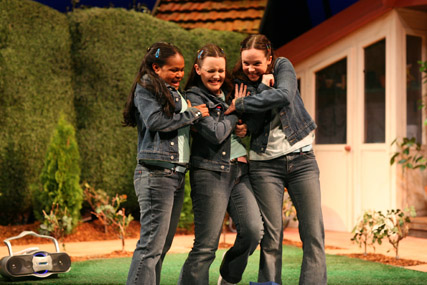
Ursula Yovich, Katherine Fyffe, Emily Hunt, Afternoon of the Elves
photo Tracey Schramm
Ursula Yovich, Katherine Fyffe, Emily Hunt, Afternoon of the Elves
LINA AFTERNOON OF THE ELVES IS A PLAY ABOUT TWO VERY DIFFERENT GIRLS AROUND MY AGE (10) WHO LIVE NEXT DOOR TO EACH OTHER SOMEWHERE IN AN AMERICAN SUBURB.
The play is based on an award-winning novel of the same name by Janet Taylor Lisle (we’re reading it now thanks to mum buying the book) and is directed by Linda Hartzell (of Seattle Children’s Theatre where it was first performed).
I think the story is really about what is important for a friendship. Is it more important to have ‘friends’ that need you to dress like them, be the same as them, do as they do…or to actually have a real friend (like in this play) who is very special but ‘different’ and who cares about you? This is the choice of a very normal only-child called Hillary, invited to share a secret with her next-door neighbour, Sara-Kate. Hillary is new to the area but has heard about Sara-Kate from the other kids at school, and not very nice things either. But one day she is invited into Sara-Kate’s backyard, and what does she see? A small village, which, Sara-Kate says, was built by elves! And it is Sara-Kate who is looking after it too!
Hillary sees that her new neighbour is a very special girl, even if she seems a bit mysterious and is having problems at school. (Hillary’s parents are not so sure the friendship is a good idea.) And Hillary has her own questions: why would the elves build a village like this—out of old bicycle wheels, garden boxes, bits of wire left lying around— amongst the overgrown weeds of Sara-Kate’s yard, and not somewhere else? Why was she the chosen one? Whatever the answers, the elves’ little village brings the two girls together. But there are still other secrets Sara-Kate has not told Hillary. What is she hiding and why does nobody ever see Sara’s mum? Is she sick, mad, or…dead, like the girls at school keep saying?
I think this was a really interesting play. I loved it, and I couldn’t wait to see what would happen next. My favourite characters were Sara-Kate and Hillary. The others, the ‘popular girls’, were always wearing the same things. They made me think about some of my friends at school; how they’re always dressing the same too! Summing up, I would definitely like to see this play again sometime. For now I’ll finish the book. On to you, Nathalie…
Nathalie (6 years old) I agree with Lina. I wasn’t ever bored either. I liked the way you got to see the two backyards. Sara-Kate’s is messy and darker and Hillary’s neat—too neat and boring—and brighter. They turned around on a revolving stage. The elves must have been very clever to build such a beautiful little village! A strange sound came on when they must have been nearby and their elf ferris wheel began to turn all by itself! Mum says I should say that the ‘performances’ were all good although there were some American words which could have worked just as well or even better in ‘Australian.’
Night of the Elves, director Linda Hartzell, adapted by Y York from the novel by Janet Taylor Lisle, performers Margot Fenley, Katherine Fyffe, Emily Hunt, Jen Taylor, Rory Walker, Ursula Yovich, designer Mary Moore, composer Glyn Lehmann, lighting Mark Shelton, creative producer Cate Fowler, Windmill Performing Arts and Sydney Theatre Company; Sydney Theatre, Oct 27-Nov 5
RealTime issue #76 Dec-Jan 2006 pg. 46
© Lina MacGregor & Nathalie ; for permission to reproduce apply to realtime@realtimearts.net
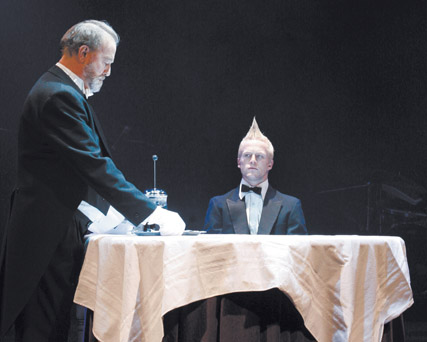
Bille Brown, Tom Flanagan, Feasting on Flesh
photo Louise Whelan
Bille Brown, Tom Flanagan, Feasting on Flesh
feasting on flesh
What holds Feasting on Flesh, a sex-food burlesque at The Studio, together is a demented waiter (Tom Flannagan) whose spitoon runneth over. He pours the contents of this bottomless horn of plenty into the glasses of his audience (with a warning grimace as one begins to drink) as well as providing a string of astonishingly rapid sight gags, whisk juggling, somseraulting and gleeful flashing. In a show that oscillates sometimes trimly but more often loosely around the subject of food and sex, this agreeable lunatic keeps the audience in the loop as some strange activities are staged—a naked man strung up like meat; tomatoes trodden into a naked back by stilettoed stripper Gypsy Wood; heads on platters; a pleasingly ample Candy Bowers declaring herself chocolate cake in pulsing talk-song; some spectacular, sensuous aerial work (Mark Winmill) and deliberately bad magic acts. Presiding over events and other people’s nakedness is the elegant Bille Brown looking like the classic dinner-suited protagonist of 19th century pornography (usually a Brit in French eyes), reciting literary tidbits and finally orchestrating an orgiastic display of flesh fit for a feast.
Feasting stays for the most part firmly within a burlesque framework replete with bum and tit jokes and erotic fun (the naked stripper gladwrapped: “That’ll keep her fresh a bit longer”, quips Brown; or the equation of icecream with sperm after some hard cone licking by the girls) and with added, if predictable, poetic takes on the curious pleasures of oysters and figs. The food-sex connections are sometimes literal, sometimes lateral, sometimes absent—the waiter whisks eggs and milk and does a spectacular backward somersault from the balcony to the floor, amazingly keeping his creation intact: Voila! Eggflip. Later, Brown inserts a wedge of chocolate cake neatly into the waiter’s upturned arse. The audience gasps, though that’s about as risque as it gets. It’s a fun night, stretching more than the burlesque envelope just that little bit. The other integrating element is a singing drummer (Gotye) who provides an almost constant musical and effects soundtrack plus a bevvy of maudlin songs in sad pop-tenor about lost love. Although possessed of a fine voice, which the audience applauded rapturously, it was hard to see what such misery had to do with the food-sex thing—perhaps something about the insatiability of human need; after all none of the pleasures onstage were the real thing. Well… real cocks and arses and uncensored rudery. But love? That aside, director Scott Maidment keeps the action and the double entendres moving right along with visceral verve.
one more than one
The Emma J Hawkins-Keith Lim movement duet in Branch Nebula’s Plaza Real was a striking, wordless meeting of very different bodies (RT64, p44). In One More Than One the whole show is theirs and, again, they are at their best in choreography that is not complex but idisoyncratically, adroitly and vividly realised (movement consultant Rowan Marchingo; director Nikki Heywood). Their mutual manipulation transcends the cliches that a duet of tallness and short stature could engender. Hawkins and Lim are also strong stage presences with attractive voices, but writing is not their forte. The subtleties their physical engagement suggests are not to be found in the text—long strings of questions about the most obvious of short/tall and cultural prejudices. The consequence is a didactic theatre-in-education feel compounded by a sluggish first scene setting up the imminent relationship and an ongoing, tiresome deployment of plinths (admittedly later put to good use in playing with the relativities of height). The Hawkins-Lim partnership is a potent one in the Sydney performance scene, and while they have many able hands assisting them on One More Than One, perhaps they should add one more, a writer to that list.
it just stopped
It’s bloody heartening to see something so unbalanced. I exited all giddy and punch drunk with objections to the Sewell vision with its endless string of hit and miss one-liners and bloody catharsis. I’m on his side. Who needs redemptive moments and empathetic characters? Life isn’t At The Movies . Those poor bloody Sewell-Yanks (Kym Gyngell as Franklin, Catherine McClements as Beth) in their all too real ivory tower, let ‘em have it, them and their New Yorker and New York Review of Books and their total ignorance of the world outside their apartment. But, really, are New Yorkers the problem? Well, they got bombed. Hang on, weren’t The New Yorker and New York Review of Books two of the the very, very few American publications not frightened into submission by the War on Terror and its attendant dimnution of civil rights? Sewell’s male protagonist, whose madness turns out—in a final act dramaturgical road crash—to be the only consciousness of the play (bugger the wife), is writing a Wagner apologia for the Review (to wit: Wagner’s greatness transcended his anti-semitism which was of the times). In all my years of reading the Review I’ve rarely ever seen that kind of argument.
So what?, you’re thinking. After all, scatterfire satire has become the hit and miss of The Glasshouse, where taking a position is anathema—strike out at one and all. Sewell’s Americans are unfunny and uninteresting, just loud-mouthed. If you ask me, the play should have begun with the arrival of the Australian neighbours (John Wood as Bill, Rebecca Massey as Pearl) announcing the beginning of the end of the world and making their devilish offer of escape and life, but also of slavery. Then the spiritual and cultural poverty of the Americans could have been revealed rather than lengthily exposited.
Sewell’s great creation in It Just Stopped is Bill as realised by John Wood: the very latest model of the Australian male, weirder and more cunningly and cruelly contrary and brutally pragmatic than anyone in Casey Bennetto’s Keating!. But, because Sewell is so obsessed with the evil of his Americans, the play ends up in the lap of impotent Franklin (think about Sewell’s choice of name). His paranoia turns psychotic, he kills Bill and goes down himself to the strains of Wagner and the devastation of New York in a Gotterdamerung both private and public. But before being shot, Bill turns out not to be the monster Franklin has conjured, but a tolerably benign chappy offering him the editorship of an Australian equivalent of the Review. So, Bill and Pearl turn out to be the figments of an overwrought and limited American vision of Australians. But as William Blake said of Milton, the poet’s wonderful portrayal of Satan in Paradise Lost made him of the devil’s party. Sewell’s Australian devil, Bill (until de-fanged), has the best lines while Rebecca Massey as Pearl offers a finely crafted version of Mrs Australia—pearls and cardy, alcoholic, tunnel-visioned, unpredictable and physically dangerous. Our Australian demons cannot be sheeted home to the Americans. Australian complicity in US dirty work is only as interesting as what we know about ourselves and not the degree to which we imagine ourselves seduced. The play is a fascinating experience, if only for what it almost says—but it just stopped.
keating!
It didn’t take long for Paul Sheehan, one of the Sydney Morning Herald’s right-wing stringers to come out whinging about Casey Bennetto’s musical, Keating!. In Sheehan’s world, balance is a one-sided affair so the prospect of an out and out celebration of the career of a distinctive Australian like Keating is just not on. It’s always amusing to see the right arguing for complexity from positions that are simplistic and tired—the show’s Howard-hating! But for Sheehan, of course, it’s all right to slag Keating. Keating! is unapologetically pro-Keating and operates within a very tight frame: it knows its limits and exploits them. Composer-lyricist Casey Bennetto takes the language of an era, pops it adroitly into pop pastiche and sketches a life. He lets the songs do the talking—there’s no dialogue—and they say it all, not just delivering the Keating vocabulary (replete with its own hiccups and evasions and obscurities, like the j-curve) but the language of a brutally monetarist era (which Bennetto as Hewson raps out only to be out-rapped by Keating invective) and the subsequent Howard-bites. Mike McLeish is fine as a showbiz Keating, all pose and verve, while Terry Serio is more calculatedly satirical as Hawke and then Howard (especially funny and revealing when he is sequentially kitted out in Howard’s four persona outfits). Bennetto does Downer’s petulance and keyboardist Ennio Pozzebon does a good Gareth Evans if short on the volatility. The band is superb, well integrated into the action and allowed their moments of virtuosity. There are gaps. The seriously talented band could surely have incorporated a bit of Keating’s beloved Mahler among the pastiche in the manner, say, of Uri Caine’s jazz interpretations. And, some more detail of the Keating demise, other than the Gareth-Cheryl romance, could have been built into the final phase of the performance. Sheehan of course conjures soft left audiences seduced by Keating! The Musical, but they’re not stupid. They recognise the great things—Mabo—and wonder about others—the skewed Creative Nation. They acknowledge the man’s fallability, but would rather, as the musical’s comic finale fantasy plays it out, have had Keating win the 1996 election for us to still savour this man’s rough wit, flashes of idealism and sheer unpredictability in place of Howard’s ‘reforms’ and measured untruths.
fast cars & tractor engines
I missed Urban Theatre Projects’ Fast Cars and Tractor Engines the first time round (RT70, p41) but caught it this time in Bankstown at the end of its Western Sydney tour. A form of verbatim theatre with the performers working from their subjects’ recorded voices, played to them through headphones, the effect is marvellously verite and the selection of material culturally revealing, and often great fun, in the most un-stereotypical of ways. Anthony Brandon Wong, a late cast replacement, performs with all the ease, expertise and passion of fellow players Mohammed Ahmad and Katia Molino, while director Roslyn Oades frames the action with a simple domesticity textured with witty gestural choreography. It would be great to see this interesting idea extended in some new directions. Urban Theatre Projects turned 25 in November: we’ll celebrate that in our next edition.
Feasting on Flesh, director Scott Maidment, design Chris Booth, lighting Jo Currey, producer Sarah Stewart, Strut & Fret Production House; The Studio, Sydney Opera House, Nov 9-18
Atypical Theatre Company, One More Than One, performer-devisors Emma J Hawkins, Keith Lim, director Nikki Heywood, movement consultant Rowan Marchingo, dramaturg Christopher Ryan, design Kate Shanahan, lighting Clytie Smith, video Shehane Bekarin, video consultant Sam James; sound Jonathon Creenaune; presented by Western Sydney Dance Action & Riverside Theatres; Riverside Theatres, Parammatta, Oct 25-28
Stephen Sewell, It Just Stopped, director Neil Armfield, design Stephen Curtis, lighting Paul Jackson, composer John Rodgers, sound design Russell Goldsmith; Company B & Malthouse; Belvoir St Theatre, from Oct 4
Keating! The Musical, writer, musical director Casey Bennetto, director Neil Armfield, design Brian Thompson, costumes Jennifer Irwin, lighting Damien Cooper, choreography John O’Connell; Belvoir St Theatre, opened Nov 15
RealTime issue #76 Dec-Jan 2006 pg. 47
© Keith Gallasch; for permission to reproduce apply to realtime@realtimearts.net
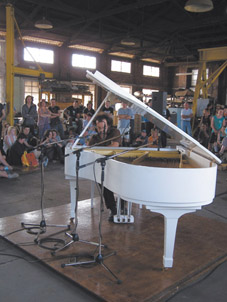
Anthony Pateras at the Junee Railway Roundhouse Workshop
photo Sarah Last
Anthony Pateras at the Junee Railway Roundhouse Workshop
EXPANSIVE IN ITS SCOPE, A FAULTLESS CURATORIAL LOGIC DISTINGUISHED THE 2006 UNSOUND FESTIVAL. BOTH ON AND OFF THE RAILS, THIS AMBITIOUS PROGRAM OF LIVE PERFORMANCE, SOUND ART AND INSTALLATION SURVEYED SOME OF AUSTRALIAN MUSIC’S MOST OUTLANDISH MARGINS.
An improbable centrepiece of the festival was the Loco Motivus, an iron-horse caravan of resident aliens and coastal fringe dwellers, shunting between isolated heritage townships, and even less likely venues. Whether consciously or not, the Loco Motivus harkens directly to a defining moment in contemporary culture: Pierre Schaeffer’s 1948 discovery of musique concrete with Etude aux chemins de fer. This work of Schaeffer’s—proto-turntablism with recordings of steam trains—described the possibilities of a radically new compositional paradigm: one which was contingent not on instrumental technique and a hierarchy of composer, conductor and performers, but pivoted rather on the playful maladaption of new technologies, and a restored sensitivity to environmental sound. It is the significant precedent for the most creative music of the intervening 58 years.
This historical lineage becomes dramatically explicit at the festival launch in Shannon O’Neill’s performance: the rigorous live interrogation and digital reprocessing of the sound of his own trip west along the train line from Sydney. For this listener, the most successful elements occur in O’Neill’s inscrutable estrangement of his source material, and a refusal of the motoric rhythm that recording suggests. The “wheels of steel” analogy is advanced even further by Rod Cooper, who marries his considerable accomplishments as a sculptor in wood and metal to a studied avidity for dissonance. His new performance unites “prepared turntables” (with self-made discs and phonograph cartridges) with another of his stunningly fashioned instruments. Cooper’s sound exemplifies what two other festival performers, Robin Fox and Anthony Pateras, have defined as “maximalism”: an approach to sound which cultivates complex structures along both horizontal (dynamic) and vertical (timbre) axes: a close listening is rewarded with the revelation of new and unfamiliar sound-worlds.
Friendly visitor from the USA, Al Duvall, explores an occluded anachronism of vaudevillian performance through his elementary yet tuneful banjo strumming, punctuated by fiery kazoo outbursts. What compensates for the absence of virtuoso proficiency are Duvall’s lyrics: extravagant mixed metaphors and colourful inversions of ‘horse sense’ proverbs. The local analogue might be Chad Morgan, and Duvall’s wry, ironic humour served to remind the audience that, like ourselves, our fellow travellers from across the Pacific lake are also capable of an antic sophistication with vernacular idioms. Duvall’s national tour is at the invitation of the Dual Plover label (RT74, p51), and as such it’s merely the most recent explication of Lucas Abela’s discreet proposition that some varieties of experimental music locate their historical lineage not in ivory-tower brain-trusts, but in vaudeville and the music hall. The argument is a provocative one: it proceeds from the assumption that experimental music might be a form of popular live entertainment, and with a considerable debt to low-culture folk traditions.
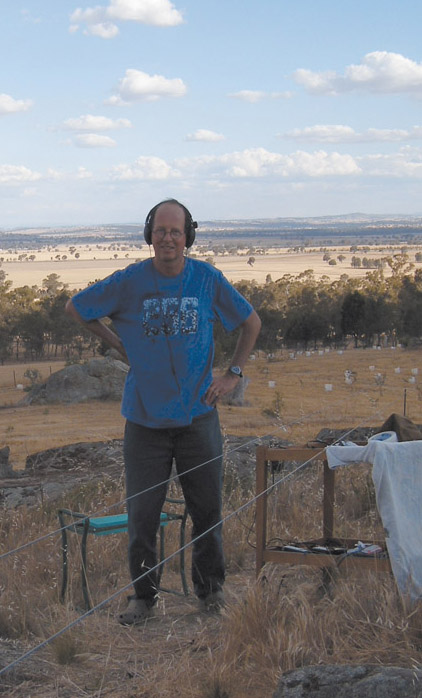
Alan Lamb, Aeolian Harp/Wire instrument on Pindari Farm, unsound06 festival
photo Sarah Last
Alan Lamb, Aeolian Harp/Wire instrument on Pindari Farm, unsound06 festival
The contention is beautifully illustrated by another performer, Gary Butler, who brings a bricoleur inventiveness to his raucous guitar improvisation on an otherwise saccharine show tune. Butler’s facility with his instrument affords him an hilariously enlarged sonic vocabulary, but also serves to essay a sardonic investigation of hierarchical power structures—a concern which is taken to outlandish extremes the following day, in concert with the Von Krapp Family’s carriage of the Loco Motivus.
Of Australia’s several festivals of creative music, Unsound is probably the most successful at accommodating installation and site specific work. Accordingly, the second day is a sonically embellished form of package tour. First stop is an inspection of Alan Lamb’s aeolian harp at the Pindari property; although this work is heard to much better affect aboard the Loco Motivus when we listen remotely by CB radio to a live wind-and-wire broadcast. The Coolamon Up-To-Date Store, with the Goldbergian overhead apparatus of its antiquated cash railway, is a perfect frame for Ernie Althoff’s work, D’s Guest Appearance (2006). Eponymous “D” is the “Declivities”, a circumspect chorus of gumnuts rattling within adapted record players—providing background to a whimsical interplay of aleatory automated soloists. Assured in its delicate modesty, this work’s whimsical crypto-Zen is well served by its elegant simplicity.
Lunchtime later, a duet from Al Duvall and Singing Sadie farewells our embarkation aboard Loco Motivus. Sadie’s performance has profited from the discipline of a lengthy North American tour, and a greater confidence and finely nuanced persona are the result. Their collaboration works to the advantage of each; Sadie’s vigorous Tanztheater hoofing and shrill caterwaul set in perfect counterpoint to Duvall’s bemused folk observations.
The Loco Motivus is a striking achievement, not least for the logistical planning required of project Coordinator, Sarah Last. The train is a group work by some two dozen artists, either working alone or in small ensembles. Some artists have a carriage to themselves, others work within the lesser dimensions of a single berth. The model might have been the Constructivist film trains of 1920s Russia, or the Queensland Writer’s Train that once (and, perhaps, still does?) brought the likes of po and Peter Carey to country schoolkids. The Von Krapp Family employs the coach car to make its mockery of neo-conservative behavioural norms, providing an absurdist exaggeration of the logic of Un-Australia. Robbie Avenaim’s installation is a mechanised drum orchestra, partially driven by audience interactive foot pedals. (Later that night, Avenaim will demonstrate a rare delicacy of touch in his solo percussion performance; an aspect of his work which has perhaps been submerged within other ensembles).
Dave Noyze also offers his audience some diminished control, via the ostensible button to summon the porter, which now brings only a dolorous foghorn honking. The carriage he shares with Garry Bradbury is a labyrinth of space and sound alike, with each off-corridor vestibule populated by the noises they orchestrate from their mixing posts. Abject Leader’s carriage has become the site of their latest performance in expanded cinema, with multiple film projections through colour filters looped along the ceiling, and variously focussed on one of the three sheer fabric screens hung across the carriage. While Sally Golding busies herself with the rudely bouncing projectors, Joel Stern provides a tour-de-force performance on processed trumpet and thumb piano. The effect is ultimately overwhelming, but not unpleasantly so; there is always the possibility of respite between carriages, or a congenial chat with other passengers down in the guard’s car. Culmination of sorts occurs at the Junee Railway Workshop locomotive turntable—a revolving section of track encircled by a dramatically imposing roundhouse. Rod Cooper’s tubular sound sculptures entertain individual auditors in queued succession before Anthony Pateras provides a dazzling turn on an incongruously white piano in the toolroom. Pateras tests the limits of his keyboard preparations with a breakneck agility, matching his seemingly unlimited sonic vocabulary to a succession of different performance styles.
The situation of margins and centre is always relative. A few weeks prior to its Unsound reprise, Pateras premiered this new work for solo prepared piano in concert with the LA Philharmonic before a rapturous 2,000-strong crowd. At the festival’s final concert, later that night in Wagga, Tom Ellard extemporises the hilarious video montages that have delighted Big Day Out audiences for years. The example of both these artists, and Unsound itself, volubly demonstrates that the audience for creative music, in its broadest possible conception, might be less narrow than is sometimes assumed.
Unsound 2006, co-directors Sarah Last, Adam Bell, Wagga Wagga, Nov 10-11, http://space-program.org/unsound06/
RealTime issue #76 Dec-Jan 2006 pg. 48
© Jim Knox; for permission to reproduce apply to realtime@realtimearts.net
CONCEIVED BY ARTISTIC DIRECTOR DAVID YOUNG AND COORDINATED BY HIS APHIDS ENSEMBLE, NEW MUSIC MACHINE DEMONSTRATED THE ENORMOUS BREADTH, DEPTH AND TALENT EVIDENT IN MELBOURNE’S NEW MUSIC SCENE.
The inaugural New Music Machine festival showcased several Melbourne-based ensembles over three evenings, premiering many new works and giving some better-known works a timely airing.
Each of the first two nights comprised three one-hour concerts. Speak Percussion opened with performances of pieces by US composers James Tenney and Frank Zappa, a joint composition by John Cage and Lou Harrison, a haunting work by local Warren Burt, and a new composition by Erik Griswold. Vanessa Tomlinson, who performs with the Twitch ensemble as well as Speak Percussion, gave a memorable account of Burt’s Beat Generation in the Californian Coastal Ranges, for solo vibraphone and electronics. In this work, a haunting, whining drone underpins a studied, meditative overlay of chords, set to a strict, dramatically slow rhythm. In Erik Griswold’s new Strings Attached, four of Speak’s six performers play snare drums with drumsticks connected by white nylon ropes to a maypole centre-stage, while the other two play snare and tom toms, at opposite ends of the stage, using sticks roped to each other’s sticks. The ropes oscillate in waves as the drums are played, with dramatic and visually stunning results.
Twitch then premiered their 6×6, a huge work for which each of the six members wrote one movement. This turbulent, chaotic piece—for prepared piano, violin, viola, ukelele, percussion, trombone, recorders, electronics and assorted objects and devices—recalls Dada and Fluxus events, but there is method in the madness, as the performers work from scores including graphic ones. Twitch has developed an individual and coherent musical form out of musical references pushed to the limit—a rubbery-sounding prepared piano, morphed voices speaking—shrieking nonsense syllables drafted on the spot and comic elements including a balloon being rubbed, a large book being slapped shut and another being repeatedly thrown to the floor. Some elements are recorded and replayed during the work. The performers, in stocking masks with whitened eyes and reddened mouths, create a cathartic piece of theatre.
The first evening concluded with David Young’s enchanting Scale, scored for toy piano, guitar, a speaker and six of the delightful instrumental boxes made by Rosemary Joy (similar to those used in Schallmachine, p32), the whole accompanied by projected imagery. We hear soft taps, squeaks and scrapes as if we are eavesdropping on a microcosmic world. Scale is a gesamkunstwerk in miniature, and is directed through graphic scores and detailed written instructions to the performers. The CD version includes a new text, The Uninhabitable of LB, by Cynthia Troup, and you can become absorbed in the entire work—sound, images, text and performance notes—in the confined universe of your own computer.
The program for the second evening, broadcast live by ABC Classic FM, was for three established groups, the David Chesworth Ensemble, Dead Horse Band and Jouissance. The Chesworth ensemble performed its award-winning Panopticon as well as Floating World and a newly commissioned work, Sport, that includes energetic shouts and umpires’ whistles and whose arrhythmic progression mimics the stop start action of sporting competition. The Dead Horse Band performed Kate Neal’s energetic fusion piece Dead Horse 1 (2005), for string quartet, electric guitar, bass, piano and drums, and her new String Trio, a quietly introspective and heavily textured work that is actually for a quartet of violin, viola, cello and double bass. The acclaimed vocal and instrumental setting of Byzantine hymns, Akathistos Fragments, by the ensemble Jouissance and directed by double bass player Nick Tsiavos, completed the program.
On the final night, the Australian National Academy of Music presented a performance of John Cage’s legendary Sonatas and Interludes for Prepared Piano (1946-1948) and a series of improvised works by Anthony Pateras and other ANAM musicians, all involving prepared instruments. Cage’s Sonatas and Interludes was rendered by a team of four pianists, including Nigel Butterley, who has championed the work in Australia, and three ANAM musicians, with Butterley reading excerpts from Cage’s Silence between changes of pianist. This was a magical rendition, though there were some interesting differences in approach to pianism and interpretation by the four performers. The program note thoughtfully included a copy of a 1973 letter from Cage to Butterley in which the composer discussed preparation, suggesting, “You will often be able to tell whether your preparation is good, by whether or not the cadences ‘work’.” In preparing a piano, the pianist re-invents the instrument and its music. Neither synthesiser nor computer could produce the same effect (or convey the still important flavour of iconoclasm).
Pateras’ intense, carefully sculpted and minimalist Continuums and Chasms (2005-6) for prepared piano followed. Compared with Butterley’s mild augmentations that produce chiming, bell-like sounds, Pateras’ modifications generate rather claustrophobic sonorities—the whole top octave of strings is heavily gaffer-taped to make a sound like closely miked marbles cascading onto a concrete slab. In the lower registers, Pateras employs the usual bolts and screws and also cardboard wedges and other soft material to damp the strings, producing overall the sound of a percussion orchestra. The evening concluded with some very effective improvised works for solo viola by Mary Oliver, for the trio of piano, guitar and drums by Pateras, David Brown and Sean Baxter, and for a quartet of those three plus Oliver on violin.
New Music Machine’s programming suggests that contemporary music is highly diverse, ranging from the sublimely spiritual to the noisily secular and from the virtuosic to the manic. Minimalism, the exploration of sound and instrumentation, especially percussion, and the possibilities of group improvisation remain fertile areas of development. This was a well-organised and memorable festival, competing successfully with the musical elements of the Melbourne International Arts Festival that preceded it. The festival lacked only detailed program notes for some performances, important especially for new audience development. Too few people attended this wonderful series, despite the low ticket prices, but ABC Classic FM radio gave strong support by broadcasting Friday night live and recording Thursday’s performances for later broadcast.
New Music Machine, Australian National Academy of Music, South Melbourne Town Hall, Nov 2-4
RealTime issue #76 Dec-Jan 2006 pg. 49
© Chris Reid; for permission to reproduce apply to realtime@realtimearts.net
IT IS RARE TO COME ACROSS SOUND ART THAT HAS BEEN SPECIFICALLY CURATED FOR A GALLERY. MORE OFTEN THAN NOT THE PRESENTATION OF SOUND IS A PRAGMATIC EXERCISE USED TO OVERCOME THE LOGISTICS OF PERFORMANCE SETTINGS AS WELL AS TO POSITION SOUND WITHING THE REALM OF ART.
Unsurprisingly, most sound exhibitions, like sound performances, require the listener to engage with a specific work for a fixed time. This style of engagement is typified in the use of headphones, loops and other devices that confine the individual’s experience to a single work in the context of many. This practice of isolating works seems to stem from the presumption that the integrity or experience of sound relies on the preservation of certain conditions associated with the protocols of performance or pure, uninterrupted listening.
Unlike many other sound exhibitions, the works in Potent are played into the gallery space together, so that sound is not restricted to the perceived confines of individual creations, but exists as a whole. The result is not a barrage of noise but a considered interrogation of the relationship between sound, its accompanying visual and physical forms, and the way these elements contribute to the listener/viewer’s experience of sound in a gallery context.
In his exhibition catalogue essay, curator Ben Byrne elaborates that sound cannot be understood as “any kind of stable being”, but rather is “a continual becoming, a potential to be experienced.” The notion of sound as potential (from which the title derives) is central to this exhibition.
Each of the works in this show pays particular attention to the way visual and physical representations inform or direct the act of listening, and the extent to which they determine what is actually heard. Sumugan Sivanesan and Sam Smith’s collaborative work, Plywood Box 2006, plays with the notion of sound as the art object. The work consists of a large plywood box and a video—of the two artists ‘playing’ and exploring the box as an instrument—edited into short clips and projected onto the gallery wall. Here, being in physical contact with the box provides a very different experience of sound and space. Audience members are forced to orient themselves sonically in relation to the box which acts as both an ambiguous point of reference from which the sound emanates, and an artefact of the sound being heard.
Sam Bruce’s Partially Manifest Cube requires the listener/viewer to lean over and touch a vibrating box in order to hear it fully. In Bruce’s work, hearing relies upon seeing and touching, such that the sound itself and the act of listening are simultaneously produced by this complex, sensory interdependence. The top surface of the cube is inlaid with a screen displaying a writhing geometric landscape that threatens to burst open and out of the cube. Touching this work feels like placing one’s hand on the lid of a crucible of movement and sound, giving the idea of sound as potential, a palpable, physical reality.
This experience of sound being bodied forth by the art object is explored in Jasper Streit’s Resonator, where sheets of black cardboard are hung along the gallery wall like a series of modernist canvases. Deceptively, the cardboard sheets—attached to resonators—act as the speakers through which the sound is transmitted and, as such, invite the audience to experience the work more intimately. Resonator, like most works in this exhibition, creates a deliberate disconnect between what is received affectively and signified visually. This disjunction is most poignant in Ivan Lisyak’s You’ll be happier with lower standards. Lisyak presents what can only be described as an unrelenting, epileptic video strobe of blue and red spots that insists on the presence of sound whilst being completely devoid of it. His work, in anticipation of his audience’s frustration, is ingeniously all volume and no sound—a kind of absolute potential that never actualises.
By contrast, Ivar Lehtsalu’s Untitled, Two Channel Generative Digital Audio System, defines the possibilities of sound according to the parameters of technology itself. Here, sound moves through a generative figure eight, oscillating between two computers whilst being played from both at once.
By establishing a context in which works cannot be conceived as temporally, spatially or conceptually discrete entities, Potent makes us rethink the boundaries of the listener/viewer experience as well as the art object itself. In doing so, it breaks the mould traditionally reserved for gallery exhibitions of sound, drawing attention to the way the visual relates to the directed perception of sound, and how the continuity of sound relates to the discontinuity of visual forms.
Michelle Jamieson is an arts writer who has recently completed an honours thesis at the University of New South Wales on the ontology of data and subjectivity.
Potent, curator Ben Byrne, first draft, Sydney, Nov 1-18
RealTime issue #76 Dec-Jan 2006 pg. 49
© Michelle Jamieson; for permission to reproduce apply to realtime@realtimearts.net
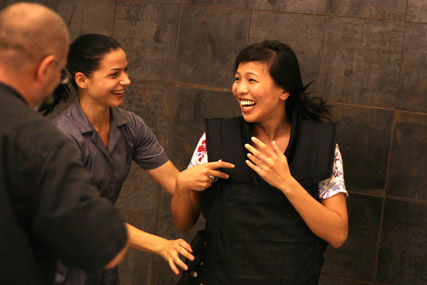
Ana Prvacki, The Leap of Faith
photo Jason Wee
Ana Prvacki, The Leap of Faith
WITH A BUDGET OF $SING10 MILLION, 95 ARTISTS AND COLLECTIVES AND 198 ARTWORKS, THE FIRST SINGAPORE BIENNALE IS THE BIGGEST CULTURAL EVENT EVER STAGED ON THE ISLAND STATE. With THE AUDACIOUS AIMS OF PUMPING LARGE AMOUNTS OF MONEY INTO CONTEMPORARY SINGAPOREAN ART AND ITS RELATED INFRASTRUCTURE, THE NATIONAL ARTS COUNCIL OF SINGAPORE is ATTEMPTING TO TRANSFORM NATIONAL MENTALITY AND INTERNATIONAL STEREOTYPING.
The desire is pragmatic: to move to an innovation-based economy by encouraging its citizens to be more creative, and present Singapore as an open-minded culturally sophisticated city—to show Singapore’s “softer side”, as a representative put it. Despite Singapore’s notorious limits on free speech, the Biennale is presented as an opportunity for Singaporeans “to view diversity in art, new ideas and expressions”. (The National Arts Council’s vision statement is titled “Creative People, Gracious Community, Connected Singapore.”) More instrumental goals for the support of contemporary art are hard to imagine, but few are complaining when arts funding in Singapore has increased tenfold in the past decade. This Biennale, long on the cards, represents the culmination of efforts to cultivate the semblance of a thriving local visual arts scene worthy of international recognition. And of course the government’s desire to present Singapore as the cultural, as well as investment, hub of the region coincides perfectly with Singaporean artists’ understandable eagerness to carve out international careers.
Support for such a large event was secured by the Biennale’s position as the “anchor cultural event” for “Singapore 2006: Global City. A World of Opportunities”—designed to “highlight Singapore as a dynamic, well-connected and entrepreneurial economy”, and focused around the hosting of the annual meetings of the International Monetary Fund and the World Bank. These meetings brought with them 16,000 international delegates. Part of the Biennale was closed for delegates only and public protests were forbidden (one indoor venue was provided to protestors who registered in advance). All of this provided me with a starting point for understanding and appreciating this biennale. In some ways this transparency of the links between art, commerce and politics was refreshing—with the rhetoric of the National Arts Council almost another artwork in itself—and it focused attention on what the curators and the artists actually did under these uniquely Singaporean circumstances.
Veteran Japanese curator Fumio Nanjo was brought in as Artistic Director of the Biennale and enlisted a team of young curators: Roger McDonald (Japan), Sharmini Pereira (Sri Lanka/UK), Eugene Tan (Singapore). Together they fleshed out the curatorial theme of ‘Belief’, alluding to the violent clash of faiths in the world today as much as a general crisis of personal and collective values. Although far from exclusively sacred, the theme involved seven major religious sites, all in use by the Singaporean public. This was part of a strategy to utilise the existing architecture of the city in new ways and offered various layers of experience—the terms ‘interface’ and ‘encounter’ were frequently used—accessible for “multiple levels of audience.” Take the opening, a spectacular public event situated on a central grass square (the Padang), which managed to support both a swank invite-only marquee attended by the Prime Minister, as well as an open public party. It combined the pure spectacle of a 60-metre high floating sculpture of helium-filled balloons each with LEDs inside—Open Burble (2006) by Usman Haque—and Jenny Holzer’s scrolling text projection on the walls of Singapore’s former City Hall.
The artists in the Singapore Biennale hailed from 38 countries scattered across the world. More than half were from Asia, with 12 from Singapore (with Amanda Heng and Brian Gothong Tan gently parodying the biennale as a tourist event). Most of the artists were under 40, but the range extended to Japanese artist Yayoi Kusama. Her Ladder to Heaven (2006), glowing fibre-optic cables with mirrors attached above and below, shown at a Hindu temple, suggested a religious universality. In a critically self-reflexive vein at one of the Catholic churches, Cristina Lucas’ My Struggle (2004) depicts a street preacher raving about art. Similarly fused with pathos, Lucas’ More Light (2003), shown elsewhere, recorded the artist’s confessional session with a priest, asking why the Church has abandoned its support of contemporary art. Meanwhile, on the banks of the river a ‘miracle tree’ rained periodically through the day as if by magic, in a poetic public installation by the Dutch artist known as IEPE. Everything in this biennale was precisely calculated for maximum impact.
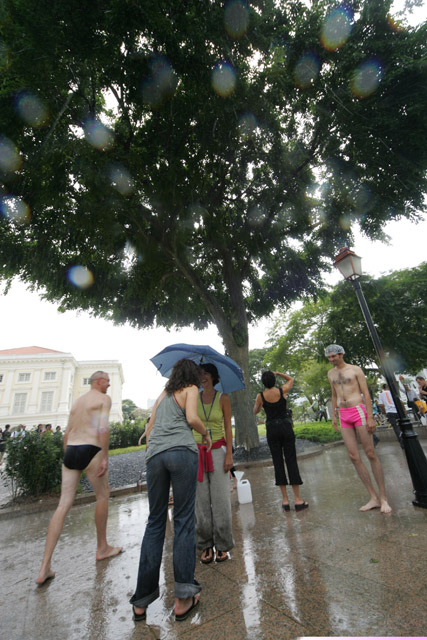
Iepe, Singapore Miracle Tree
photo Jason Wee
Iepe, Singapore Miracle Tree
The Biennale also gave public access to some of Singapore’s historic buildings for the first time (the event was co-organised by the National Heritage Board). One of the key venues, City Hall—the former Supreme Court building—was ceremonially opened by New Zealand artist Daniel Malone’s Steal this Smile! :), a reenactment of a 1967 peace demonstration by Abbie Hoffman. Curators, artists, schoolkids and anyone else in the vicinity were provided with red and white netball-style singlets and held hands to ‘levitate’ the building (and by extension the Biennale itself). Inside, over 30 artists made installations in the former courtrooms, often responding to the almost overbearing site, with many pointing to the theme of justice. High points included Singapore artist Ho Tzu Nyen’s The Bohemian Rhapsody Project (2006), an elaborately staged soap opera based on the lyrics of the Queen song, and South African Jane Alexander’s bizarre installation featuring human-animal hybrids, red rubber gloves scattered over the floor and three hooded figures on trial for some unknown crime.
There was event as well as site specificity, with some artists responding to the coming IMF meeting. The Finnish collective YKON’s M8 Summit of Micronations, Singapore (2006) directly parodied such meetings, with a video of ‘leaders’ laughing hysterically around a huge oval table. More earnestly, Tomás Ochoa’s video installation, The Myth of Sysyphus (2006), showed people on the street in Morocco and Switzerland responding to the question “What are the last thoughts of a suicide bomber?”—with surprisingly tender insights. In the centre of the building, Rashid Rana’s Departure Lounge (2006), a massive six-screen video installation simulating the view of the sky from a jumbo jet, suggested the paradoxical forces of mobility and stagnation within global events.
At the newly refurbished National Museum of Singapore Mariko Mori and Carsten Nicolai headlined a high-tech section of the Biennale. Nicolai’s space-ship like sculpture, synchron (2005), combines architecture, light and sound; entering it is to experience space sonically. Mori presented a glowing glass tomb adjacent to a curatorial cluster that included a video, The Last Supper (2005), by Swedish artists Bigert and Bergström. This elaborate if heavy-handed documentary—featuring a chef recreating the last meals of prisoners on Death Row—was compelling in this context. Together with Japanese artist Makoto Aida’s gory ritual suicide painting, Harikari School Girls, Jonathan Allen’s beheaded Salome photograph, and Hiroshi Sugimoto’s Last Supper photographs, this whole section came to be about execution—needless to say, a hot topic around Singapore. The inevitable question of whether works in the Biennale had been subject to censorship had been raised in the press launch (apparently there was some ‘negotiation’), but here was proof of curatorial freedom—and of the apparently non-threatening nature of symbolic resistance.
The third key venue was Tanglin Camp, a maze of colonial buildings used for military training of both British and Singaporeans. This site featured a number of ‘interactive’ works such as Ana Prvacki’s The Leap of Faith (2006), which required visitors to wear a strap-on magnet outfit and approach a metal wall, with predictable results. Otto Karvnen’s Belief Board (2006) simply asked visitors to write down their fantasies and ‘solutions’ in an open exchange. Philip Brophy, officially the only Australian artist, didn’t know the theme was ‘belief’ until he arrived to install his work—but his glam performance video Fluorescent (2004) looked and sounded spectacular. Another favourite here was Makoto Aido’s hilarious The Video of a Man Calling Himself Binladen Staying in Japan (2005) in which the artist plays the terrorist leader drunk on sake. Meanwhile, fellow Japanese artist Takashi Kuribayashi provided some child-friendly magic, with works that involved putting your head up through a fishbowl to discover a view inside an aquarium.
There were Biennale experiences to be had almost everywhere on the island, from Hermès boutiques to housing blocks. Simryn Gill, listed as Malaysian, proved once again what a subtle artist she is, with a personal intervention into Tanjong Pagar Railway Station (an outpost of Malaysian territory in Singapore), producing a small publication for sale in a newsagency documenting the history of the site and its extraordinary colonial mural, combined with photographs of contemporary travellers.
While international curators and the well-heeled could take advantage of the series of Asian Biennales promoted in September (the Singapore-Gwangju-Shanghai package), the most important audience for the Singapore Biennale are of course the locals. With taxis plastered with advertising, and Kusama’s huge red and white dots wrapped around the trees along the main shopping avenue (Orchard Road), the 4 million residents of the small island nation were certainly targeted. The Straits Times featured daily coverage, full page ads, editorial features and more. Australian artists and curators could only dream of such blanket positive coverage. I later learnt that the newspaper is part managed by the state and runs a ‘non-adversarial’ policy towards the government (one wonders which is worse: such a uniformly positive view of society, or Murdoch papers and their bigot columnists). In any case, breathless articles about the security measures for the IMF meeting (“fun facts”) and the spectacle of the Singapore Biennale jostled side by side. In Australia we tend to conveniently forget the proximity of arts and culture to government propaganda, here politics and spectacle are one. And, not to forget shopping, an ancillary event revealed eight large sculptural commissions at Singapore’s biggest new shopping complex, Vivo City.
If the Singapore Biennale was impressive as cultural policy, the overall quality of the art was nevertheless high. The world hardly needs another biennale, but who is to deny Singaporeans the pleasure of joining the circuit? Of course the notion of the biennale promises recurrence, and one of the talking points in Singapore was whether this will be an isolated event (remember the Melbourne Biennial), or an ‘occasionale.’ One hopes it will be judged an official success, “stimulat[ing] broader demand for visual arts in Singaporeans, further cultivating and elevating [local] appreciation for contemporary art and enhancing Singapore’s cultural image as a progressive and attractive cosmopolitan city to live, work and play in.” Even if we’re uncertain about some of the hype, we can always believe in the art.
www.singaporebiennale.org
RealTime issue #76 Dec-Jan 2006 pg. 52-
© Daniel Palmer; for permission to reproduce apply to realtime@realtimearts.net
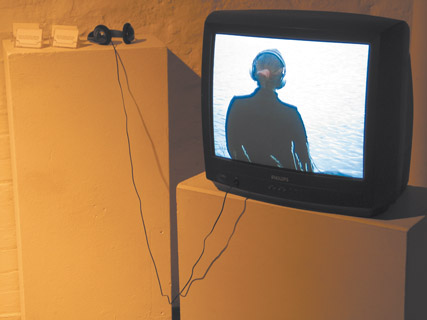
Matt Warren, Provocation
photo Colin Langridge
Matt Warren, Provocation
TO USE TEXT WITHING AN ARTWORK (HOWEVER RANDOMLY) CAN IMBUE THE VISUAL WITH INEXTRICABLE EMOTIVE POWER.
Using the universal significance of text as a thematic springboard, curator Colin Langridge brought together seven Tasmanian artists who incorporate text in their art in Quote, an exhibition encompassing sculpture, video, installation and works on paper. Spread over the ample space of Salamanca’s Long Gallery, Quote presented a number of new works by some of the state’s most accomplished artists.
One of the highlights was James Newitt’s dual video projection Arberg Bay (2004 & 2006). Suspended in the middle of the gallery each video documented a road trip taken with and without friends to a remote coastline on Tasmania’s rugged west coast. Subtitled conversations and images of sweeping landscape created a surprisingly moving visual poetry that evoked the bittersweet experience of growing up. An artist reluctant to pin down his practice to one medium, Newitt has branched out from his formal training as a graphic designer to consistently experiment with video. While there is still some technical improvement to be made, Newitt is one of the more promising emerging new media artists currently working in Tasmania.
Inspired by Brian Eno’s Oblique Strategies, Matt Warren produced Provocation, a text and performance based work visually recording the execution of four tasks. Following instructions written on a small white card, individual performers were asked to do things like “At twilight, stare at smoke billowing from EZ Zinc works factory chimney whilst listening to Sigur Ros’ Hoppipolka.” Sitting onscreen with their backs turned to the viewer, each performer revealed their thoughts via a sound loop accessed through a pair of headphones. Voyeuristically meditative in style, experiencing Provocation was not unlike eavesdropping.
Surveillance cameras, spyglasses and monitors were used to explore aspects of remembrance in Tricky Walsh’s complex installation, The Memory Bank. Looming in the centre was a fence-like box fashioned from strips of perspex. As the eerie light from a nearby projector fanned across the surface, hand written words etched onto the exterior became momentarily visible. Hanging from the ceiling were tiny cameras beaming an image of the viewer across selected areas of the work. Every subtle movement shifted the direction of the light and revealed more or less content. Dissecting the fragments of memory left behind by the progression of time, Walsh’s work meticulously exposed the theatrics of intimate thought.
Sally Rees provided a simple yet effective sound work based on the disruptive tide of spam emails and relentless advertising techniques. In the act of reciting random scraps of information about Rolex watches, sex toys and stock portfolios, Rees created a form of disjointed lyricism that blended seamlessly with a background soundtrack of ambient chatter in Incoming (2006).
Working specifically with the construction and placement of words and information were Brigita Ozolins and Justy Phillips. Ozolins’ outdoor installation Still As (2006) used the historical account of an escaped convict to interpret the cold stone yard of Kelly’s Garden while Phillips’ Because of everything else I want it to be was a collection of mix and match cards featuring portions of overly sentimental prose. Banally determining the meaning of certain words through minimalistic fonts and flat colours, the sharp slickness of Phillips’ work generated a difficult distance between viewer and work.
Bill Hart’s kaleidoscopic Memetic Variations incorporates quotations from Noam Chomsky and Roy Harris using a software program to translate the text into 24 languages before reverting to English. Visually reminiscent of a matrix code, Memetic Variations investigated the cryptic nature of language and our inherent struggle with effective communication.
While suggestive of the depth and importance of text as a communicative tool and of impressive quality, the selection of works only brushed the surface of the aesthetic possibilities available for manipulating text into a visual medium. Focusing mostly on conversation, theory and prose, bypassing new developments in technology and language like blogging, SMS and graffiti, the experience of Quote was at times like being in a library when all you want to do is check your Blackberry.
Quote, curator Colin Langridge Long Gallery, Salamanca Arts Centre, Hobart, Aug 13-Sept 10
RealTime issue #76 Dec-Jan 2006 pg. 53
© Briony Downes; for permission to reproduce apply to realtime@realtimearts.net
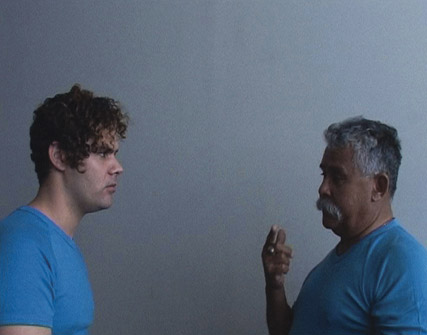
Christian Thompson, The Sixth Mile
MHUL, MEANING IDEA OR CONCEPT FOR THE CENTRAL QUEENSLAND BIDJARA PEOPLE, WAS THE TITLE OF THE INDIGENOUS IDEAS WORKSHOP AT THE AUSTRALIAN CENTRE FOR THE MOVING IMAGE (ACMI) IN MELBOURNE.
Organized by artist and curator Christian Thompson, this five-day workshop brought Indigenous artists from all over the country together to discuss and constructively critique each other’s work, as well as engage with the practices of contemporary artists in Melbourne. Fiona Foley, Gary Lee, r e a, Jenny Fraser, Karen Casey and Dianne Jones joined Thompson at ACMI to address pertinent issues for Indigenous practitioners, such as the current reception and positioning of their work in national and international art worlds, institutional collecting practices, the significance of global Indigenous artists’ networks and the future of contemporary Indigenous arts practice.
The second day of the workshops featured the Mhul Conversations, an all day public symposium where the artists provided audiences with insight into their past and recent art projects. In ACMI’s screen pit, Melbourne-based Dianne Jones spoke about her Mona Lisa photomedia series, which was commissioned by the Centre for Contemporary Photography (CCP) for last year’s Black on White exhibition. Presented with a brief to explore the ways in which Aboriginal people see non-Aboriginal people (do they see non-Indigenous Australians as ‘Other’?) Dianne responded by interviewing her nephews and nieces, who each have a black and a white parent. It turned out that they perceived themselves as living in between Indigenous and non-Indigenous cultures, unable to express their feelings. The artist explains: “These kids have always been told they are Nyoongar, but no one ever asked them how they felt about their non-Indigenous heritage.” Wishing to override the binary opposition between black and white, Dianne subsequently placed her nephews and nieces within Da Vinci’s Mona Lisa painting. She remarks: “many people have speculated about Mona Lisa’s identity but, so far, have been unsuccessful in determining who she (or he?) is.” Focusing on the beauty in her subjects, the artist celebrates the ambivalence of their cultural identities, effectively rejecting straightforward representations of black and white.
In discussing his photographic practice Gary Lee, an artist from Darwin, showed his ability to actively engage the audience with humour, but without being consciously funny. His series Nice Coloured Boys (the title is inspired by a Tracey Moffatt work) which Gary commenced in 1994, currently contains over 700 images. Photographing men during visits to India, Nepal and Bangladesh, the artist allows his subjects to choose their pose while he focuses on their beauty. At times the photographs, some of which show men exposing themselves to the camera, enticed laughter from the audience. However, the conceptual premise of these works is far from laughable. Lee laments the lack of imagery in our daily lives of sexy, beautiful, perhaps even desirable ‘coloured men.’ Having recently extended his practice by taking pictures of good-looking, young Aboriginal men, the artist challenges preconceived notions of black sexuality, beauty and what he describes as “the fear of desirable coloured boys.” Interpreting recent rejections of his work by Australian exhibition venues as a result of “the inability of white people to deal with black beauty shoved in their face”, Lee illustrates in his paper some of the constraints currently faced by artists in the Australian art world.
Christian Thompson, whose work was on show both at CCP and the Shrine of Remembrance, also deals with constraints in his recent video art, albeit of a different kind. Previously the artist was known for his work in photography; many of us remember his 2003 Emotional Striptease images in which Indigenous Australian models posed in front of renowned art institutions in Melbourne. Dressed in Victorian clothing while holding Indigenous cultural objects such as boomerangs and a nulla nulla (a deadly weapon), the models defiantly returned the camera’s gaze and recreated a presence for themselves in colonised and institutionalised spaces. However, over the past months a shift has occurred in the artist’s practice. From extrovert photographic work through which Thompson sought to establish his presence and identity as a Bidjara man, he has moved into making more introspective, intimate works in real time.
The new video work on display as part of his Sixth Mile show at CCP presents the viewer with a very intimate, family ritual. We see Christian and his father involved in what could be interpreted as a greeting ceremony. Speaking in Bidjara, their bodies turned towards each other, the men are engrossed in acting out the same gestures repetitively. The non-Bidjara viewer, who can’t understand what is being said, is nonetheless invited into this private space of communication and learning between father and son. The artist explains that this work follows on from earlier videos that similarly focused on Bidjara rituals, made visible by means of a Western visual language. It forms a response to the increasingly conservative government policies and, in particular, to the recent media coverage of dysfunction in Indigenous communities, something described by the artist as “Aboriginal man-bashing.” Choosing video because of its potential for direct and intense audience engagement, Thompson offers insight into Indigenous rituals and notions of masculinity and father-child relationships in personal and challenging ways.
Other significant issues arose in the symposium, provoking discussion with the audience and amongst artists about what constitutes Indigenous Australian art; what kind of creative expression is expected from Aboriginal artists in art worlds; the importance of art in supporting Indigenous communities, whether through the creation of positive representations or by involving community members in the art making process; and the exploration of digital media and the ways these can be incorporated into art practices. The symposium in combination with the Mhul Workshops for the artists was an opportunity for Indigenous practitioners to exchange a broad range of ideas, experiences and knowledge with audiences and each other, away from the public gaze. As such, it formed a unique event.
–
Mhul Workshops, Oct 30-Nov 3; Mhul Conversations, Oct 31; Australian Centre for the Moving Image; Christian Thompson, The Sixth Mile, Centre for Contemporary Photography, Melbourne, October 27-Dec 16
RealTime issue #76 Dec-Jan 2006 pg. 54
© Marianne Riphagen; for permission to reproduce apply to realtime@realtimearts.net
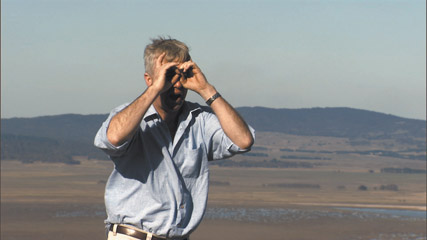
A Lake Without Water
THE HEADLINING PROJECT IN ARTSPACE’S VIDEO, MOVING IMAGE, SOUND AND PERFORMANCE SEASON WAS A LAKE WITHOUT WATER BY ALEX KERSHAW WITH VIDEO ARTIST SCOTT OTTO ANDERSON AND SOUND DESIGNER GAIL PRIEST, A MESMERIsING MULTI-CHANNEL VIDEO INSTALLATION EXAMINING THE CONTENTIOUS NOTION OF LAND OWNERSHIP AND EXPLOITATION, SHOT ON LOCATION AT WEEREEWA, THE DRY LAKE GEORGE IN THE SOUTHERN TABLELANDS OF NSW.
On this site, Kershaw staged an ambitious, Brechtian-influenced exploration of the land and its maligned uses, involving local farmers, property surveyors, a musician and an auctioneer in performances, ambiguous actions and partially decipherable monologues. Comprising three large-scale projections, two smaller projections onto custom-built tables, and three more LCD screens, the installation envelopes the audience with a virtual sense of environment, occupancy and complicity.
In one dream-like steadycam sequence, the viewer/camera perspective appears to float between the banks of a dry riverbed, around labourers planting trees too close together on its sandy bed. Like an overzealous gesture towards reforestation, the trees are placed where even weeds couldn’t grow. An adjacent projection shows two men in Akubra running down a moss-covered, rocky hill scattering plan-sized paper at their feet. While the journey down is fast, the trudge back to the top is symbolically and physically gruelling. Cleaning up the mess is amplified by Priest’s soundtrack of crunching paper. On the far wall of the installation, two LCD screens display looped performances; in one an auctioneer calls a horse race into the empty valley, while in the other a red-uniformed bugler plays a tune into an empty water tank. While these recorded performances have an absurdist element, the parched nature of the landscape and the hollow resonance of the soundtracks also lend the installation an overriding sense of desolation.
Two projections of Weereewa from the air are cast down onto table-tops, panning across the landscape like frames from Google Earth. In these sequences, drought and salinity leave decorative, graphic marks in the landscape. From the air, farms look like geometric abstractions, punctuated here and there by the appearance of white-rimmed, black welts of salt that have risen to the surface of the earth. Conceived during a time of rising alarm about Australia’s ability to sustain its farming industry and adequate water supplies for its populace, A Lake Without Water is a timely meditation on propriety, planning, speculation and the mythopoeia of struggle in the Australian landscape.
In the entrance gallery, Canberra-based artist Elvis Richardson constructed a helix-shaped column of unwanted domestic videotapes with hand-written titles such as Rex Hunt’s Fishing 1995, Time Cops, Tarzan, Big Brother and an Australian Bicentennial Authority Community Presentation—a reminder of the technological advancement and uses of the medium.
Richardson’s work was part of Tomorrow, again, a selection of 20 video and documented performance works (recorded from a live performance night, October 27) curated by Scott Donovan. The project showcased the work of Australian and international multimedia practitioners in Artspace’s entrance, reading space and ante room. A large projection of Ronnie van Hout’s I’ve Stopped Trying (2003) in the main space featured various camera angles of the artist lying still on a sports oval wearing a blue tracksuit, sneakers and only just visibly breathing. The work set a tone of quiet antipathy that was echoed in Justene Williams’ Photo Me (2006), a video self-portrait of the artist-as-photo booth, regurgitating images from her mouth, and French-Algerian artist Hakeem B’s Just Do It (2002), a video of an angry young man speaking an un-subtitled dialect, followed dryly by a recipe for making couscous. In Carla Cescon’s Portrait: An Autobiographical Narrative (2006), a woman poses sweetly in front of a video camera using infra red light before being roughly slapped off her chair and labeled a “vampire”, a placard stuck into her vagina.
Tony Schwensen’s documented live performance, Trans-Scandinavian, shows the artist attempting to assemble an IKEA wardrobe wearing only his trademark saggy shorts while two women read the instructions in Swedish. Schwensen’s construction appears to halt at a point where the wardrobe exhibits some potential—it could be anything from a wooden chest to a coffin. Vicky Browne’s two gold and silver sculptures continue this critique of pointless consumption by repurposing obsolete personal stereo technology into glittering kinetic objects. One device scrapes the needle of a record player around a CD, while the other uses old Walkmans to spin a groove into an empty deck.
In the back room, West Australian artist Michelle Theunissen’s solo project, Elastic Boundaries, provided an emotional counterpoint to the coolly subversive undertone of Donovan’s curation. In this gently uplifting installation, two super 8 projections screen original footage of the artist’s daughter flying and back-flipping within its frames. Subtle differences can be discerned between the younger girl and her older self, while a third video projection on the floor captures the young woman in changing costumes, grounding her to a sense of social expectation. Theunissen brought to Artspace’s audiovisual season a focus on a personal experience of transformation.
A Lake Without Water, Alex Kershaw with Scott Otto Anderson, Gail Priest; Tomorrow, again curator Scott Donovan; Elastic Boundaries, Michelle Theunissen; Artspace, Sydney, Oct 27-Nov 18
RealTime issue #76 Dec-Jan 2006 pg. 55
© Bec Dean; for permission to reproduce apply to realtime@realtimearts.net
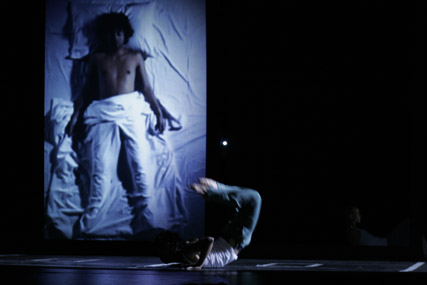
Blind Date
photo Paul B. Goode
Blind Date
In retrospect, despite some strangely negative reactions in the Melbourne press, the 2006 Melbourne International Arts Festival succeeded in creating an atmosphere that was at once embracing and open. Aside from the performances, it kept its audience continuously stimulated in and outside theatres and galleries with symposiums, lectures, spontaneous speeches, bands and parties, post-performance and panel discussions, archival video and reference materials, lengthy program notes and reviews. This gave anyone interested in how the artists were thinking about the world and how it translated to their art the opportunity to participate.
sakamato & noto
In Insen, the connection created between Ryuichi Sakamoto with his pin-drop timing at the grand piano under a single spotlight and Alvo Noto at his computers housed in a mirrored horizontal obelisk lulled me into a soporific stupor then jarred me with dissonant explosions and light from an oblong screen spanning the space between them, and the vast historical transformations their instruments imply.
marie brassard
Reminding me of an Eartha Kitt song, in a carefully contained performance Marie Brassard’s solo, Peepshow, tantalized with a psycho-literary exploration of control from the perspective of Little Red Riding Hood. From the first trauma of being put into the ‘wrong’ group at school, we are taken through repeat meetings with various male manifestations of the monster and the wolf. Performed with a phaser-effect on her voice so she can perform man, woman and child, it seemed the highly protected landscape inside this person could only be traveled by a therapist, or series of therapists who, just like daddy, provided all the little girl could want. Brassard is clever and funny, manipulating stereotypes to lightly brush guilty nerves.
bill t jones
The Bill T Jones/Arnie Zane company in Blind Date produced a lavish political dance which cast the thirsty addiction of the multinational North American military enterprise into multiple and fragmented ironies. Among its many penetrating observations: a childhood memory of Turkish dancer Asli Bulbul of boys at school playing a game where they would grab each other’s testicles and only release them when the national anthem had been whistled, and then the refrain about “fourth generation warfare being widely dispersed, nonlinear and with indefinable battlefields, in which distinctions between war and peace, civilian and military may disappear.”
romeo castellucci
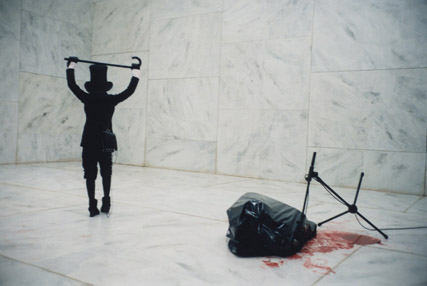
Br.#04 Bruxelles, Tragedia Endogonidia
photo Luca del Pia
Br.#04 Bruxelles, Tragedia Endogonidia
By contrast, despite a diverting debate about the use of actors or non-actors, Romeo Castellucci’s Tragedia Endogonidia: BR.#04 Brussels produced some densely reduced images: an African cleaner in a maid’s outfit mopping the floor in a marble room aka the European Union, a white baby being taught by a robotic tutor, a bearded old man in a bikini no longer having the strength to lift his own weight wrapping himself in cloth inscribed with Hebraic script followed by a policeman’s uniform. The old man’s younger colleagues perform the act of beating a man with truncheons, cordoning his bloodied body like a crime-site and stuffing him in a bag in front of a microphone for us to hear his groans. The old man ‘dies’ in bed and a young boy-master with a cane, top-hat and what in silhouette appears to be a duck mask, struts on to pull out a tooth from the gum of a woman whose hair is falling out and to break a fluorescent light with impunity. The African woman returns in a gown from the 19th century; Moses’ tablets, which have been kicked over in the violence, hang from the ceiling in relief with hair coming from them; and out-of-focus credits roll.
dumb type
After interviewing dumb type (RT 75, p6) and seeing Voyage, and unlike those who seemed to find the performers’ investment out of balance with the technical production, I found most scenes—words dropped upon bodies to tolling electronic pings, an idle woman on a fake grass island floating among glaciers and speaking her innocent dreams in English—to signify a critical perspective. Even the daggy caving metaphor for the two women struggling to find each other in the dark at the beginning of the show was in irreverent contrast with the icily efficient perfection of the projected crystalline images of the all-seeing satellite surveillance imagery and ultra-slim lines of the solo dancer’s pointed limbs at the end.
yamazaki kota
Yamazaki Kota’s unsubtle choreography of the Australian dancers in graceful balletic symmetry combined with grotesquely blunt actions in Chamisa 4?C was a courageous attempt to represent a very real paradox: the yellow wall of light with a swinging light bulb framed by a mini-proscenium; sudden exposures of light and high wind from an off-stage fan; a woman in black in front of a full-length mirror and bodies standing with their dripping hands outstretched. The latter image was in unintentional solidarity, although with important differences which cannot be disregarded, with the deep pain of the radiation poisoning of Trevor Jamieson’s people from the land around Maralinga described in big hArt’s Ngapartji Ngapartji.
Melbourne International Arts Festival: Ryuchi Sakamato & Alva Noto, Insen, Hamer Hall, Arts Centre, Oct 12-14; Peepshow, devisor, director, performer Marie Brassard, music & sound design Alexander MacSween, design, lighting Simon Guibault, Malthouse Theatre, Oct 24-28; Bill T Jones/Arnie Zane Dance Company, Blind Dates, State Theatre, Oct 25-28; Societas Raffaello Sanzio, Tragedia Endogonidia: BR.#04 Brussels, direction, design Romeo Castellucci, writings, direction, vocal, sound, dramatic score Claudia Castellucci, original music Scott Gibbons; Malthouse Theatre, Oct 12-15; dumb type, Voyage, Playhouse, Arts Centre, Oct 18-20; Kota Yamazaki, Lucy Guerin, Chamisa 4ºC, Beckett Theatre, Melbourne, Oct 25-28
RealTime issue #76 Dec-Jan 2006 pg. W
© Adam Broinowski; for permission to reproduce apply to realtime@realtimearts.net
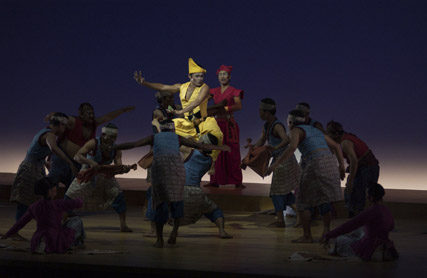
I La Galigo Production
courtesy Esplanade Theatres on the Bay, Singapore
I La Galigo Production
ROBERT WILSON’S I LA GALIGO IS THE FIRST KNOWN THEATRICAL STAGING OF AN ANCIENT EPIC POEM OF THE BUGIS PEOPLE CONVEYING THE CREATION MYTH OF SOUTH SULAWESI, INDONESIA. IT DESCRIBES HOW THE GODS OF SKY AND SEA COLONISE MIDDLE EARTH—A SAGA OF INCESTUOUS TWINS REMINISCENT OF THE NIEBERLUNGENLIED.
I was pleased this was a major avant garde engagement with an Indonesian regional classic instead of the endless parade of Javo-Balinese intercultural collaborations. It was a sumptuous, expansive (and expensive) display of clever stagecraft. There was much to be admired —wit, flair, grandeur, cuteness and kitsch. There are wars, sea voyages, spurned love, and traitorous cats, played out with trademark Wilson precision against a colour-saturated cyclorama. At three hours 15 minutes it was not so much slow as laboured – repetition and symmetry without counterpoint moving from the hypnotic to the predictable.
The undeniable triumph was Rahayu Suppanggah’s robust score, a sensitive and knowledgeable blend of pre-Islamic music and original concepts. Female vocalists sang from the original text, segueing from the raw timbral quality of the Bissu into sweeter tones of modern folksong. Whilst Suppanggah’s use of a pan-Indonesian selection of instruments never felt like a geography lesson, the dances were less subtle. I wondered how they differed from sendratari, the modern dance-dramas influenced by Western staging? And if they didn’t then what was Wilson’s distinctive contribution beyond overall production values? The contemporary wave of Indonesian choreographers has moved beyond the telltale cliches of that dated genre and created internationally regarded work without bypassing their complex relationships with a multi-layered social reality.
Wilson preferred a superficial and linear treatment of the great cosmic plot without reference to the conditions of its existence, privileging instead his painterly images. Many raved about the great sarong birth scene, but manipulating lengths of cloth to make multiple meanings is a developed art form in Indonesia. To me the more impressive device was the exquisitely efficient murder of the songket-weaving sentinels. That use of contained potency was thrilling.
Elsewhere the Wilson idea of hypnotic stasis seemed pushed to the brink of histrionics. Mannered posturing forced into rigid tableaux and feigned dialogue with eyebrows seemed more Manchu than Malay, or perhaps derived from the high formal tone and austere aesthetics of Noh. The cockfight was closer to home—cloth chickens animated with flair and style in a familiar atmosphere. This was the real thing—the acting both natural and spontaneously stylised and as naturally potent as the dance of septuagenarian Mak Coppong, the only traditional performer besides the Bissu priest, and distinct from the urban academy-trained artistes of the company.
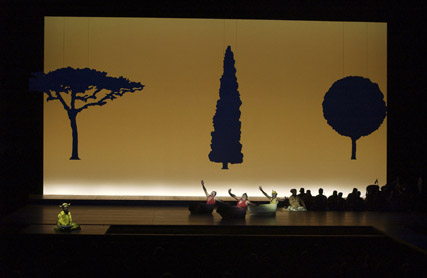
I La Galigo Production
courtesy Esplanade Theatres on the Bay, Singapore
I La Galigo Production
The Bissu remains external, his role peripheralised, reduced from storyteller to ritual janitor—just the man with the keys. As a shamanic journey, the work provided no closure, no ritual resolution to return us to this world, bracketing it instead with the theatrical device of procession —as if we view another audience returning from whence they came.
Whilst Wilson abandoned his desire for an international cast in response to the voice of cultural politics, ensuring the project provide abundant opportunities and benefits for Indonesian artsworkers, on reflection he might have been well advised to follow his instincts.
In the past Wilson has used his devices to defamiliarise, but here he starts with the unfamiliar. Without a shared grasp of underlying meanings his beautiful pictures are bereft, bearing none of the patina of the 14th century hand-inscribed manuscripts which remain the source inspiration. Rich with illuminations, there is nothing clinical or austere in the patinaed pages of Wilson’s source. Yet from his long opening procession of silhouettes to the final reprise one is struck by the austere Wilson aesthetic and high formal tone. And in terms of the oral epic recorded therein, a poetic play of words and imagination full of lexical ornamentation, embellished over centuries of oral transmission, it makes a strange match for a director renowned for his rejection of words and textual meaning.
I La Galigo, director, set and lighting concept Robert Wilson, text adaptation and dramaturgy Rhoda Grauer, music: Rahayu Supanggah, Bissu priest Puang Matoa Saidi, costumes Joachim Herzog, lighting AJ Weissbard, producer Change Performing Arts, Bali Purnati Centre for the Arts, State Theatre, Victorian Arts Centre, Melbourne International Arts Festival, Oct 19-23
RealTime issue #76 Dec-Jan 2006 pg. W
© Indija Mahjoeddin; for permission to reproduce apply to realtime@realtimearts.net
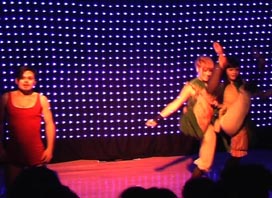
Dreamland
Ivan Thorley’s Dreamland depicts what happens when an individual’s illusions, manufactured by an entity ensconced in a high-rise office, fall apart. The stark contrast between the dynamic italicised title, Dreamland, scrolling along the back wall (the innovative invention of Olaf Meyer) and the melancholic inertia of the protagonist (Leon Ewing), a faded performer who had once dreamed of a stadium full of fans, creates a certain alienated domesticity which permeates the show. Told through music, scenography, dance and recorded voice-over, this is the story of a queer punk who seems to have awakened to his life as a semi-skilled and somewhat jaded clown.
We initially meet him as he sits with us in the audience. His woes are writ large in the text he speaks to us in the dark—tired thoughts of an entertainer from the Cobain generation walking the blunted knife-edge night after night for a demanding ‘here we are now, entertain us’ audience. Canned applause follows. We follow him in his saggy strong-man unitard and grease paint into this world of no meaning, of ‘unreason’, of endless distraction where “cause and effect are unfashionable.” His scorn is pretentious: “What audiences put up with! In Europe they would have left by now.” Following an amusing, bitter confession regarding his lack of public recognition and delivered via his alter ego, a deep-ocean fish puppet, we are presented with familiar brattish dissatisfaction, which will doubtless become a psychological disorder. Simultaneously obsequious and inflated, the iconic despairing clown plays out the thwarted celebrity phantasies of our late capitalist entertainment industry.
Yet we suspect there must be a deeper cause for his ennui. In a flashback, a mimed story of love on bended-knee and heartbreak is played. The clown’s ‘heart’ in the form of a stuffed doll is presented to dancing showgirl twins (Holly Durant, Amber Haines) who then squabble over and dismember it. It becomes a voodoo doll, and the man-boy clown falls apart. As the conjoined girls writhe on the floor, he proceeds to pound the puppet with his bass-guitar. Any sense of hubris defeated is circumvented by the listless tone of cartoon horror modeled on the work of Dave Louapre (Beautiful Stories for Ugly Children, etc). Nothing is authentic. Truth is a commodity. Life is only worth living if it is represented on the screen. These phrases seem to run through Dreamland suggesting the side-effects of the aimless malaise of comfortable consumer culture.
Thorley quotes Mark Dery (in turn quoting Marshall Blonsky): “[the audience] can control the message and its multiple possibilities of interpretation…restoring a critical dimension to passive reception.” However, Dreamland is as yet in the initial stages of an experiment in form and ‘post-dramatic’ story-telling. Although Thorley aims to “incorporate political advocacy” along the themes of “ecology and sustainability”, these larger issues are yet to be exhumed from the veneer of gormless distraction Dery writes about. Had the clown been more sharply drawn, had the twin dancers taken more agency, had the sources of delusional misspent youth been explored beyond the realms of the personal, the cute aesthetic might have offered the potential to subvert the forces of oblivion. Dreamland can go further yet.
Dreamland, devised by Ivan Thorley, performers Leon Ewing, Holly Durant, Amber Haines, visuals Olaf Meyer; developed at CultureLAB, Arts House; 2006 Melbourne Fringe Festival Hub, North Melbourne Town Hall, Sept 29-Oct 6
RealTime issue #76 Dec-Jan 2006 pg.
© Adam Broinowski; for permission to reproduce apply to realtime@realtimearts.net
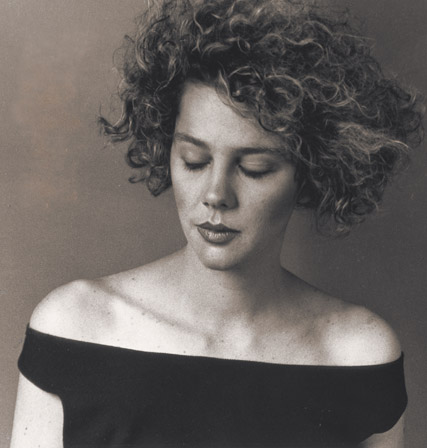
Michael Riley, Hetti, 1990
courtesy of Mr Pat Corrigan
Michael Riley, Hetti, 1990
IT’S DIFFICULT TO CONVEY THE EXPANSIVE FEELING WHEN CONFRONTED BY MICHAEL RILEY’S CLOUD (2000) SERIES. THERE’S A SENSE OF SUDDENLY BEING SHIFTED TO ANOTHER PLANE—A WORLD OF DELICATE, EPHEMERAL VISIONS AND STARTLING TAXIDERMIC ARREST.
The background of each image is the deep blue Australian sky, flecked with patches of white cloud. A different object or creature appears in every picture, suspended mid-air and sharply delineated from the soft blues and whites of the background. A locust is seen in extreme close-up, as if mounted in a scientific display case. A cow grazes in the sky. An open bible floats earthward, face down. Most iconic of all, a feather blown up to enormous size is captured with such fidelity that every strand appears rendered in loving detail. The Cloud series stands as Riley’s final photographic statement, created shortly before he passed away in 2004, claimed like so many Indigenous Australians by disease brought on by the effects of childhood poverty. But the National Gallery of Australia retrospective, Michael Riley: sights unseen (touring the eastern states into 2008), provides audiences with a chance to place Riley’s best-known work in the context of his broader photographic and filmic career.
In rough chronological order, the exhibition begins in Sydney in the early 1980s, not long after Riley moved to the city from Dubbo. Having revived his teenage interest in photography and studying under Bruce Hart at the Tin Sheds Gallery, Riley began photographing Indigenous rallies and events in Sydney and Melbourne. These first pictures are somewhat rudimentary, but provide a fascinating glimpse into the energy and anger fuelling Aboriginal activism at the time. As well as passion, there is a sense of optimism and empowerment, generated by the mobilisation of people and ideas. From a contemporary perspective Riley’s images speak of a history that has been systematically concealed by the whitewash of the Howard era.
The shift between the photojournalistic style of these early colour works and Riley’s studio-based portraits of the mid-1980s is startling. The marches and everyday activities are replaced by highly stylised fashion-influenced images of Koori women in luminous high-contrast black and white. These represent an obvious but important intervention in the politics of representation, reworking images of beauty and ‘cool’ in the mass media to celebrate the spirit, sassiness and diversity of Indigenous women.
It’s not just the Indigenous subjects—all members of Riley’s social circle—that mark these early portraits as a break with the conventions of fashion photography. Photographs like Kristina (no glasses) (1984) see Riley’s friends coolly returning the camera’s stare, meeting the eye of the viewer with a steadfastness that is the opposite of fashion photography’s objectifying gaze. Even when these women don’t look directly out from the image, as in Tracey (head down) (1986), there is a feeling of mutual complicity and trust, a strong impression that the subjects are participating in their own representation rather than being rendered as fetishised objects of display. It is perhaps indicative of how little has changed that these photographs still seem a radical intervention in the order of images today.
As Riley pursued his interest in portraiture throughout the 1990s, the high contrast black and white of the mid-1980s was replaced by more graduated tones and simple backdrops. His skill became more subtle and less stylised, but the shared exchange between camera and subject was only enhanced by the apparent simplicity and casual air of series such as A common place: Portraits of Moree Murries (1991) or Yarns from the Talbragar Reserve (1998). The Moree series depicts Indigenous people from Riley’s mother’s country, while Riley himself spent his early years at Talbragar Reserve outside Dubbo. Just as his first studio-based portraits evoke and rupture the objectifying gaze of fashion photography, these images of Indigenous people are an understated riposte to the tradition of Western ethnographic studies. Riley’s documentary films Quest for Country (1993), Blacktracker (1996) and Tent Boxers (1998) can be read as companion pieces to these series, giving voice to some of the tales etched into their subjects’ faces.
Riley’s 1990 series Portraits by a Window is for me the most moving of his work in this genre. Comprising friends and their families lit by diffuse light from windows in the Boomalli Aboriginal Artists Co-operative building in Chippendale, Sydney, the series forms a fascinating record of prominent Sydney Indigenous figures of the time, including Tracey Moffatt, Djon Mundine, Brenda Croft and the Perkins family. A photograph of Charles Perkins, posing with his son Adam, is rendered poignant by his death a decade later from renal failure—the same disease that was to claim Riley. Perkins’ daughter Hetti is captured in one of Riley’s most tender frames, casting her eyes downward in an image of grace that feels both fleeting and timeless. My favourite is of the young dancers Tracey Gray and Alice Haines. All the elements of Riley’s portraiture seem to coalesce in this image: the steady gaze into the lens, the pose that is both casual and highly composed, and a beauty that emanates from the women rather than being constructed by the camera.
In the late 1990s, Riley’s colour photography took on a more abstract tone, as he began to photograph landscapes, skies and bodies of water. As in his portraits, these images of the physical world never present a distanced, objective view. Works like Spirit clouds (1997) picture Australia’s environment as a living, breathing space of constantly changing patterns, spirits and emotions—a natural world infused with an Indigenous Australian perspective. Djon Mundine writes in the Sights Unseen catalogue that Riley’s work “is not a surface recording but an allusion to the spiritual within the land and his attachment to it.” Again, there is a clear link here with Riley’s films, which in different ways explore the Indigenous histories and perspectives inscribed into the Australian landscape and its scarring by European presence.
The Flyblown series (1998) embodies Riley’s “spiritual vision of landscape from within” (to quote Mundine again) and illustrates several key motifs running throughout his later work. The painterly sky-scape Untitled [blue sky with cloud] continues Riley’s interest in the ephemeral formations of the Australian environment. The grim still life Untitled (galah) depicts a bird’s corpse spreadeagled on a patch of baked mud, testament to a harsh environment made harsher by mismanagement and abuse. And Untitled (bible) shows a crucifix-embossed book lying face down in water, part of Riley’s ongoing reflection on the ambivalent relationship between Indigenous Australians and the Christian church. Especially when viewed alongside Riley’s film Empire (which was shot at the same time and shares several common images), Flyblown constitutes a sensitive but unsettling portrait of the Australian environment and the alien presence of Europeans within it.
Riley’s final series, Cloud, combines his exploration of transient cloud formations with the astonishing presence of decontextualised objects rendered with such exactitude they seem totally unreal. There’s a sense of hope and liberated possibility in this series, and its placement at the end of the retrospective marks it as the culmination of Riley’s achievements. But there’s also an air of sadness around these images, borne of the knowledge that Riley himself is no longer here to explore the imaginative vistas opened by his final work. Riley was only 44 when he died—instead of an ending, Cloud should have marked the beginning of a mature vision.
Part two of this article in RT77 will focus on Michael Riley’s films.
–
Michael Riley: sights unseen, curated by Brenda L Croft, National Gallery of Australia, Canberra, July 14-Oct 16; Monash Gallery of Art, Vic, Nov 16 2006-Feb 25 2007; Dubbo Regional Gallery May 12-July 8 2007; Moree Plains Gallery, May 19-July15 2007; Museum of Brisbane, July 27-Nov 19 2007; Art Gallery of NSW, 22 Feb 22-April 27 2008
RealTime issue #76 Dec-Jan 2006 pg. 20
© Dan Edwards; for permission to reproduce apply to realtime@realtimearts.net
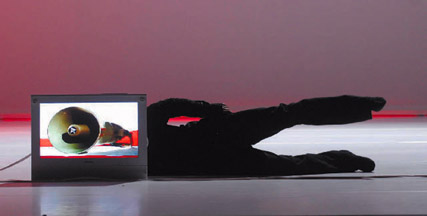
Ballet de l’Opéra de Lyon, Superstars
photo Michel Cavalca
Ballet de l’Opéra de Lyon, Superstars
LYON’S 2006 IMMERSIVE BIENNALE DE LA DANSE IS its TWELFTH. THEMED AROUND THE EXPERIENCE OF LIVING IN CITIES IT IS STAGED in an AMIABLE CITY IN LOVE WITH DANCE. WE WITNESSED ONE WEEK OF A THREE WEEK DANCE PROGRAM THAT EMBRACED THE WHOLE OF LYON, FROM THE CENTRE TO THE SUBURBS AND SURROUNDING REGIONAL TOWNS AND A COMPLEMENTARY PHOTOGRAPHIC EXHIBITION, DES CORPS DANS LA VILLE (THE BODY IN THE CITY), INVOLVing 32 GALLERIES, FROM IMPROMPTU SPACES TO THE MAGNIFICENT LYON MUSEUM OF CONTEMPORARY ART.
In turn the dance biennale was embraced by large audiences from the city to its the periphery, for example at Le Toboggan, an impressive arts centre where we saw Australia’s Force Majeure play to a receptive full house on the last of its three packed performances. The Sydney-based company, directed by Kate Champion, was the first Australian company to be invited to the Biennale.
The intensity of this festival of dance and its public involvement was more extensively revealed in the Défilé—a 3 hour pageant in which some 24 groups of citizens from the suburbs and surrounding towns displayed a range of dance styles on and around floats often incorporating musical performance involving DJ-ing, contemporary brass bands playing fine progressive compositions, and found object ensembles (favouring large plastic water bottles). Each group works with a choreographer and designer, is funded by the city and draws on additional resources according to its ambitions. The makeup of the groups ranges across age, ethnicity and ability and all made good use of the metres of material supplied by local manufacturer sponsors in a region famous for its textiles. Each group presented a commentary on the idea of the city—utopia, distopia, fantasia—employing diverse devices, forms and images—cycling, recycling, modern dance, hip hop, art history (the Bauhaus body as city) and the history of city clothing, from elegant medieval to 20th century Chaplin, to hip hop armies and sci-fi glitter and transparency. Public fancy dress inventiveness was also on rich display at Bal Bollywood, an evening of Bollywood dancing DJ-ed, performed and taught from the stages of a massive suburban nightclub.
Lyon’s Biennale de la Danse emerged in the early 80s from the vision of the director of the city’s Maison de la Danse, Guy Darmet. Darmet’s energy, charisma and the biennale itself are said to have convinced the citizens of Lyon once and for all that they are not the dour cultural inferiors of Paris but the Latins of France. This was in evidence as this easy-going city threw itself into Défilé and Bal Bollywood and packed theatres and studios for the wide-ranging dance experience programmed by Darmet and Assistant Programmer Sylvaine Van den Esch.
We arrived in Lyon when the festival had been underway for a week, and after our departure there were companies like Les Ballet C de la B we regretted having to miss. Even so we had a packed program, sometimes seeing several shows a day but even then finding by word-of-mouth that we’d missed something significant, for example architecture-trained Julie Desprairies’ (Compagnie desprairies) site-specific performances, Là commence le ciel. In Desprairies’ work people are incorporated into nature, buildings, freeways; bodies become part of their environment. The word was good also on Tokyo choreographer Kim Itoh’s take on a butoh classic, Kin-Jiki, and Nacho Duato’s Multiplicite: Formes de silence et de vide for his Madrid-based National Dance Company. There was a lot of excitement about the eight-strong local Pockemon Crew who’d been “taken from the portico of the Lyon Opera House to the Maison de la Danse.” The portico has become a permanent public venue for hip hoppers and break-dancers as audiences weave their way to performances in the house.
The Lyon Opera House is a 1756 building in the heart of the city strikingly renovated in 1993 by Jean Nouvel who also designed the Musee du Quai Branley in Paris. Here he added a new arched steel and glass upper level housing, amongst other facilities, rehearsal studios looking out over the city. Nouvel’s interiors have a rich, dark, immersive quality: black marble; escalators; metal walkways; an ominously bulging fibreglass sculpture like a black cloud; and the whole place suffused with soft orange light. Oddly, the same orange stares at you from a bulb in the back of the seat of the person in front of you in a theatre with a huge stage but an intimate auditorium with six levels of shallow balconies, the whole mostly in black and with a gun-metal sheen.
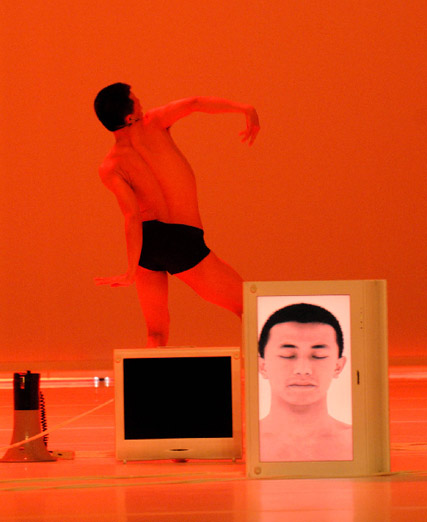
Ballet de l’Opéra de Lyon, Superstars
photo Michel Cavalca
Ballet de l’Opéra de Lyon, Superstars
ballet de l’opéra de lyon: rachid ouramdane
We’d heard that Yourgos Loukos, Director of Dance at Ballet de l’opéra de Lyon, runs a strong program, consistently inviting, progressive choreographers work with his dancers. Loukos writes, “although a classical formation, (the company) is oriented towards contemporary dance; given the wide range of dance styles proposed, the artists acquire many different techniques”. In a typical year, guests include Trisha Brown, Mats Ek, De Keersmaeker, Russell Maliphant, Sasha Waltz.
But the choice of young French choreographer, Rachid Ouramdane, for the Opera’s contribution to the Biennale was seen as particularly bold. Ouramdane’s Superstars shared the bill with New Yorker Tere O’Connor’s Creation.
In Superstars, a massive white box fills the huge stage littered with six Macintosh computer screens of different sizes and two white loud speakers. Guitarist Alexandre Meyer, also dressed in white, mixes his own sound from the side of the stage and traverses it as he plays. The work is a series of solos in which the dancers from the Opera Ballet express aspects of their lives. The challenge for us was that most of the speech was French without surtitles. A subtle force slowly flows through the poised body of the first dancer, vertically and then horizontally. Suddenly she speaks, in French, then briefly in English about the challenge of growing up white in South Africa, her words punctuated by great chiming guitar chords. Rapid upper body movements parallel her account of living with an albino sister in a culture distinctly black and white; hearing the everyday sound of rifle shots; sensing the power of an otherwise disenfranchised black culture when you’re the only white family in the district; and attending a Whites Only school. And learning what fear is. The dancer conveys a strange kind of stability as she vibrates with remembered trepidation. This dynamic sculpting of the standing body seems the foundation for most of the solos that follow and it’s matched by the architectural feel of the design, of a space slowly transformed by bodies and soft waves of coloured light (Jean-Michel Hugo) emerging from unexpected points of the space. Instead of elaborate dance we witness states of being. Overall, Superstars didn’t appear to head in any particular direction, each piece seeming complete in itself even where overlapping.
These solos by members of the resident company were based on childhood recollections and ranged through a variety of images including sport and cross-dressing. One of the more striking was of an angular, statuesque dancer in red holding her body in difficult poses for long periods, then lying on the floor, arching her back high to an organ-like guitar composition, the light narrowing into a pool around her. The show stood magically still. Superstars was a provocative work; despite the language challenge, it remains strong in the memory.
Tere O’Connor’s Creation also started out with a strong architectural feel, a large mass of bodies forming a block beneath a suspended row of dense curtains, another block of the same proportion. Small variations in group patterning and individual moves evolved in the crowd in various permutations of placement and displacement against the mutating design. But, disappointingly, Creation dissipated into something more waftily generic replete with literal game-playing, robotic moments ending with some very formal dancing against uninteresting flown-in wallpaper panels.
force majeure
We travelled to Force Majeure’s Already Elsewhere in the free bus to the theatre provided by the festival. On our way to Le Toboggan (Centre Culturel Ville de Décines) the landscape changed from old inner city to high-rise to two-storey suburban buildings till we were on the rural outskirts of the city. Force Majeure were programmed as part of the Centre’s 06/07 Saison Eclectique. Le Toboggan was but one of the performing arts spaces we encountered on our visit to Lyon that program boldly. The venue was spatially ideal for the work. Audience members and reviewers we spoke to were responsive to the concept, the design, the stylish realisation of the work and the skill of the dancers. For us it was good to see the work for a second time and with a very different audience and to admire its most sustained sequences, like the dynamic but nonetheless lyrical race of performers across the rooftop in pursuit of Kirstie McCracken, teacup and saucer in hand. The decision to translate substantial amounts of the spoken text (delivered by Veronica Neave) into French paid off. Already Elsewhere perfectly fitted the biennale’s theme of the body in the city, bringing a distinctly strong element to it, the sense of the suburban and the fragility and everyday fears of urban life.
cie l’explose
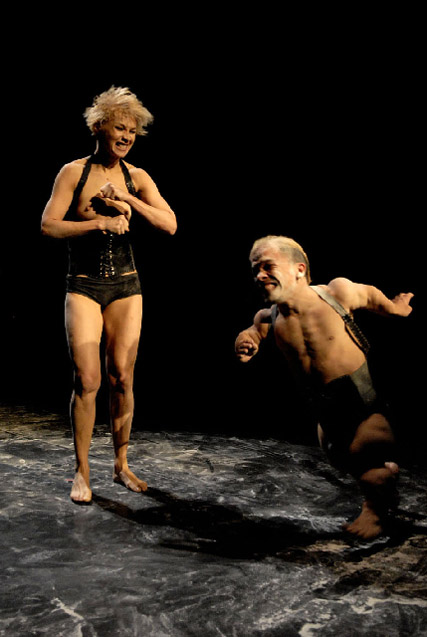
Cie L’Explose, Frenesi
photo Michel Cavalca
Cie L’Explose, Frenesi
Cie L’Explose from Colombia, performed Frenesi, choreographed by Spanish born Tino Fernández. Although inspired by bull fighting, the corida, this doesn’t become literal until the very end when a male dancer finally dons the costume of the matador and even then it’s symbolic. The work begins abstractly in the ritualised dressing and undressing and preparing of male bodies for an unspecified event. Four women lift and turn four naked men on gurneys and dump them unceremoniously on the floor. The first to come to life is a man of short stature whom the women dress in leather belt and buckles while the other men gradually dance to the sound of flamenco clapping. The short man topples the others and is subsequently involved in a cleverly sustained duet of pursuit and entwinement with one woman and a frustrated attempt to engage with another who stamps a raw, vibrating flamenco. He collapses, defeated. The women oil the men, their limbs hanging limply from the gurneys like scenes from some Francis Bacon butchery. Finally one emerges, slips into matador pants and dances triumphantly over a naked woman rolling downstage to us, raw meat tied to her body. Despite or maybe because of its curious sexual politics, but moreso because of its dramaturgy, Frenesi is an intriguing experience, offering a version of men, or rather one man, raised from the abject to the triumphant, overcoming women (and men of short stature). The bull no longer represents the horns of the male’s ambiguous relationship with the forces of nature—there are other more urban and domestic forces to contend with. The choreography was idiosyncratic, the manipulation of bodies almost always interesting.
Seeing this performance primed us for our first foray into cuisine Lyonnaise—mysterious meats preceded by very good oysters and washed down with a genteel Cote du Rhône.
atelia de coreografia
A less engrossing dance experience was to be had from Rio de Janeiro’s Atelier de Coreografia in ExtraCorpo, choreographed by João Saldanha. In the intimate Le Rectangle, we sat stiffly around the edges of a white space to experience an extremely formal set of variations with accompanying abstract gestures. Initially bodies appeared almost statue-like with limited fluidity, small spins and falls until, gradually, an increasingly flexible geometry emerged. This was a work of high modernism inspired by the choreographer’s association with Oscar Niemeyer, the architect of Brazilia. In comparison with Frédéric Flamand’s Metapolis 2, seen later, the relationship between architecture and choreography seemed vague at best. Occasionally there was welcome additional detail from two of the younger female dancers whose textured, rippling movements suggested something more than stark abstraction. The accompanying recorded music was suggestive of a dense primordial soup as the work moved towards its more complex, agitated conclusion.
selenographica
A cluster of smaller shows included Kyoto’s Selenographica in What Follows the Act in which the choreographer Maho Smiji appears in a chamber work of domestic surrealism, performing with Shuichi Abiru and an accompanying musician on flute and recorders in the western manner. This awkwardly staged work was eerie and quaint by turns with some resonances with the Noh play and Japanese ghost stories.
noland
Death also figured thematically in Noland’s Paper Ship. The young company from Istanbul fused an elegy for a dying patriach with a celebration of an emerging romance framed by city life. Dancers Esra Yurtlut and Alper Marangoz and video artist Burak Kolcu have created a work of modest scale, indistinct choreography and loosely integrated video images of Istanbul. Although the storytelling was at times overly literal there were some strong moments when bodies became entangled or toppled into each other, the characters struggling simultaneously with loving and grieving.
ballet national de marseille
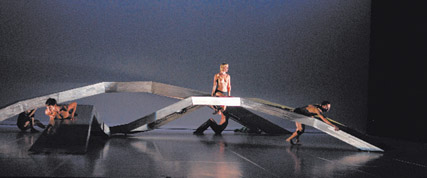
Ballet National de Marseille, Metapolis 2
photo Michel Cavalca
Ballet National de Marseille, Metapolis 2
Metapolis 2 is a fresh interpretation of an earlier work, Metapolis 1 by Frédéric Flamand, first performed in 2000. Flamand was formerly the director of Belgium’s Charleroi/Danse-Plan K but has taken over the Ballet National de Marseille.
For Metapolis, the internationally renowned Iraqui-British architect Zaha Hadid designed two mobile, asymmetrical bridges to be moved about by the dancers, to provide platforms but also spaces in which to insert performing bodies, as well as for the bridges to intersect, one riding over the over. The sheer scale of work is impressive: a large ballet company with seemingly unlimited means using architectural creations in conjunction with new screen technologies. The entire back wall forms a screen amplifying massively the movement of a foot straining against the slope of a bridge, or displaying the rush of filmed city streets against a running phalanx of onstage dancers matching the speed of vehicles. Images (some recorded, some live) are also projected onto the bodies of the dancers absorbing the city into their green-screen costumes. A male dancer lies on a green sheet on the floor, his movements projected onto the screen image of a traffic tunnel so that he appears to fly effortlessly through it. Dancers appear to fall into holes in the city.
Although Metapolis II reproduces much of what we know of the city experience—speed, congestion, mutability, vulnerability—and evokes its imprint on our lives as image and as states of being—alienation, romance, adventure—the sheer scope of the work, the number of scenes and devices threatens to make for a rather generalised response. What city? Any city. Likewise the ever graceful, fluent dancing within a framework that is often geometrically formal threatens sameness. Flamand has yet to invent a language as idiosyncratic and contemporary as Forsythe has for his ballet-trained dancers. However there are solos and duets and small moments of drama that break the mould, as do the sudden images that offer unexpected and privileged views of the city. A slice of city is projected on a dancer’s huge skirt while he is in turn projected, slowly turning 360 degrees, onto the big screen in a vertiginous dance of actual body, virtual body and camera eye.
In Metapolis II’s climactic scenes, black and white footage of street riots and demolition are screened, the dancers mounting Hadid’s bridges and watching—Flammand drawing, he says, on a Tiepolo painting of people looking into a world that frightens them. The work ends energetically and optimistically, maybe ironically, with energetic ensemble dancing against a fast trip through a huge digital city.
farruquito y familia
Our surprise festival experience was Farruquito y Familia. Although not usually enamoured of flamenco dance, we found ourselves swept along by this pared back Gypsy version of the form with its dressed down, raw power, precision, humour and informality. Juan Manuel Fernandez Montoya ‘Faurruquito’, still a young man, leads the family ensemble he inherited from the great Farruco (1935-1997), dances exquisitely, sharing the stage with brother and cousins and not least with his aunt and his mother, who arrives on stage late in the show with all the presence and power of the matriarch. Young local gypsies from the audience joined in the encore, a young girl in their number stamping in sneakers, dancing with complete confidence to riotous applause.
isabella’s room
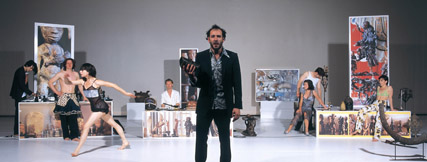
Needcompany, Isabella’s Room
photo Eveline Vanassche
Needcompany, Isabella’s Room
Belgium’s Jan Lauwers sees himself as “a man without a city”, so it’s not surprising that Isabella’s Room appears not as rooted in the biennale’s city theme as other works, and starts out, at least in its storytelling, in a lighthouse, “an inbetween place; somewhere between land and sea”, where Isabella is born. Lauwers and Needcompany’s show is a very lateral take on 20th century history and the very long life of one woman, Isabella. Two cities do aptly figure, Paris where Isabella finds some respite from personal trauma among the cultural objects brought back from colonised Africa, and Hiroshima where a lover witnesses the appalling pain and devastation of the H-bombing.
Isabella’s Room is a marvel of the undoing, hybridising and remaking of theatre. In a press conference Lauwers, who appears in the production in a white suit, playing guitar and joining in the dialogue and the dancing (and what dancing, joyful and mad), confessed surprise at having created a musical. Not a bad thing, he thought, reflecting on the dark Needcompany works of the 90s and sensing a need for an antidote, albeit a critical one, to the current grimness of the world. So, Isabella’s Room is full of singing and dancing along with dialogue played directly and intimately to the audience amidst Lauwers’ collection of anthropological objects inherited from his recently deceased father. (In what curious ways is Lauwers himself Isabella?) The company’s self-choreographing dancers (Julien Faure, Ludde Hagberg, Tijen Lawton, Louise Peterhoff) spring into idiosyncratic action either on their own or draw in the whole company, or provide upstage counterpoint to downstage dialogue, offering some of the most distinctive and satisfying dance we witnessed in the biennale.
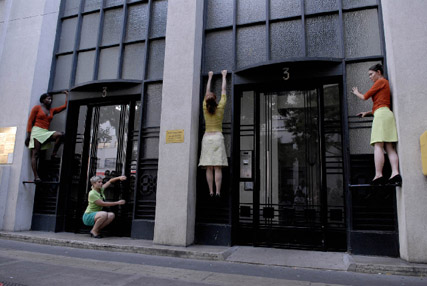
Compagnie desprairies, site-specific performance, Là commence le ciel
photo Michel Cavalca
Compagnie desprairies, site-specific performance, Là commence le ciel
Lyon’s dance biennale was our first visit to a festival dedicated entirely to dance; such an event is a true rarity in Australia. It was an enlightening and enriching experience and it was wonderful that Australia’s Force Majeure could be part of it.
–
Biennale de la Danse 2006 Lyon, France, Sept 9-30
RealTime issue #76 Dec-Jan 2006 pg. 2-3
© Keith Gallasch & Virginia Baxter; for permission to reproduce apply to realtime@realtimearts.net
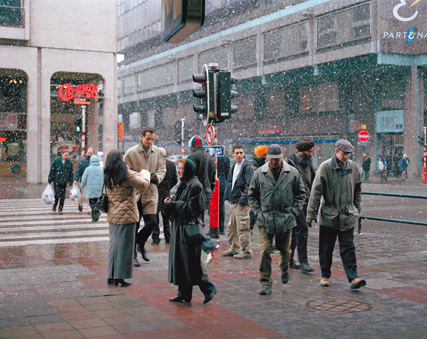
Sébastien Camboulive, Extrait de la limite pluie-neige, 2005
IN 2006 LYON’S BIENNALE DE LA DANSE PARTNERED LYON SEPTEMBRE DE LA PHOTOGRAPHIE, AN EXHIBITION SPREAD THROUGH 32 GALLERIES AND OTHER VENUES ACROSS CITY AND SUBURBS. WE MANAGED TO EXPERIENCE ABOUT A QUARTER OF IT, ENGROSSED WITH PHOTOGRAPHERS EXPLOITING THE PAINTERLY POTENTIALS OF THE DIGITAL, CAPTURING EVERYDAY HUMAN MOVEMENT IN UNEXPECTED, SOMETIMES DANCERLY MOVES IN PUBLIC SPACES AND RECORDING THE GROWING CROSS-CULTURAL COMPLEXITY OF CITY LIFE.
At the Maison de la Danse, Didier Grappe seems to shoot from the waist so that the weight of the image leans toward the legs and feet of his Hamburg street subjects as they set off in different directions, or form lines, advancing on the photographer with a bounce in their step. Sébastien Camboulive’s images capture pedestrians mid-movement, clustered at the centre or the edge of intersections and all moving in different directions. One or two of them have stopped as the others dance on. Camboulive’s large format series offers a strong aesthetic take on the social kinetics of crossing the street. His recurrent choice of the same kinds of moment and space suggests a loose visual choreography, the thin line between artifice and the everyday.
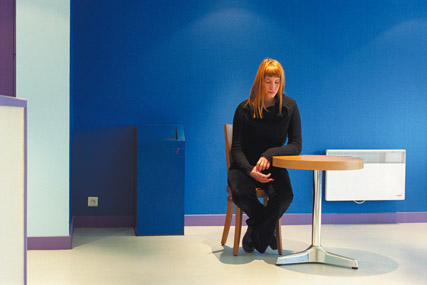
Laure Bertin, Sans titre, 2004-2005
Laure Bertin’s small images recall, without being imitative, the paintings of Edward Hopper. They have the same sense of bodies caught in moments of stillness amidst distinctive colours and in unremarkable contemporary city settings—a girl at a table against a blue wall that perhaps suits her mood; a man framed in a doorway; a girl standing in front of a shop window in which we see the street, a tree, power poles and the girl herself reflected, framed by yellow columns and red walls.
In the same show, Aurélie Haberey offers a mysterious series called Les Secrets in which people disappear or crawl into foliage with hints of evasion or illicit behaviour, but mostly of merging. Pauline Rühl-Saur’s ghost figures are captured moving while seated on highly coloured furniture in public spaces—shades of the works of Australian photo media artists, Darren Siwes and Merilyn Fairskye.
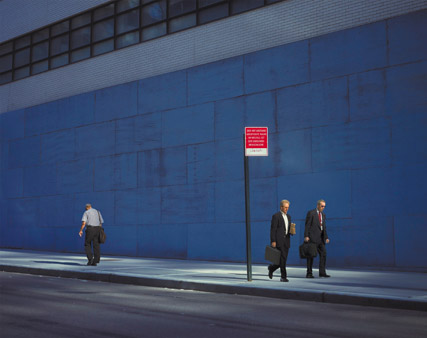
Mona Breede, Distance 1, 2005
Painterly digital realism reaches its apotheosis in the work of Mona Breede, L’Arriere-Plan de L’Existence, at the Lyon Goethe Institut. She too does street scenes but they have an epic, wide screen quality portraying contemporary street life, a multicultural populace, the overpowering presence of advertising and the geometries of public and architectural space.
In Distance 1, two businessmen are caught in mid-step, behind them a man in a shirt, head down moves in the opposite direction. The red street sign between them translates as “The most important distance in the world is the distance between people. Law Department.” People appear etched, like animated still lives moving on a background of solid colour and sharply defined shadow. Can any reality be this sharp? In Distance 2, on the same street, the subjects are Asian. The works have the peculiar power of photography and painting hybridised—and not kin to photorealism.
Breede’s New York series of people walking against a low, less than familiar New York skyline are very narrow, long photographs with an even more painterly intensity. The work runs around 3 walls in long strips. These also have a slightly Hopperish feel, hard edged but soft, with a luminosity that might almost be regarded as nostalgic if its subjects are utterly contemporary. A similar approach is applied to a rich ethnic mix of pedestrians captured in a German street against a graffitied wall and a blue sky, with an even more pronounced flattening of distance.
Efrat Shvily’s black and white photographs at Espace Arts Plastiques de Venissieux are of almost completed Israeli settlements set up on Palestinian land during the first Intifada and awaiting their new inhabitants. They evoke a terrible feeling of artificiality and imposition accentuated by their monochromatic suggestion of other just as problematic times. The new settlements already look like ghost towns.
Centre Sociale Bonnefoi is a community centre in an area of Lyon where descendants of Algerian immigrants live. We met the photographer Ghislaine Hamid whose work was on display, large transparencies attached to the internal windows of the building so that they could be seen or not, as people wished. Image-making in Islamic culture was at issue here. Hamid had decided to document the all male Algerian gathering place in a nearby public space—a large circular road with open meeting space in the middle and shops and offices around the edge. She said she took the photographs so that local women could see what the men got up to in a mix of long shots, portaits and clusters of movement, like the one we’ve reproduced here outside a wedding dress shop.
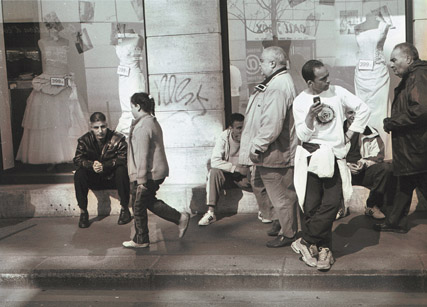
Ghislaine Hamid, Les hommes debout, 2006
The project took Hamid a year. Because she was a woman with a camera she had to gain the trust of the men; she had to understand that this public place was a community space and how it worked—the young men gathering in the centre, others further out. The women told Hamid that they liked the photos for the unthreatening ease revealed in their male friends and relatives, but commented, “We don’t have time to sit around like the men.”
Our final stop is at the magnificent Musée d’Art Contemporain, part of a Renzo Piano creation using his favourite terracotta tile that houses a cinema, shops, restaurants and a conference centre as well as the infinitely flexible gallery—every wall can move.

Sébastien Camboulive, Extrait de la limite pluie-neige, 2005
By way of monumental Robert Morris installations and through a wonderful exhibition by young Japanese artists—Aya Takano, Cho Ao Shima, Aosha—working exquisitely out of manga, anime and the Japanese print tradition, we are guided to the works of too many photographers to absorb before we fly out of Lyon. We witness an incredible range of responses to people in the built environment from vivid scenes of a street bazaar in India to Florian Ebner’s enigmatic studies of young European men caught in casual movement, and David Moziconacci’s Asian workers in New York at work and asleep on factory floors, to Valerie Jouve’s immaculately detailed but nonetheless spontaneous images of people she’s approached in the street. Occasionally we sight surreal images, but there is a larger sense that the everyday is strange enough or, as in Breede and others, that the everyday can be heightened just enough to bring home its otherness. Elsewhere (Geraldine Lay and Christian Buffa) it’s to be found in works that drop background into near black making their subjects luminous, or disappear depth of field.
We relucantly drag ourselves away from a captivating exhibition to enter our own little still lives in the demanding if sometimes dance of airport queuing and airline travel.
Our thanks to artist and curator Nicolas Garait for guiding us through aspects of Lyon Septembre de la Photographie.
Lyon Septembre de la Photographie, la region humaine, des corps dans la ville, Sept 15-Nov 4, www.lebleuduciel.net
RealTime issue #76 Dec-Jan 2006 pg. 6
© Keith Gallasch & Virginia Baxter; for permission to reproduce apply to realtime@realtimearts.net
What is Parcel? A design team? writers? editors? One of Parcel’s attractions for the people who work in and around it is that the positioning statement seems to change every few months.
Parcel was formed in Sydney in 2004 by writer and editor Heidi Dokulil and communications designer Graeme Smith. The idea was to make a satisfying and intelligent living out of what they like doing: designing and writing, talking to people about design and visual culture and setting up interesting scenarios for dialogues between designers and manufacturers, artists, educators, children, the public and any groups interested in a more complete view of the world as a designed place.
A recent project informed by these interests was the exhibition, Conversations of Things New, which Parcel curated and designed for the Italian Trade Commission at Federation Square, Melbourne and St Margarets, Sydney. The exhibition explored collaborations—through interviews, talks, a film, a magazine and design process artefacts—between Australian product designers and Italy’s heritage-rich manufacturers.
www.theparcelgroup.com
RealTime issue #76 Dec-Jan 2006 pg. 6
© RealTime ; for permission to reproduce apply to realtime@realtimearts.net
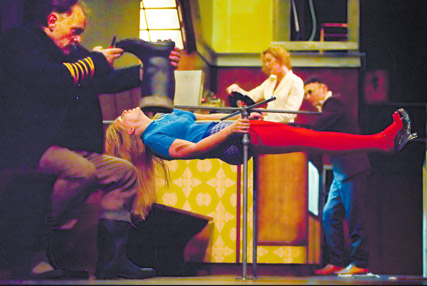
Seemannslieder
photo Phile Deprez
Seemannslieder
CHRISTOPH MARTHALER’S THEATRE SLOWS TIME TO A STANDSTILL. HE STAGES PASSAGES OF WOUND-DOWN TIME, OF EMPTY TIME AND OF MEMORY TIME. HIS DRAMATURG STEPHANIE CARP CALLS HIM A DIRECTOR OF THE ‘MEANTIME’—WHEN SOMETHING HAS CONCLUDED AND SOMETHING NEW HAS NOT YET BEGUN. A TIME BETWEEN. A TIME OF WAITING, OF REMAINDERED THOUGHTS, LEFTOVER PEOPLE AND ONCE FORGOTTEN SONGS. Seemanslieder, created with ZT Hollandia/NT Gent in a Dutch-Belgian co-production, is the first Marthaler production to come to Australia. It’s in the 2007 Sydney Festival program.
Born, in Erlenbach near Zurich, in 1951, Marthaler is a classically trained musician. He began to develop his distinctive theatre language working in Basel between 1980 and 1988 with a series of music theatre compositions and song recitals. These included collages of various folk songs and evenings after Erik Satie, John Cage and Kurt Schwitters. The title of his song project on the Swiss military, Wenn das Alpenhirin sich rötet, tötet, freie Schweizer, tötet… [When the Alpine mind reddens, Kill free Swiss, Kill], mocked the Swiss national anthem and nearly caused the sacking of the theatre’s artistic director.
Since the early 1990s, Marthaler has created theatre works for Berlin’s Volksbühne am Rosa-Luxemburg-Platz, Deutsches Schauspielhaus in Hamburg and Schauspielhaus Zurich where he was artistic director 2000-2004. He has directed many operas including Pelléas et Mélisande, Fidelio, Katja Kabanowa, Pierrot Lunaire and, most recently, Tristan und Isolde at Bayreuth. His award-winning theatre productions are regularly invited to the Berlin Theatertreffen and to festivals worldwide.
All Marthaler’s work must be considered music theatre. As a composer, he develops a score of gesture, speech, music and behaviour. Text and narrative are subordinated to rhythmic compositions, self-repeating segments and enactments of ‘dead’ time. His use of live music is always extremely playful and choral arrangements of songs are present throughout all his works. This is equally true of his versions of plays—including Chekhov’s Drei Schwestern [Three Sisters]; Horvath’s Kasimir und Karoline; Zur Schönen Aussicht [To the Beautiful Prospect]; Dantons Tod [Danton’s Death] by Buchner—as of his found text assemblages—including Die Stunde Null [The Zero Hour] devised from speeches by post-war German politicians; Groundings, concerning the decline of the Swiss airline industry; or Die Fruchtfliege about the life cycle of the fruitfly. It is also true of his song-collage projects—such as Murx den Europäer! Murx ihn! Murx ihn! Murx ihn ab! [Kill the European! Kill him! Kill him! Kill him off!] composed of nostalgic German Volkslied; Die Zehn Geboten [The Ten Commandments] after the songs of Rafaelle Viviani; or his staging of Schubert’s Die Schöne Mullerin. Other composers present in Marthaler’s theatre include Charles Ives, Noël Coward, Lloyd Webber, Monteverdi, Berg, Shostakovich, Stravinsky, Offenbach, Puccini and Verdi, to name a few.
Singing in Marthaler’s theatre occasions acts of collective memory. Mostly sung very quietly, songs grow out of silence bringing individuals from solitude into chorus. They are sung as if half-remembered, very fragile, harmonious and beautiful. Sometimes, they’re like a prayer repeated. Sometimes, a long lost refrain. Every now and then, an aria turns inward. Here and there, a daggy vaudeville turn. They express impossible longings for a lost past and a longed for present.
In Murx! singing constitutes an historical haunting and scouring of national identity. Subtitled Ein patriotischer Abend [A Patriotic Evening], the piece, created in 1992, has been called a requiem for the former East Germany. It takes place in a vast empty hall: some run-down public institution with wood-panelled walls, fluoro lights, an empty elevator moving up and down without passengers, and several huge furnaces which require regular stoking. The clock on the wall has stopped, but a bell repeatedly rings, causing the inhabitants of the room to queue to wash their hands in a washroom upstage. Otherwise, they sit at their respective tables and engage in banal, repetitive rituals, petty spats and obsessive acts. Only when they sing are they united. The Volkslieder sung in Murx! carry repressed memories of Germany’s fascist past and connotations of the still open wound of reunification. Songs of glorified nationalism lose all innocence and even the very act of singing recalls the use of such songs in Third Reich rallies. At one stage, two of the actors play klezmer music, at first very softly, then others take it up, and for a while, it fills the hall. It hangs in the air like a beautiful memory. The furnaces on the side of the stage are stoked. The song seems to escape from within. In the memory time of the song, voice becomes an act of ghosting, a prayer in a room where clock time has stalled.
A few years before, in 1992, with a version of Labiche’s Die Affäre Rue de Lourcine, Marthaler commenced his collaboration with set and costume designer Anna Viebrock. For over 15 years across opera and theatre, they have staged variations of the same banal room peopled by fragile communities of melancholic, washed up figures. Their body of work is a continuing articulation of recurring ideas and states. Uninterested in novelty or reinvention, Marthaler patiently elaborates his alternate temporal order in Viebrock’s empty rooms.
Every set which Viebrock designs is a waiting room of some kind. Like the spaces photographed by Candida Höfer, the rooms which Viebrock places onstage posit an architecture of absence. Belonging to a recent past, often institutional, her rooms contain an air of slowness, of deliberation, of space remembered—an old sound recording studio, a disused factory, a wood panelled ballroom, an emptied library, the stairwell of an apartment block, the stage of a community hall, a foyer. Often, Viebrock’s stages begin as copies or translations of found spaces, old photographs or abandoned buildings. Her rooms, though concrete in detail and autonomous in presence, are often ambiguous. They contain traces of multiple uses, or overlap heterogeneous spaces, as in the room of Die Zehn Geboten which crossbreeds the nave of a cathedral with a dusty old stage. All Viebrock’s rooms bear the marks of their use and the wear of time. Their furnishings are dilapidated. The people too have a sense of being left behind. Their clothes place them in another era, yet they never belong to ‘period pieces.’ According to theatre writer Stephanie Carp, they are “remembered and dreamed people”, necessarily familiar. So, Chekhov’s Prozorov sisters might be recognised “crossing Alexanderplatz holding plastic bags at the close of a workday.”
Marthaler always places a community on stage. His people are alone together. Found in Viebrock’s rooms they are subject to the same laws of entropy. In this sense, as in his stagings of Horvath, all Marthaler’s pieces are folk plays concerned with forgotten people, language collapsing into silence, a persistence of song and a poetry of the everyday. An affinity with Chekhov resounds in shared concepts of organic communities and the cyclic nature of time. Marthaler extends the powerlessness of his onstage figures resulting in a deepened abnegation of climax and suspense in favour of a draining of drama. When the figures in his Three Sisters wish for a glorious future, it is already a memory, a function of lapsed ideology and actions long faded into routine.
This theatre of quiet, slow life enacts a withdrawal of drama from the stage. The figures onstage are withdrawn too. Unable to play heroes, they wait their entire lives for something that never comes. It even seems as if they would rather not be on stage. They stare into corners, face the wall, perform exercises, quietly recite old texts. Every now and then someone trips, or a glass breaks, or a sudden fit disturbs compulsive patterns.
The Marthaler family of actors (including André Jung, Ueli Jäggi, Olivia Grigolli, Matthias Matschke, Judith Engel, Jean-Pierre Cornu, and Graham F Valentine) are all great, gentle clowns. Onstage they are unforced, light, always playful and often very funny. Through little quirks, obsessive routines and their shared songs, they form Marthaler’s island of stranded people. People who are unable to belong in the shiny world of advertising. People whom the rush of capitalism leaves behind. From their silence, Christoph Marthaler extracts frailty, neurosis and longing. He finds the beauty of the powerless.
Speaking at the start of rehearsals for a new work, Winch Only (premiered in Brussels in May 2006), Marthaler said, “We still don’t know what we’re going to do. The prerequisite first of all is to create a real group of actors capable of understanding each other and what everyone’s feeling. And the best way to do that is to sing and eat together! We sing a lot and improvise. We always do that when we’re not dealing with specific work on a play or opera. We have to get to know each other and our voices first.”
Marthaler’s music theatre shares Italo Calvino’s favourite motto, ‘festina lente’, hurry slowly. Against capitalism’s perpetual novelty and urge to speed, he allows theatre to maintain a distinct tempo. He slows the heartbeat and stops life’s flow to observe and reflect. Duration is staged as a musical melody, a multiplicity and a dynamic continuation of past into present time into a future. Marthaler’s humanist theatre is a refusal to speed up or catch up.
ZT Hollandia/NTGent, Seemannslieder, director Christoph Marthaler, designer Anna Viebrock, Sydney Theatre, Jan 10-13,
www.sydneyfestival.org.au
RealTime issue #76 Dec-Jan 2006 pg. 8
© Benedict Andrews; for permission to reproduce apply to realtime@realtimearts.net
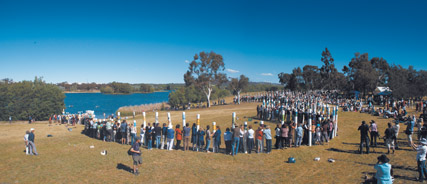
photo: Tim Whiteley
On October 19 2001, a small fishing vessel commonly referred to as SIEV X sank in Australian waters, drowning 353 of the people onboard who were seeking refuge from war-torn countries in the Middle East.
For four years, led by project founder Steve Biddulph, a growing number of people from many streams of belief and activism have been working together to construct a permanent memorial. Landscape architect Dr Sue Anne Ware from RMIT has been collaborating with the group to help develop the idea.
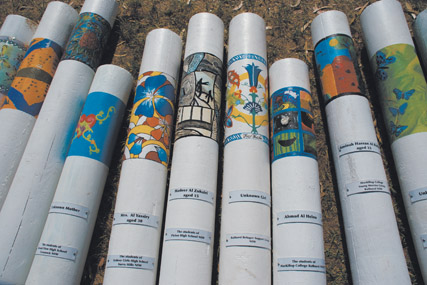
photo Tim Whiteley
Beginning with a national invitation to school students and an initial idea from Queensland schoolboy, Mitchell Donaldson, for 353 bars in the shape of a boat, the project evolved into a collaboration with students, community groups and activists all over Australia who inscribed a series of decorated white wooden poles with the names of the refugees in Arabic and sent them to Canberra.
At 2pm on October 15 in Weston Park on the banks of Lake Burley Griffin, “to our amazement and gratitude, 300 poles arrived,” reports the organisers’ website (www.sievexmemorial.com), “along with 1400 people including Sir William and Lady Deane, ACT Chief Minister, Jon Stanhope, MPs and leaders of various churches, ambassadors… The line of poles was awesome to see laid out on the ground. It stretched for over 300 metres.
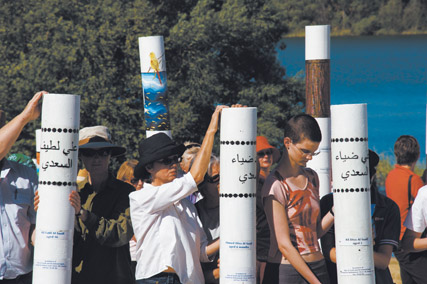
photo: Tim Whiteley
“Eventually it took 600 volunteers to stand up during the ceremony. We still don’t know where they all came from,” says project co-ordinator Beth Gibbings. “A drumbeat accompanied the procession down the hill. Then the poles were raised, amid tears and joy in the audience, the students and three men whose families who had died on the boat five years ago. The Kippax Uniting Church Tongan Choir sang a gospel song. Then the poles were gently laid on the grass.”
The idea was for the memorial to remain for three weeks but a late intervention by the National Capital Authority meant that the event was restricted to a single action on the day—a powerful action nevertheless, that stands strongly, as the organisers assert, as “a national symbol of conscience and caring, that every human life is precious, and a message of human unity that we won’t be divided by fear.” RT
RealTime issue #76 Dec-Jan 2006 pg. 9
© RealTime ; for permission to reproduce apply to realtime@realtimearts.net
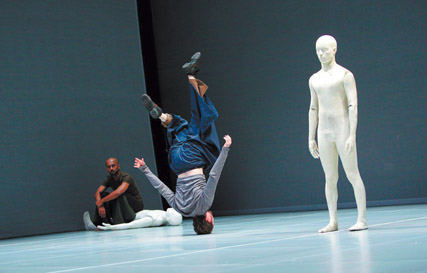
Akram Khan & Sidi Larbi Cherkaoui, Zero Degrees
photo Tristam Kenton
Akram Khan & Sidi Larbi Cherkaoui, Zero Degrees
IN A STRONGER THAN USUAL SYDNEY FESTIVAL PROGRAM, DANCE PLAYS A PIVOTAL ROLE, NOT ONLY FEATURING LEADING AUSTRALIAN AND VISITING COMPANIES BUT ALSO OPENING SYDNEY’S NEW REDFERN-BASED CONTEMPORARY PERFORMING ARTS SPACE, THE CARRIAGEWORKS, WITH AKRAM KHAN & SIDI LARBI CHERKAOUI (UK-BELGIUM), AUSTRALIAN DANCE THEATRE AND BATSHEVA DANCE COMPANY (ISRAEL).
At the Sydney Opera House there’s Lucy Guerin Inc, Meryl Tankard & Taikoz, and The Holy Body Tattoo (Canada). The theatre program is more modest but boasts the wonderful Maly Drama Theatre of St Petersburg in Uncle Vanya along with Gate Theatre (Ireland) with a trio of Beckett adaptations for the stage, Company B’s new take on Snugglepot and Cuddlepie and South Korea’s Yahangza’s A Midsummer Night’s Dream.
But it’s the hybrid works that have some of the festival’s strongest appeal, above all in the Christoph Marthaler Seemannslieder in collaboration with the Dutch-Belgian companies ZT Hollandia and NTGENT, merging musical performance and theatre in unexpected ways. Likewise there’s Lou Reed’s Berlin, a live performance of his 1973 cult album realised here with Reed and band as staged by visual artist Julian Schnabel; dancer-choreographers Akram Kahn and Sidfi Larbi Cherkaoui collaborate with sculptor Anthony Gormley; ADT’s Garry Stewart with Montreal roboticist Louis-Philippe Demers; Lucy Guerin with dancers media artist Michaela French and designers Bluebottle; and, not least, Geelong’s Back to Back Theatre join a host of collaborators to work a public site into an intimate theatrical/media space. Here’s my ticket wish list, in welcoming artists whose work I’ve seen and admired, but also with quite a bit of guesswork and reliance on reputations—the risk-taking that comes with arts festivals. By the way, let me add this wish, for a greater commitment from the festival to Sydney artists who appear in such small numbers relative to their counterparts in festivals in other Australian cities.
Christoph Marthaler/ZT Hollandia/NTGent: Seemanslieder
The great European director (p8) evokes the pull of the ocean on body (sober, dreaming & drunken) and voice in sailor songs, pop and lieder.
Maly Drama Theatre of St Petersburg: Uncle Vanya
Superbly theatrical and wonderfully lateral in the 1996 Adelaide Festival, this company’s Vanya will doubtless yield great emotion and unexpected insight.
Akram Khan & Sidi Larbi Cherkaoui: Zero Degrees
In the premiere CarriageWorks’ performance, superb dancer-choreographers British-Bangladeshi Akram Khan and Flemish-Moroccan Sidi Larbi Cherkaoui (Les Ballets C de la B) dance to a meeting point, the zero degree, with music by Nitin Sawhney and design by sculptor Anthony Gormley.
Australian Dance Theatre: Devolution
Choreographer Garry Stewart, robotocist Philippe Demers, filmmaker Gina Czarnecki and the powerful ADT dancers create a frightening world in which humans and machines uneasily coexist. Interview with Garry Stewart: RT 71, p2; review: RT72, p32.
Lucy Guerin Inc, Structure and Sadness
Choreographer Lucy Guerin’s reverie on the 1970 collapse of the West Gate Bridge as felt in analogous tensions of the body. Review: p31; Interview: RT75, p4
Back to Back Theatre: Small Metal Objects
Outside Customs House Square by Circular Quay at peak hour, the audience watch a very real passing crowd amidst which a disturbing drama unfolds. A hit at last year’s Melbourne International Arts Festival. Review: RT70, p4; interview RT69, p6
Meryl Tankard and TaikOz: Kaidan, A Ghost Story
Choreographer Meryl Tankard in a collaboration with Sydney taiko drum ensemble TaikOz and visual artist Régis Lansac create their version of a classic Japanese ghost story.
Batsheva Dance Company
Three works: the intimate Mamootot with nine dancers and audience on four sides at the CarriageWorks; Kamuyot for groups of young people over 6 without experience of dance; and the epic Telophaza for over 40 performers and screens, choreography by Ohad Naharin, staged in the Capitol Theatre.
The Holy Body Tattoo: Our Brief Eternity
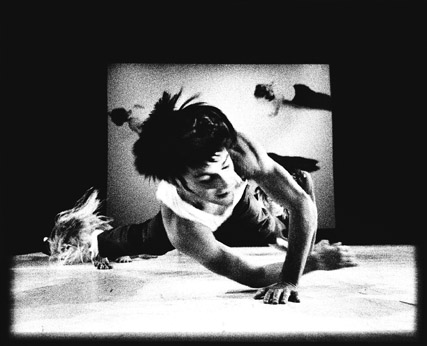
The Holy Body Tattoo, Our Brief Eternity
photo Rolline Laporte
The Holy Body Tattoo, Our Brief Eternity
The Holy Body Tattoo “explores the nature of human endurance through ideas of surrender, fragility and broken elegance” From Canada, three dancers, an electro-industrial score, images by William Morrison and texts by William Gibson and Chris Halcrow tackle the forces of progress. www.holybodytattoo.org
Gate Theatre: Beckett Season
Michael Gambon in Eh Joe, directed by Atom Egoyan, is a staged version of the TV original; Barry McGovern in I’ll Go On, a dramatised selection from the Beckett novels; and Ralph Fiennes in First Love, from the novella.
CIRCA: The Space Between
A rare Sydney outing for Brisbane’s globe-trotting physical theatre, CIRCA, with a work about the desperate need for togetherness and its attendant tensions.
Company B: The Adventures of Snugglepot and Cuddlepie and Little Ragged Blossom
With John Clarke at the writing helm expect both a faithful realisation but also a satirical re-write of a white Australian children’s classic.
MCA: Centre Pompidou: Video art 1965-2005
Curated by the Pompidou’s curator of New Media, Christine Van Assche, this large scale exhibition includes over 25 renowned video artists from across the globe including Isaac Julien, Nam June Paik, Garry Hill, Jean-Luc Godard, Samuel Beckett, Bill Viola, Valie Export, Pierre Huyghe and Tony Oursler.
Lou Reed’s Berlin
A grim paean to life on the edge, the cult 1973 LP Berlin is now performed live for the first time, featuring Reed himself, a fine band and Antony of Antony and The Johnsons, with musical direction by Bob Ezrin, who produced the original album and Hal Willner, creator of the 2005 Sydney Festival Leonard Cohen tribute, Came So Far for Beauty. The concert will be directed and designed by New York painter and filmmaker Julian Schnabel (Basquiat, Before Night Falls).
The Famous Spiegeltent
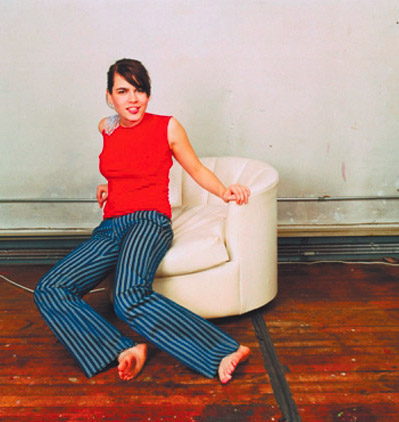
Kaki King
The ubiquitous tent features an unusually adventurous musical program with Australia’s The Necks, Clogs (a classy electro-acoustic US-Australian combo), New York virtuoso guitarist Kaki King (echoes of the late great John Fahey), another fine guitarist and singer-songwriter M Ward (US), eclectic harpist-singer-songwriter Joanna Newsom (US) of the weird child voice, and Brazil’s Bossa Nova Hot Club.
Roseanne Cash: Black Cadillac
US progressive country great Cash sings from her latest CD, Black Cadillac, about parents Johnny Cash and June Carter, in a concert with song, spoken word and film.
The World Famous: Crackers?
Audiences over the age of 12 stand for an hour surrounded and awed by the fireworks of pyrotechnicians The World Famous at Sydney’s Olympic Park. Also features The Human Sparkler.
Sky Orchestra
In a work about listening while asleep, at sunrise hot air balloons will fly over western Sydney broadcasting the creations of sound artists Luke Jerram and composer Dan Jones.
Have a go…
Arts festivals always involve risk-taking and some of the following look intriguing: Akhe Russian Engineering Theatre’s multimedia performance, White Cabin; the hip hop theatre of Will Power’s Flow (US); Compagnie Au Cul Du Loup (France) at play with found sounds in a show titled Mousson; and even the Domain series. Jazz in the Domain’s Noite Brasil is the two and a half hour creation of composer-guitarist and bossa nova boss Oscar Castro-Neves with a percussion section led by no less than Airto Moreira; and Symphony in the Domain features not only Barber, Bernstein and Copland but also works by Frank Zappa and John Zorn. KG
www.sydneyfestival.org.au
RealTime issue #76 Dec-Jan 2006 pg. 10
© Keith Gallasch; for permission to reproduce apply to realtime@realtimearts.net
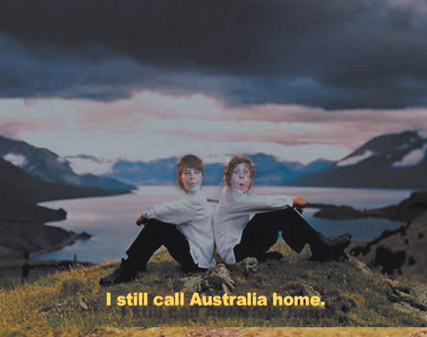
spat+loogie, National Treasures, installation for Karaoke Bedlam, MAAP
IF YOU HAVEN’T HEARD, THE HOTTEST ACCESSORY FOR THE YOUNG AND EMERGING ARTS EVENT IN 2006 IS SPAT+LOOGIE’S NEW!SHOP.
After an initial Performance Space residency in 2005, new!shop premiered at Next Wave (RT73, p2), toured to Canberra Contemporary Art Space (RT73, p48) and inevitably landed in Newcastle for Electrofringe.
new!shop, we are told, is our retail future. Installed in an actual shopfront, the spat+loogie team stock shelves with bemusing objects marked only with barcodes, which when scanned reveal their life affirming purpose (eg Bright Future Sun Glasses, Fear Mask, DIY Botox Kit) through stills, text and video snippets. The shop has efficient, friendly staff who offer you samples, direct you to specials and occasionally lock all the doors and undertake security checks of the not-so innocent looking shoppers. Although no money is exchanged and no items actually acquired (some lucky shoppers in Newcastle did get badges), new!shop is a satisfying experience for the art shopper with its no-fuss integration of performance, installation, technology and social commentary.
I caught up with the new!shop creators spat+loogie (Kat Barron and Lara Thoms) as they ran between rehearsals for the three projects they are currently working on. They only had time for one beer.
Gail: When your were little, what did you want to be when you grew up?
Kat: I think I wanted to be an illustrator or a doctor.
Gail: And what stopped you going down that path?
Kat: I think what stopped me was that on the night I finished the HSC I went to have dinner with Lara’s family and her grandmother got out a future predicting pendulum and told me that I needed to be an artist.
Lara: That’s true! I tossed and turned and never really knew…In high school I was really pissed off a lot of the time and a bit of a socialist and never wanted to work for the system. My dad is a filmmaker so I got quite interested in image making and artmaking. I think at some point I thought I wanted to do acting, but didn’t really have any dreams of a particular career.
Gail: You seem to have known each other a while.
Lara: Yeah but we weren’t really friends at high school (laughs)…We went away after school and became really close friends. We moved in together and started making art in a little studio in a tiny terrace in Surry Hills.
Kat: A balcony!
Gail: What’s your training?
Lara: We’ve both got Media Arts Production Degrees in Communications from the University of Technology (UTS). Aside from that I’ve done imPACT ensemble (PACT Youth Theatre’s training workshop) and lots of little bits and pieces. We did a little short course at VCA a couple of years ago.
Gail: How did your collaboration come about?
Kat: We used to just make a lot of little collages and paintings together…passed things between each other.
Lara: We also travelled together and did a travel zine. We’ve got this pretty amazing trust in each other. We can leave something half finished and be happy for the other to finish it without even checking up on it…We do have slightly different skills but we have the exact same aesthetic, so we never really have problems with bickering.
Kat: Lara is more interested in performance…I guess I do more new media stuff. But we do both as well.
Lara: It’s quite equal but Kat is actually a lot better at getting things done and I’m a lot better at talking about things. So I can sit down with performers or anyone and go on for a while, while Kat’s behind the computer. She’s a can do-er. She’s more technically proficient than I am…
Gail: It’s been a good year for spat+loogie.
Lara: I think the past 12-15 months have been such a steep learning curve—trying to work out the art world and festival lands. So many people have put work into new!shop that it’s been really worthwhile being able to give it a bit of a life.
Gail: How did you get new!shop off the ground?
Kat: We got a Kickstart grant from Next Wave which was a year long development.
Lara: We were really inspired from seeing the previous Next Wave festival. There were so many multiform works and things in non-traditional spaces, young people doing really experimental stuff. After the festival we sat in a café and said we have to do something like that right now!
Gail: And what’s next?
Kat: Gathering Ground [a large scale site-specific project by PACT Youth Theatre and Redfern Community Centre taking audiences on a performance tour of the Block in Redfern, for which spat+loogie are the designers. Ed.]; The Whistling Man [PACT Youth Theatre’s imPACT ensemble performance for which they are creating media design and video]…
Lara: And then we’re going to MAAP [Multimedia Arts Asia Pacific Festival] to do a karaoke installation for Karaoke Bedlam [RT75, p32]. Then next year we’re doing a site-specific vending machine in Bankstown through Terminus Projects and the Western Front. [We will] create objects that represent the Bankstown community that they can take home, after visiting a website and receiving a token through the mail. That’s accompanied by a very slow process of stocking the machine in the beginning. So it’s called Unstance—it’s not an instant vending machine, it’s about process.
Gail: What do you have to do to make a living?
Kat: We’re both careworkers at The House With No Steps for adults with mental illness. And we also do graphic design work… I think next year I’m going to get a job working at the AV department at UTS!
Lara: I guess the fact that we don’t spend a lot of money on anything is a bonus. I mean I live in a squat; we avoid consuming heaps of new things all the time.
Gail: Thus the impetus for new!shop. Do you have any grand plans for the future?
Lara: I guess in the short term, we feel that new!shop’s been really successful and we believe in it because it attracts unexpected audiences. We really like the idea of non-art crowds interacting with the work and it would be nice if that could have more of a life and go overseas. That is something that we’ll try to do in the near future…and in the long term… I can’t even think about it!
Gail: It’s an insane question I know. I just thought I’d try it out.
Lara: It would be great to have a practice that’s really sustainable… a few days a week, paid [to work] on your own projects but I don’t think the world works like that at the moment. I think even if there was some really great job that secured us in one place for a long amount of time we’d get really fidgety and want to put our feelers out and do lots of different things.
Gail: The ultimate restless, hybrid artists?
Lara: Restless, yes…
http://www.spatnloogie.com
RealTime issue #76 Dec-Jan 2006 pg. 12
© Gail Priest; for permission to reproduce apply to realtime@realtimearts.net
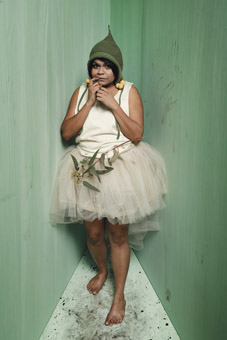
Ursula Yovich, Snugglepot & Cuddlepie
photo Alex Craig
Ursula Yovich, Snugglepot & Cuddlepie
IT’S MID-MORNING AND THE NEWLY IF NOT QUITE COMPLETELY RE-FURBISHED BELVOIR STREET THEATRE IS BUZZING WITH WORKMEN AND THEIR DRILLS, THE FLOOR IS GRITTY, THERE’S LOTS OF COMING AND GOING. AND THERE’S A SIGNIFICANT IMMINENT DEPARTURE.
After more than a decade, General Manager Rachel Healey is leaving Belvoir St Theatre and Company B for the Sydney Opera House where she’ll take up the position of Director, Performing Arts vacated by Sue Hunt, now CEO of the CarriageWorks.
Healey describes her time at Belvoir St as “a fantastic partnership for over a decade”, one of “great intimacy and personal commitment.” Above all she is describing her working relationship with artistic director Neil Armfield. She anticipates that her new job will be of a very different kind: even though, when we meet, she’s moving to the Opera House the following week. She quips, “It’s not like I’m getting divorced and then getting married the next day!”
As in any good relationship, Healey says, she and Armfield developed shorthand communication, shared a similar intuitiveness and were in constant exchange: “You have to have this and you have to believe in it.” Healey was on the Company B artistic sub-committee and was involved in casting, commissioning and the operations of the B-Sharp program in the downstairs theatre. Despite the scale of her involvement in the life of the company, Healey says “I had no desire to be called executive producer. I was the general manager and I was responsible for keeping the company in the black, building reserves, not letting the company collapse.” Her aim always was to firm up the foundations of a “left of centre and challenging” company and make it flexible—not least if its artistic director ever chose to move on.
When Healey arrived at Belvoir St, the company’s reserves were a mere $100,000, now they’re around $1.4m (although, she remarks, a sizeable chunk has had to go on Seymour Centre theatre rental during the rebuilding). The reserves not only offer security, says Healey, they also “look after the artists of the future.” When Colombia’s renowned Bogota Festival wanted Benedict Andrews’ 2003 production of Brecht’s The Threepenny Opera, Healey knew the company had the reserves to help the trip happen. Other tours included taking The Small Poppies to Dublin and Cloudstreet to New York and beyond.
Healey says her departure from Belvoir St feels sudden: there’s still work to be done on the $11.5m building. As we talk, I’m conscious of her eagle eye on the foyer activity around us. She describes her former office as an incredibly crowded and uncomfortable “cocoon” behind the box office and with a view of the customers coming into the foyer—“perfect for keeping touch with everything that was going on—I heard some fantastic things!” Management, she feels, has to be integral to the life of the company. She was adamant that the new offices be kept in the theatre building, but when the company was refused the right to add two storeys to the building, an alternative site had to be found for offices and rehearsal space. Luckily a warehouse building almost immediately across the street from the theatre became available, “one floor for offices, and another, an ex-judo studio with a lovely old pressed metal ceiling, for a brilliant rehearsal space.”
Sudden or not, Healey feels that her departure comes after reaching “major milestones”: radically improving conditions for performers and patrons in the rebuilding of the theatre, developing international touring and building financial reserves.
Given the key roles played by Healey until now and Armfield (with three shows to direct in 2007) it’s promising to see that with the support of Arts NSW Wesley Enoch will be the company’s inaugural Associate Director for the next three years. Enoch will direct Alana Valentine’s Paramatta Girls and Howard Brenton’s Paul. Healey says that Enoch, who directed his own Black Medea for Company B, will “develop a relationship with the company that goes beyond show-to-show.” As well as being on the artistic sub-committee, he will be involved with the education program, with B-Sharp and work with the literary manager, all of which Healey sums up as “a dialogue with the company.”
company b 2007
Neil Armfield sums up the 2007 Company B program in his introduction to the subscription brochure as looking “at faith and obsession and religion, childhood and fantasy, theatrical song and dance, [and] a couple of the most extraordinary classics of 20th century theatre…” And he proposes these as necessary antidotes to Australian money culture, reduced civil freedoms, anti-sedition legislation, the engineered weakening of public education and the new government-given power of media monopolies. In a co-production with Adelaide-based Windmill Performing Arts of Snugglepot and Cuddlepie and Little Ragged Blossom, writer John Clarke and director Armfield will doubtless meld homage to the May Gibb’s children’s classic with satirical infidelity: “The stinky old Banksia Men want the bush for themselves, gumnuts are being thrown overboard”, says the subscription blurb, and cheekily suggests, “Adults, why not see it twice? Once with the kids, once with your local MP.” Music is by Alan John and design by Stephen Curtis. Elsewhere in the program the life-art nexus undergoes even more scrutiny, whether in Ionseco’s Exit the King (in partnership with Melbourne’s Malthouse) with Geoffrey Rush as king of the clowns (a stellar lineup of Bille Brown, Julie Forsyth, Gillian Jones), or in Michael Gow’s Toy Symphony where writer’s block (Richard Roxbrough as the writer) unleashes reflections on the origins of creativity. All three plays are to be directed by Armfield.
Belief is most directly explored in Howard Brenton’s Paul, directed by Wesley Enoch with Ewen Leslie in the title role. It’s a provocative account of the life of a saint that drew street protests from Christian fundamentalists in London. Brenton’s work is rarely seen here, but in the company of David Hare, David Edgar and Howard Barker, he has been one of the great forces in British theatre since the 1970s. Stephen Sewell, in many ways a kindred spirit of these writers, tests the beliefs of a middle-aged woman (Lynette Curran) who ventures into the Middle-East, against the wishes of her family, in The Gates of Egypt, to be directed by Kate Gaul.
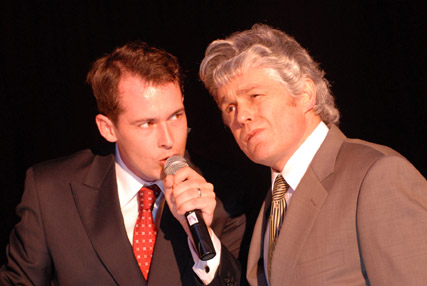
Mike McLeish, Terry Serio, Keating!
photo Heidrun Löhr
Mike McLeish, Terry Serio, Keating!
Sydney past and present provides material for the 2007 season. Wesley Enoch directs Alana Valentine’s Paramatta Girls with a cast that includes Leah Purcell and newcomer Roxanne MacDonald, from Queensland, who Rachel Healey tells me is an impressive performer. Valentine’s cultural archaeology of recent but forgotten history focuses on eight inmates of the Girls Training School (1908-80) using documented recollections in a reunion setting. The success of Casey Bennetto’s Keating! has landed him another Company B opportunity, Real Estate. Keating! is reviewed on page 47 and is touring Canberra, Wollongong and WA for the Perth International Arts Festival.
Last but not least, theres’ a fascinating choice in Benedict Andrews as director for Edward Albee’s Who’s Afraid of Virginia Woolf? with Catherine McClements as Martha. As always with Andrews we can expect a distinctive and revealing approach to the play. (There’s no mention who is to play George. The most recent George of Broadway and the West End has been the wonderful American clown Bill Irwin, working with Kathleen Turner.) Albee’s acerbic account of a ruthless playing with truth is domestically self-contained but resonates nonetheless with the wider world of political spin and historical distortion, of secrets true and false. In an age hostile to nuance and the demands of compassion the play delivers, above all, painful complexities.
Company B’s 2007 program admirably sets out to dissolve distances—between us and our local history, the Middle East, the political and religious roots of our culture, and our creativity and capacity for compassion.
Company B, Belvoir St Theatre, <a
www.belvoir.com.au
RealTime issue #76 Dec-Jan 2006 pg. 14
© Keith Gallasch; for permission to reproduce apply to realtime@realtimearts.net
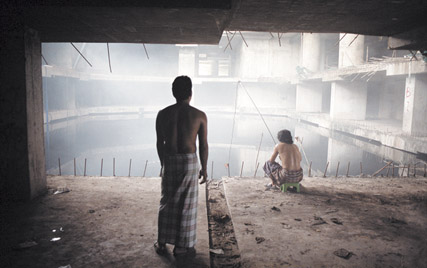
Don't Want to Sleep Alone
EACH YEAR THE PUSAN AND TOKYO FILM FESTIVALS PRESENT THE OPPORTUNITY TO SIZE UP NEW DIRECTIONS IN ASIAN CINEMA. IT WAS SIGNIFICANT THIS YEAR THAT BOTH FESTIVALS DEVOTED SO MUCH SCREEN TIME TO MALAYSIA WHICH IS STARTING TO LOOK LIKE THE NEW REGIONAL CINEMA OF NOTE—FOR LOCAL FILMMAKERS AND AS LOCATION OF CHOICE FOR CHINESE FILMMAKERS.
Malaysia had a studio-based entertainment cinema in the 1950s and 60s which withered as Hong Kong, Bollywood and Hollywood took its place. Its problem—and perhaps now its opportunity—came from the way that Malaysia comprises a range of races and ethnicities: Malay, Chinese, Indian and the lingering influence of colonialist Britain. With the reduction in costs associated with digital technologies, the ability to work around the government’s Malay-based ‘bumiputera’ (sons of the soil) policy, and the decline in Hong Kong production, Malaysia is starting to look like a good bet as a cheaper centre for films which can appeal to a mix of people across Asia.
Local Malaysian filmmaking over the past few years has been deeply collaborative with James Lee (My Beautiful Washing Machine) and Amir Muhammad (The Big Durian) heading a group who work in different roles on each other’s films in order to maximise the amount of material they can get made cheaply. This approach is now starting to bear fruit. Not only did Lee and Muhammad have new films this year, but there was a range of work by their collaborators.
Tan Chui-mui’s Love Conquers All, which was produced by Muhammad and shot by Lee, came away from Pusan as the major prizewinner. A young woman moves to Kuala Lumpur and falls in love with a man who pursues her relentlessly. He warns of the exploitation and degradation that lies down this path, but to no avail. The title is both ambiguous and ironic in the sense of a Fassbinder melodrama. Love conquers not adversity, but those who love.
The stylistic influence of filmmakers such as Jia Zhangke (see p22) and Hou Hsiao-hsien is central, as it is to so much Asian cinema at the moment. Tan works hard against melodrama in setting forth the harshness of her observations. Moments of stillness are more telling than actions. Silence is preferred over dialogue or the emotional manipulations of music. The cruelty of the world should first be faced in a clear-eyed way, and only then should emotional engagements come forward.
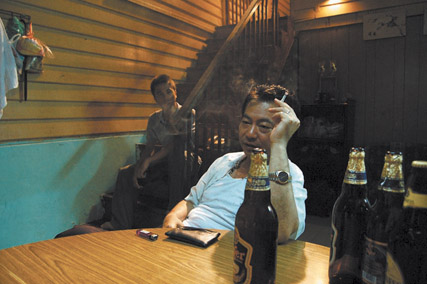
Rain Dogs
Another spare, de-dramatised film is Rain Dogs, directed by another Lee-Muhammad collaborator, Ho Yuhang. This is the story of a young man who doesn’t have the viciousness in him to make a success of the transition from the kampong to urban life. “Don’t think so much while you eat”, his mother tells him, and the line makes sense in the context of the film. Ho has worked out how to employ the minimalist style in a remarkably controlled fashion. There is some small element of camera movement in just about every shot. Often it is a slow track in or back, enough to suggest a contemplative storytelling presence without being ostentatious. Scenes are generally done in single takes, and crucially dramatic moments are either elided, played out in long shot or with characters turned away from the camera. In every way, this is a reversal of the Australian cinema’s prioritisation of dialogue-driven scenes which set the stage for actorly performance. The triumph of Jia Zhangke’s Still Life at Venice this year means that we can expect to see a big increase in this severely restrained and distanced form of storytelling.
If its rise as a production centre in the 1960s contributed to the decline of Malaysian production, Hong Kong’s cyclical decline has had a direct effect on the revival of Malaysian production. Rain Dogs is part of the First Cuts series of low budget digital films funded—and more significantly, distributed—by Hong Kong star Andy Lau’s company Focus Films.
Focus is also distributing the new film by Yasmin Ahmad, another of Lee-Muhammad’s collaborative group who acts in Rain Dogs. Her own films were the subject of a retrospective in Tokyo. Ahmad’s four features are all autobiographical, linked by the character Orkid. Her most recent film, Mukhsin deals with the tomboy, Orkid and the boy who develops a crush on her during school vacation. Ahmad (who works in advertising) is a little more mainstream than many of her colleagues and she prominently rejects the art cinema convention of silent, interiorised characters. She sees families bound together by playfulness. Her parents’ love is measured by their ability to joke, sing and play with each other as they age. Seriousness of demeanour is one of the unfortunate consequences of the fall into adulthood with its fraught sexual entanglements.
Ahmad also stresses that her characters are Muslims, and that this is in no way incompatible with a deep human warmth and cosmopolitan tolerance. In Mukhsin it is the family’s more strictly moralistic neighbour who has the tables turned on her when her husband decides to take a second wife. Ahmad sees no contradiction between her faith and the embrace of Western culture. Mozart accompanies kite-flying just as Nina Simone’s version of “Ne Me Quitte Pas” is used playfully on the soundtrack as Orkid races for a final glimpse of a first love that she never recognised as such.
The way that Hong Kong is becoming important less as a place than as a point of productive relationships is also brought out by Patrick Tam’s return to directing, After This Our Exile. Tam was one of the leading figures of the Hong Kong New Wave in the 1980s, and was the mentor of Wong Kar-wai, whose 2046 he edited. Tam has taught for years in Malaysia and hence shot his comeback film there. HK heartthrob Aaron Kwok stars as a violent loser who drives away his wife (Charlie Young from Seven Swords) and then leads his son into petty crime.
The English title (in Chinese, it is simply called Father and Son) encourages a more abstract reading, and while there are a few moments of stylistic flourish and the film is shot by Hou Hsiao-hsien’s cinematographer Lee Ping-bin, there isn’t much to sustain this approach. Maybe the son is paradoxically the villain? In his childish innocence he refuses to countenance any kind of long-term solution to his dysfunctional family situation.
Perhaps the most important thing is that the use of stars such as Kwok and Young signifies an increasing willingness on the part of Chinese cinema to draw Malaysia more prominently into its range. Tam’s film, taken together with Taiwan’s Tsai Ming-liang’s decision to return to the country of his birth to shoot I Don’t Want to Sleep Alone in Kuala Lumpur indicates that something interesting is happening in another of our near-northern neighbours.
So finally, why Malaysia and what might we in Australia learn from this? Australian filmmakers have shown a desire to work cheaply on digital video over the past couple of years, but the key thing that is missing is the ability to tap into international styles that will generate interest in regional festivals and markets. Australia’s adherence to theatrical models of filmmaking looks increasingly conservative in the context of what is going on in Asia now. Not only does Australia need to absorb international styles, our filmmakers and institutions need to expend more energy on international marketing and co-production, finding ways into the distribution pipelines that are emerging within the region.
Pusan International Film Festival, Pusan, South Korea, Oct 12-20; Tokyo International Film Festival, Tokyo, Japan, October 21-29
RealTime issue #76 Dec-Jan 2006 pg. 15
© Mike Leggett; for permission to reproduce apply to realtime@realtimearts.net
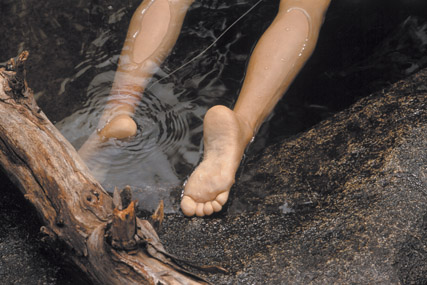
Jindabyne
photo Anthony Browell
Jindabyne
I look at the creek. I’m right in it, eyes open, face down, staring at the moss on the bottom, dead.
Raymond Carver, “So Much Water So Close To Home”
WHEN CLAIRE, THE NARRATOR OF RAYMOND CARVER’S QUIETLY POWERFUL SHORT STORY, IMAGINES HERSELF TO BE THE DEAD WOMAN THAT HER HUSBAND HAS FOUND IN A RIVER, IT’S A MOMENT OF CONDEMNATION AND EMPATHY.
In Carver’s “So Much Water So Close To Home”, and in the recent film adaptation, Jindabyne (by Australian director Ray Lawrence) Claire’s husband chooses to continue fishing with his mates, despite having discovered the murdered woman floating downstream.
It’s this choice—to keep fishing—that provides the central ethical conundrum and terrific moral ambiguity in both story and film. But in Jindabyne the murdered girl is not just some young woman from out of town, she’s also Aboriginal. Lawrence, and screenwriter Beatrix Christian’s decision to include issues of race in this considerably extrapolated version of Carver’s story shifts the focus considerably. Several reviews have admired Jindabyne’s engagement with the theme of reconciliation, but few have examined precisely how this actually functions in the film.
Christian explores the fallout from the choice by the four men to “fish over a dead girl’s body” as the Jindabyne newspapers put it. For most of the film we closely follow the emotional and ethical struggles of our protagonists. Claire (Laura Linney) cannot come to terms with what her husband Stuart (Gabriel Byrne) has done. Much of this material—Claire’s secret, unwanted pregnancy; her past postnatal depression; Stuart’s midlife crisis (he dyes his greying hair, leers at young women, sympathises with some nearby blokes who call his wife “bitch”)—seems hackneyed (male sexual power and mateship versus female sensitivity). Yet, as many reviews have noted, Jindabyne skilfully avoids histrionics by sharply cauterising painful conversations at crucial points. But when the film broaches the huge and complicated matter of reconciliation, it falters, drawing a precarious bow from the collusion of the men (who lie to cover their negligence) to comment on Australia’s failure to confront and make amends for the suffering of its Indigenous people.
In Jindabyne we learn little about the murdered woman, Susan, or her family: the scenes dealing with their “sorry business” and their pain remain sketches. As the tensions build, the film seems at first to resist trite conclusions. Jude (Deborah Lee Furness) seethes with angry grief over her daughter’s death, withdrawing her love for the surviving grandchild (whose misbehaviour presumably stems from her own sorrow). Yet paradoxically, Jude is the least troubled by the fishing incident, despite (or because of) her husband’s involvement. “Move on”, she exhorts Claire; “let it heal over”, though her own brittle anger reveals she hasn’t managed this herself. This complexity is welcome, and true, for grief isn’t something we “get over.” Claire, the moral centre of this film, copes with her disquiet by frantically trying to make amends for her husband’s negligence. But the authenticity of her attempts at reparation are muddied by her own deception.
However this promise of complexity, confronting moral ambiguity and lack of closure is undermined by a hollow resolution. Once all the signposts about the conclusion begin to appear, the film loses its power. Having so far resisted neat homilies on personal conflict, the film invites the audience to contemplate the various human responses to an act that resists easy moral judgement. But this central conundrum is never fully realised, and when Claire and her friends gatecrash Susan’s memorial, all this good work goes to waste.
Psychoanalyst Julia Kristeva has contemplated the appropriate aesthetic response to events that overturn and tax our moral universe. She identifies, in some artistic responses to the Second World War and the Holocaust, “an aesthetics of awkwardness” and a “noncathartic representation” (Black Sun: Depression and Melancholia). Without comparing Aboriginal deaths and displacement with these events, it does seem that certain traumatic histories resist redemptive closure, and do not conform to Western (and Christian) notions of catharsis as resolution. Jindabyne suffers from trying to iron out all its awkwardness, from introducing a catharsis that doesn’t emerge organically from the central concerns of the film. What Jindabyne suggests in its penultimate scene—an Aboriginal funeral ritual—is that white people’s engagement with Indigenous culture might be a form of reconciliation. But let’s examine what really happens in this episode.
Undoubtedly, Aboriginal “sorry business”, like any community’s grieving, is an intensely private affair. But American Claire is undaunted, or ignorant of this. Impelled to make amends for her husband’s act, she arrives at the bushland memorial of the murdered girl and stands on its periphery. If Claire can just bear witness, it seems she might somehow right some of the wrong. The four men who went fishing have become town pariahs, accused of “white hate crimes”—graffiti that calls up a complex history of race relations barely touched on in the film. Three of these men have sudden, inexplicable changes of heart and also appear at the ceremony. (Given their previous reluctance to admit their wrongdoing we expect to be shown how they reached this decision, but we’re not.) Now all our central characters have invited themselves into what is presumably sacred space. Stuart is slapped and spat on by an insulted elder, but eventually stands by his wife and whispers, “I want you to come home Claire.” Her longing look suggests much is forgiven, but why? What has happened, apart from this Aboriginal ritual at which Claire and her friends are merely spectators? While the smoking ceremony proceeds, Jude arrives with her granddaughter. (Again we’re not shown why or how this came about.) They have their first moment of harmony, banishing their own “bad spirits”, saying, “be gone”.
There is something badly wrong with this scene: both as a resolution to Jindabyne’s many strands of considerable conflict and, as several reviewers see it, as a metaphor for reconciliation. As the white onlookers observe the ceremony, we sense their longing for a meaningful communal ritual of their own. Unable to gain solace from their previous attempts (a barbecue that descends into a fight, an Irish Catholic rite), these suffering characters hijack the Aboriginal ritual, which conveniently functions as the required ‘profound’ event to propel their catharses. At no point are we invited to understand the particular significance and meaning of this ritual for its black participants because we’re given little insight into the texture of their lives, or the particularity of their suffering. A syrupy English song, sung by the murdered girl’s relative is intentionally moving, but seems included for a (white) audience to better interpret the emotion of this scene. As viewers we are always positioned with the film’s central characters—as outsiders looking at a generalised scene of Aboriginality.
Because she was Aboriginal, Susan’s death has far greater symbolic meaning than the unknown victim does in Carver’s story. Her memorial offers us no genuine insight into how the film’s central characters have mysteriously resolved their considerable conflict. Consequently it seems a superficial display of Indigenous mysticism for the purpose of driving a formulaic white catharsis. If reconciliation is about adopting “colourful”, “mystical” or “deep” Aboriginal practices to provide meaning, profundity and healing for a spiritually bankrupt white culture then we have a long way to go. Unlike Carver’s narrator, who imagines herself in the murdered woman’s place, dead in the water, the characters in Jindabyne remain tourists on the edge of Aboriginal culture, too focused on their own concerns to get “right in it. Eyes open”, to wade in deep. In the most telling two lines, the film sums up its lost opportunities. Claire offers the grieving family money for the funeral, assuring them, “It’s not charity.” And they respond, “You buying something then?”
Jindabyne, director Ray Lawrence, screenplay Beatrix Christian, April Films; DVD launch date to be annnounced
RealTime issue #76 Dec-Jan 2006 pg. 16
© Mireille Juchau; for permission to reproduce apply to realtime@realtimearts.net
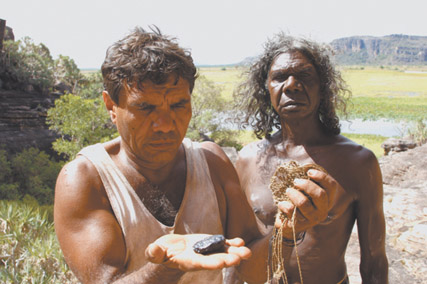
Tom E Lewis, David Gulpilil, Crocodile Dreaming
APPROACHING ITS THIRD INSTALMENT IN FEBRUARY 2007, THE BIENNIAL ADELAIDE FILM FESTIVAL HAS ALREADY ESTABLISHED ITSELF AS A SIGNIFICANT SCREEN CULTURAL EVENT, BUT ALSO ONE THAT APPROACHES AN IMPORTANT PERIOD OF CONSOLIDATION.
Festival Director Katrina Sedgwick is tightening and refocusing her program: “We felt that we were too big [in the second festival], we perhaps grew too quickly.” The program has been trimmed from 13 days to 11 and will ultimately have about 90 titles to screen, the vast majority of them now to play twice to foster greater flexibility for cinema-goers’ schedules. While AFF will perform its core function of bringing art cinema to a quality starved audience, ultimately the distinguishing features of the festival remain its collaboration with its sister events and its slate of projects in which it is an equity investor. These, along with the summer setting, differentiate AFF on the national festival landscape.
Amongst the announced program highlights include the experimental silent feature Passio from Paolo Cherchi Usai (the Director of the National Film and Sound Archive of Australia), which combines a plethora of confronting imagery from the twentieth century with a live accompaniment from the internationally acclaimed vocal ensemble Paul Hiller and the Theatre of Voices. Also on the AFF agenda are all the commissioned films from Peter Sellars’ New Crowned Hope Festival (Vienna), which includes works from Bahman Ghobadi and Mahmet-Saleh Haroun, Garin Nugroho’s Opera Jawa and Tsai Ming Liang’s I Don’t Want to Sleep Alone (p22). These works have been financed with the stipulation that they each use a theme from Mozart’s final operas as a springboard, and have already been attracting the attention of festivals such as Vancouver and Pusan. The AFF recognises that Sellars’ commissioning of films (starting in 2002 with his involvement with the Adelaide Festival of Arts contributing to, among others, Rolf de Heer’s The Tracker) has served as an inspiration for its own investment fund (Look Both Ways, Ten Canoes).
While the investment fund has been AFF’s most idiosyncratic attribute, a recent announcement of a similar equity pool at the Melbourne International Film Festival suggests that the fund is considered a success on a national level. AFF contributes to the budget of features and shorts, generally as a co-investor in a traditional Australian financing model. However, the 2007 program will premiere a feature with the festival as the sole investor: Kriv Stenders’ Boxing Day. A follow up to his film Blacktown (2005) with the same spartan production methodology, gritty social realism, and modest budget ($100,000), the film unfolds in real time over a single afternoon as a father battles to reunite his estranged family. Part of the project’s evolution occurred at the last AFF as Sedgwick revealed: “Kriv and I chatted after the screening of [Kriv’s] Illustrated Family Doctor in 2005. At that point I didn’t know about Blacktown, but was intrigued by his ideas. I asked him if he had anything else on his slate.” Stenders took the opportunity to pitch his collaboration with actor-writer Richard Green. Admitting that she is “particularly interested in the creative opportunities that digital technology provides”, Sedgwick was attracted to the idea of taking the risk on a low budget digital feature. After it picked up a South Australian producer in Kristian Moliere, the AFF board decided to back the project despite having no marketplace attachments in place and without a full script, the project being heavily improvised in rehearsals from an existing outline. For the Boxing Day team, the advantage of an investor with primarily culturally driven concerns and an interest in securing its own premieres shone through in a scenario when other funding avenues weighted towards commercial outcomes were closed. Hopefully Boxing Day’s festival exposure will lead to wider distribution.
The AFF is also a minority investor in Rolf de Heer’s latest venture, the silent, black and white slapstick socio-political satire Dr Plonk, and has not limited its slate to features, through including the short dramas Crocodile Dreaming (director Darlene Johnson), Spike Up (Anthony Maras), Swing (Chris Houghton) and the joint Australian-Chinese animation Sweet and Sour (Adelaide’s The People’s Republic of Animation and Shanghai Animation Film Studio).
The big news from the AFF is the announcement of a $25,000 prize funded by Natuzzi, the Italian furniture designer and manufacturer (also a Venice Film Festival sponsor) for best international feature. This jury-awarded prize will raise the profile of the festival considerably and doubtless increase the number of international filmmakers seeking to screen in future festivals.
AFF ties in neatly with several other screen cultural events. Commencing at the beginning of AFF and running for four days, the twentieth anniversary of the Australian International Documentary Conference (AIDC) provides a forum for 600 delegates and guests to discuss factual film and television as well as participate in a busy dedicated marketplace. Also on the schedule is Crossover Australia, (co-presented by the AFF and the South Australian Film Corporation and kicking off before the festival and AIDC), a residential think tank for experienced content producers to brainstorm crossplatform and interactive projects under the guidance of mentors such as British TV producers Marc Goodchild and Robert Thirkell.
The AFF cleverly carved its own niche in its first two editions and now looks set to consolidate with idiosyncratic programming, creative investment, a substantial prize and its continued collaboration with other significant screen events.
Adelaide Film Festival 2007, www.adelaidefilmfestival.org
RealTime issue #76 Dec-Jan 2006 pg. 17
© Sandy Cameron; for permission to reproduce apply to realtime@realtimearts.net
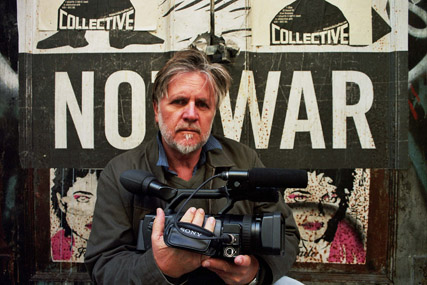
George Gittoes
AFTER A 20 YEAR BREAK FROM DOCUMENTARY FILMMAKING, THE VISUAL ARTIST GEORGE GITTOES RETURNED TO THE FORM IN 2004 WHEN HE RELEASED THE SELF-FUNDED SOUNDTRACK TO WAR—A FILM IN WHICH WE ALL LEARNT THAT TANKS AREN’T JUST KILLING MACHINES, THEY’RE DEADLY STEREO SYSTEMS. NOW, IN RAMPAGE, HE’S VENTURED INTO A TOUGH MIAMI ‘HOOD IN A HIP HOP DOCUMENTARY WITH APPEARANCES BY SWIZZ BEATZ, FAT JOE AND DJ KALEB.
Gittoes returned to documentary because of the digital camera. The price of shooting dropped dramatically and the amount of equipment to be carried diminished. Gittoes says, “Now I can shoot a film and it can be in a cinema, but it is not unlike doing a painting or a drawing. I can do it pretty well by myself.” Gittoes is a real life example of the technological revolution many anticipated in the mid 90s. He’s also a fervent promoter of the notion of the ‘superdoc’—“a doc that has pushed up the values so it can work for people going out to the cinema—like a feature film does.” Gittoes described the job of a superdoc director as the same as the job of a feature film director: “you have to get the best performances out of people. You haven’t got actors so you’ve got to create situations where people transcend and actually lose their inhibitedness and they’re caught up in a moment. They are absolutely real, they’re not doing some pre-thought out speech.”
Gittoes gave an example of this from Rampage: “I went and interviewed Joe Byrne in his office. Most documentary filmmakers would be happy with that because he is an expert in terrorism as well as having been a cop in Brown Sub [a Miama ghetto, home of the film’s main subjects, Elliot and Marcus.] As someone making a superdoc I knew that that was boring. Basically you can’t be boring.
“So, Byrne had not been back to Brown Sub for years. I was aware that he wouldn’t know how dangerous it was. So I organised for him to meet me there, he had an inkling of it because he brought his gun. And Elliot didn’t want to go back there because his brother had been killed there. The gang was threatening to kill Elliot and me and all of us. So we get this very very tense dramatic scene where the people who killed Marcus are actually circling us. And in the back of my mind the clock’s ticking and I’m thinking how many more minutes have I got to shoot before we get shot. That is superdoc making.
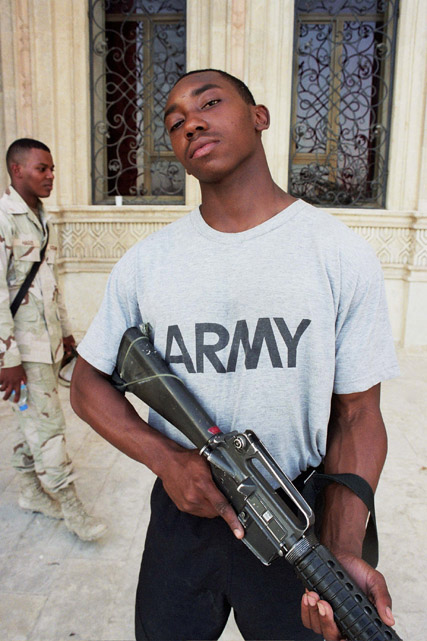
Rampage
“Because of that tension, Elliot doesn’t talk to the camera as a talking head, he is angry with me and he talks right through the camera. He virtually abuses me, he says, ‘How would you feel coming back to the place where your brother was killed? What if someone close to you was killed?’ Joe Byrne, the tough old cop who has seen a lot of homicides, says, ‘Yeah we’d better get out of here.’
“That’s the difference between your ABC commissioning editor-type documentary, where the talking head expert does their boring thing across a desk, and a film that’s actually got the values of drama.”
Gittoes thinks that television commissioning has a detrimental effect on the art of documentary filmmaking: “I’m a ‘fine artist.’ Soundtrack to War [2004] is being shown in the Museum of Modern Art, in ACMI here in Melbourne as art. It is art. Documentary up until the superdoc was applied art and it will always remain applied art if insecure documentary makers have to go and get presales and work through the guardians of the gate, the, what’s his name, Stuart Menzies and Dasha Rosses and Jennifer Crones—these people who play Medici with public money, who want to take control. Documentary film is a collaborative thing but ultimately it has to be a single vision, like a work of art—like a Kubrick or Scorsese film. And yet it is being turned into an applied art.”
Gittoes had investment from the FFC for post production on Rampage and spoke about the effect that this had on him and the film: “One of the suggestions of the FFC was that we cut out South Beach, and lose the Australian section of the film. And I disagreed with that and I had sleepless nights over what they were going to do to me. Without [Australia’s] South Beach I don’t think that there is any comparison [with the poverty of Brown Sub]. Ultimately it’s all on the director and the buck stops with the director even though these bureaucrats want to control documentaries. They can just refuse to give us money next time if the film bombs at the box office.”
When Gittoes talked about other films he considered to be superdocs he mentioned Bowling for Columbine: “One of the big elements was the fact that Michael Moore acts as a bridge between being the viewer and the subject of the film. Now with Rampage, frankly, there might be politically correct people who would say that if it was a pure documentary that I should not be in it. I don’t know where they get that from. They’d be happy for Attenborough to be walking around with the elephants. Those people would probably find that there are dozens of rap films that they’d never watch, which I have watched, which are inaccessible because they don’t have a character like me. There’s a tremendous precedent for Rampage which is Nick Broomfield’s film Biggie and Tupac, where Nick’s getting around with his little bum bag and his microphone and he’s from another culture, like I am. Of all the films I’ve seen on Tupac, that’s the one that works the best.”
In the end though, Gittoes says, “Really, the only rule with a superdoc is that it has to work. And you only know if it works if some cinema chain is prepared to put it on against dramas. Rampage is getting more exposure in more cinemas than any drama recently made in Australia. It’s getting more cinemas than a film like Candy which has got all the big actors and producers.”
Rampage, director-producer George Gittoes; playing in Australian and London cinemas and in festivals in Copenhagen, Stockholm and New York. www.rampagethemovie.com. Distribution: Madman, www.madman.com.au
RealTime issue #76 Dec-Jan 2006 pg. 18
© Catherine Gough-Brady; for permission to reproduce apply to realtime@realtimearts.net
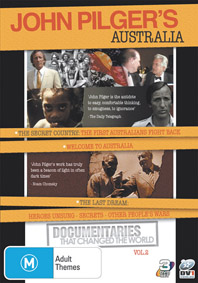 JOHN PILGER IS A PARTICULARLY DISSONANT FIGURE IN PRESENT DAY AUSTRALIA. THE DVD RELEASE OF HIS DOCUMENTARIES ABOUT THIS COUNTRY CREATES AN OPPORTUNITY TO LOOK AFRESH AT THIS CONTROVERSIAL EXPAT JOURNALIST AND FILMMAKER.
JOHN PILGER IS A PARTICULARLY DISSONANT FIGURE IN PRESENT DAY AUSTRALIA. THE DVD RELEASE OF HIS DOCUMENTARIES ABOUT THIS COUNTRY CREATES AN OPPORTUNITY TO LOOK AFRESH AT THIS CONTROVERSIAL EXPAT JOURNALIST AND FILMMAKER.
Based in London, though returning to Sydney regularly, Pilger provokes criticism not only from the right but also some on the liberal left for his work’s morally loaded political rhetoric and selective use of factual information. This has gradually resulted in his disappearance from the Australian media, a situation in stark contrast to the prominence of his work in the UK.
This discrepancy, Pilger argued in a 2004 lecture at the University of Western Australia, is revealing. “Of all the western democracies,” he argued, “Australia is the most derivative and the most silent. Those who hold up a mirror are not welcome in the media. My work is syndicated and read widely around the world, but not in Australia, where I come from.” When he is mentioned here, it is via conservative columnists’ attacks on his UK Guardian or New Statesman articles. It might, then, come as a surprise that this locally marginalised figure is probably our most internationally celebrated journalist, winning at least 20 major international awards including two BAFTAs, an Emmy and the UN Media Peace Price (twice). Yet here he is mainly treated as a dangerous extremist. (After a rare local interview on Lateline two years ago, Gerard Henderson in the Sydney Morning Herald lambasted the ABC for even allowing Pilger a public hearing; the critique Pilger was making of the US presence in Iraq now seems rather less radical.)
The particularly effective conservative belittling of his work in Australia notwithstanding, philosophically at least Pilger is in fact a ‘conservative.’ He is the quintessential old-school crusading journalist, confidently claiming to report the ‘truth’ denied by the mainstream political discourse of the day—however, one committed to working within what is now perjoratively called the ‘tabloid’ press. This determination to work at the very heart of the accessible, non-elitist (and commercial) media is, I believe, a key reason for his being misunderstood by skeptical consumers of the ‘quality’ broadsheet press: “I believe in popular journalism”, he has said. Likewise, most of his films have emerged through involvement with ITV in the UK, a commercial broadcaster which has supported Pilger since his first film in 1970. Interestingly, he says the sustained attacks on his work really got going with the films, perhaps in response to their garnering consistently large TV audiences in Britain.
The 3-DVD selection of Pilger’s films about Australia is not without its problems: there is a lot of repeated material, phrases and footage throughout, and his delivery can sound pompous. Yet the films contain details, interviews, archival images and provocative analyses that make up a sustained critique of Australia’s historical and political heritage in a sometimes incendiary counter-narrative of nation. Made just prior to the Sydney Olympics, the film Welcome to Australia tells a very different tale from the nationalist PR blitz that happily co-opted Indigenous dance, art and Cathy Freeman while effectively hiding the real conditions of Aboriginal Australia.
Yet while decrying successive governments’ denial and recalcitrance in this area, Pilger also offers a hopeful note of progress when it comes to activism and community-generated moves towards change and reconciliation. However, like Michael Riley’s early photography (p20), this cautious hopefulness today comes across as elegiac indeed. Five years into the ‘War on Terror’, at no point in my 36-years have the issues relating to reconciliation and Aboriginal human rights been less substantively discussed. The Iraq War, asylum seekers, terrorism for conservatives and progressives alike, these are the zeitgeist issues of debate. Pilger ends by arguing that no genuine, meaningful Australian nationhood can be claimed until that of the ‘original Australians’ is fully recognised and accounted for.
One of the most powerful ideas argued in the films is that Australia has, with momentary exceptions (notably that of late 1940s and early 70s Labor Governments), never really been a sovereign nation. Other People’s Wars addresses the way in which we happily send our young off to fight for (British, then US) empire; and while the World Wars are recalled all over the country by ‘Lest We Forget’ plaques, we continue to deny the war at the dawn of our own history—let alone tending to reparations. (How many residents or tourists enjoying Sculpture by the Sea know Bondi Beach was used for Indigenous weapons manufacture for many years in the fight against the British invaders, as Pilger recounts?) He argues that the largely unknown Aboriginal battles for land (after the initial offer to share it with the whites was rejected) surely exemplifies qualities supposed to characterise Australian values—typically used to describe white ‘Diggers’—of the underdog, fighting against all odds, freedom from tyrannical rule and invasion. Yet, Pilger soberly points out, not one plaque is to be found heralding such bravery and heroism.
Of course his work isn’t beyond criticism. The tone of the films at times seems patronising; the apparently straight claims of offering the truth do sometimes rankle. And formally, his filmmaking—virtually unchanged throughout the years—is stilted and conservative. Yet too often engagement with Pilger’s work stops at these distracting elements. Filmmaking and methodological artistry aside, these films boldly articulate the shameful big picture elements of Australian nationhood, giving no quarter to the government line under cover of ambiguity or ‘balance.’ The cumulative impact is both rare and startling in its provocation.
Pilger’s work has always been controversial, perennially ‘untimely’ in a Nietzschean sense. Yet renewed global condemnation of US foreign policy in the wake of Bush’s adventurism, and the first-world’s historical and ongoing behaviour towards non-Western nations more generally, should make his analysis increasingly difficult to marginalise. Nevertheless, in present-day Australia the (new) political correctness seeping through our media institutions over ten years has meant Pilger’s work is commonly seen as morally repugnant. That his tone is sometimes sanctimonious in its own moral and historical surety (all the more startling today in being so at odds with the equal ‘certainty’ of right-wing polemicists) shouldn’t distract us from the real power of these films. They act as untimely meditations upon our problematic nation—the sting of which has never been more needed.
Documentaries That Changed The World: John Pilger's Australia, 3 DVDs, 240mins, distributed by DV1, www.dv1.com.au
RealTime issue #76 Dec-Jan 2006 pg. 19
© Hamish Ford; for permission to reproduce apply to realtime@realtimearts.net
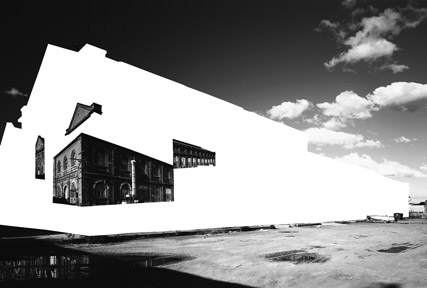 The CarriageWorks, built in the 1880s in Sydney’s Redfern and now with radically redesigned interiors, is Performance Space’s magnificent new home. This new contemporary performing arts centre has two wonderful performing spaces (800 and 300 seats), one of them huge, with flexible seating and rigging and accoustically excellent, roomy high-ceilinged rehearsal studios, offices and a vast naturally lit balconied foyer ideal too for performance. In our hard hats with architect Tim Greer of Tonkin Zulaikha Greer, journalists and NSW Arts Minister Bob Debus, we heard the centre’s Director/CEO Sue Hunt describe Performance Space as “an anchor tenant”, “a key partner” and as “providing a backbone” for The CarriageWorks. Asked about the new home, Performance Space Director Fiona Winning is “very excited about the move, by the new environment for some of the things we’ve always done and the opportunity it offers us to do things we’ve never been able to do. Collaborating with artists, audiences and some new partners in the local area, we’ll be opening in March with a program that places radical experiment alongside meditative community events and politically charged physical performance next to place-based installation. We’re up for the challenge of the change and can’t wait to get in there.” Resident with Performance Space at The Carriage Works will be physical and outdoor theatre companies Stalker and Erth. The first outside hirer will be the Sydney Festival opening the centre in January 2007 with the Australian Dance Theatre, Akram Khan & Sidi Larbi Cherkaoui and Israel’s Bathsheva Dance Company, a fitting prelude to this long-awaited adventure.
The CarriageWorks, built in the 1880s in Sydney’s Redfern and now with radically redesigned interiors, is Performance Space’s magnificent new home. This new contemporary performing arts centre has two wonderful performing spaces (800 and 300 seats), one of them huge, with flexible seating and rigging and accoustically excellent, roomy high-ceilinged rehearsal studios, offices and a vast naturally lit balconied foyer ideal too for performance. In our hard hats with architect Tim Greer of Tonkin Zulaikha Greer, journalists and NSW Arts Minister Bob Debus, we heard the centre’s Director/CEO Sue Hunt describe Performance Space as “an anchor tenant”, “a key partner” and as “providing a backbone” for The CarriageWorks. Asked about the new home, Performance Space Director Fiona Winning is “very excited about the move, by the new environment for some of the things we’ve always done and the opportunity it offers us to do things we’ve never been able to do. Collaborating with artists, audiences and some new partners in the local area, we’ll be opening in March with a program that places radical experiment alongside meditative community events and politically charged physical performance next to place-based installation. We’re up for the challenge of the change and can’t wait to get in there.” Resident with Performance Space at The Carriage Works will be physical and outdoor theatre companies Stalker and Erth. The first outside hirer will be the Sydney Festival opening the centre in January 2007 with the Australian Dance Theatre, Akram Khan & Sidi Larbi Cherkaoui and Israel’s Bathsheva Dance Company, a fitting prelude to this long-awaited adventure.
RealTime issue #76 Dec-Jan 2006 pg. 1
© RealTime ; for permission to reproduce apply to realtime@realtimearts.net
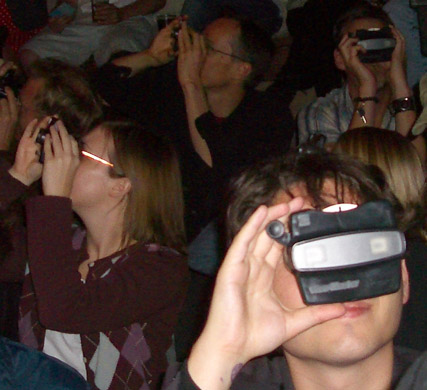
Vladimir's Vladmasters at MadCat
MADCAT WOMEN’S INTERNATIONAL FILM FESTIVAL CONSCIOUSLY SETS OUT WITH SAVVY AND INNOVATIVE CURATORIAL PROWESS TO “EXPAND THE TRADITIONALLY ANAESTHETIsED NOTIONS OF WOMEN’S ISSUES AND ATTEMPT TO BURST THROUGH THE CONFINES THAT CAN ENCASE GENRES.”
The curatorial premise then is simple enough—seek out and showcase all the varieties of innovative and challenging film work from around the world that are directed, produced or otherwise created by women.
Transplanted New Yorker Ariella Ben-Dov is the driving force behind the festival. This is the 10th year of MadCat, and founder Ben-Dov never imagined it would evolve into such a major event, with over 1300 submissions, 12 separate programs running over three weeks, and five venues in the San Francisco Bay area.She recognises that audience endurance is a factor and pleads with the crowd to absorb ‘as much as your ass can take.’ The cheering response suggests that she needn’t worry too much.
The creative atmosphere and energy of San Francisco’s experimental film scene is fundamental to MadCat’s durability and positive reception. Long recognised as a global hotspot for avant-garde film (and in American terms, the counterpoint to NYC’s equally vibrant experimental film culture) San Francisco is home to myriad symbiotic film collectives that share audiences, filmmakers, curators, resources and spaces. Some notable examples include established events like Craig Baldwin and Noel Lawrence’s outsider-friendly Other Cinema series, the excellently curated San Francisco Cinematheque, and the incredibly well resourced film programs put together by Pacific Film Archive. And bubbling ebulliently alongside these are underground artist run collectives including New Nothing Cinema, Oddball Cinema and Studio27, which utilise unconventional spaces and draw heavily on expanded cinema and intermedia traditions. Women filmmakers and curators are strongly represented in all of these groups, and MadCat is in the privileged position of being able to draw creatively from this constantly evolving milieu of female film artists toiling away in darkrooms and studios throughout the city.
kerry laitala
MadCat’s strong fascination with the medium specificity of film also sets it apart from other women oriented festivals. Indeed, much of the most striking work displays a technical wizardry (or witchery) with hand-manipulated celluloid, optical printing processes and photo-chemical and mechanical treatments. Local film artist Kerry Laitala is a prime example, her work arising from a chaotic, almost alchemical process involving single-frame Bolex constructions which are layered, painted, scaled and radically re-worked through the use of an optical printer. Laitala’s recent films Terra Firma, Orbit and Transfixed were shown across various festival programs. Terra Firma (2005) incorporates an original decaying nitrate print of a 1905 San Francisco film, Trip Down Market Street (shot four days before the 1906 earthquake and fire), and reconceptualises it through direct filmmaking techniques such as hand contact printing and visual explorations of the technologies that punctuate both the history of the city and, more obscurely, the history of film. Orbit (2006) is another work that hinges on the collision of indeterminate technical processes (“mis-registered images made when a lab accidentally split the film from 16mm to Regular 8”) with beautifully captured source material (the pulsating and flickering lights of a spinning ‘gravitron’ funfair ride). Transfixed (2005), augmented by a typically lush David Shea soundtrack, enigmatically blurs between hazy liquid abstractions and a paganistic children’s costume parade, contriving a strangely frightening experience full of handmade effects and trick imagery.
zoe beloff
New York film artist Zoe Beloff is a special guest of MadCat 2006, gracing the festival with two programs of her beguiling and obsessional work. Beloff challenges cinematic and pre-cinematic history in a highly idiosyncratic manner, freely re-imagining the technological evolution of moving image media to create an unusual form of pseudo-documentary that is speculative both technically and conceptually. The child of two psychologists, Beloff deals not only with the beginnings of cinema, but the beginnings of psychoanalysis in her films. The two concerns are of course indelibly linked; the ‘phantom’ quality of projected images often struck early film audiences as deeply supernatural, a kind of materialisation or conjuring of objects both there and not there. Cinematic illusionism has always been a perfect form for the representation of unconscious desire.
Beloff heightens the sense of illusion and hallucination with her implementation of 3D techniques. Her work here draws primarily not from 1950s gimmick cinema but rather pre-cinematic spectacles such as phantasmagorias, modified magic lantern devices used to project frightening images such as skeletons, demons, and ghosts onto walls, smoke or semi-transparent screens. Beloff’s 3D is not the familiar red and green anaglyphic system, but a far more sophisticated technique based on the manipulation of polarised light from stereoscopic black and white images that converge and morph as they hit the silver screen.
In Charming Augustine (2005), Beloff speculates through the use of 3D “on what cinema may have been had it been invented a decade earlier.” A fictionalised depiction of Augustine, the iconic young ‘hysteric’ photographed and written about while captive in France’s Salpêtrière Asylum in the 1880s, the film explores the ‘performative’ aspect of hysterical behaviour—a pathology that is ‘acted’ out—and the way in which Augustine’s ‘symptoms’ captivated her doctors with their theatricality and photogenic qualities. We are invited to view Augustine as both mentally disturbed and as a kind of charismatic ‘star’ of the asylum.
Beloff’s Claire and Don in Slumberland (2002) uses real sound recordings of a 1949 psychoanalytic session of a male and female under hypnosis as the narrative basis for a densely constructed mixed-media collage piece utilising 16mm film projectors and coloured stereo slide projections. The manipulative voice of the invisible narrator-psychiatrist prompts and probes the hypnotised Claire and Don, depicted visually as real floating heads attached to ragged doll bodies, their subconscious roaming in a “free floating fever-dream of the Cold War era.” The dialogue is lucid, confessional and somewhat absurd; bodies and voices swap randomly; distant moans, groans and whimpers add to the sense of dislocation. Beloff also treats festival audiences to a selection of early films on psychiatric practices (some acquired fortuitously on eBay and of significant historical importance) and a classic early Betty Boop cartoon featuring a phantasmal creature called “mysterious mouse.” These films help contextualise Beloff’s work and demonstrate the breadth and imagination of her research.
vladimir’s vladmasters
One of MadCat’s most anticipated events is the performance by Vladimir, the Portland based artist who handcrafts her own unique Viewmaster reels, packaging and marketing them in small editions known as Vladmasters. Unless your childhood was cruelly bereft of stimulation you’ll remember the Viewmaster; images are inserted into circular cardboard frames and viewed as 3D projections by holding the plastic viewer up to the light. In 2004, Vladimir was crowned World Champion of Experimental Film by Portland Experimental Film Festival and although that title may be open to some conjecture, there’s little doubt that her work is beautifully formed and hugely enjoyable. Vlad travels with hundreds of Viewmasters and unique reels, enough for each audience member to experience the event in a kind of collective subjectivity. What unifies the experience is the fantastic use of sound, with narration, music and instructional bleeps and dings (for clicking to the next image or changing the reel) keeping the audience in sync and transforming a potentially isolationist technology into something gloriously communal. Indeed, the sound of the enthused crowd clicking their Viewmaster triggers in unison and panic as the pace rapidly increases functions both as a comic and a structural device emphasising the rhythmic playfulness and fluidity of the form. The images themselves construct charming narratives derived from sources including unexplained real-life phenomena, ancient Greek myths and surrealist dinner parties. Vladimir’s work is emblematic of the broad scope of MadCat, where many of the events challenge the way audiences participate and interpret cinema, something of an eternal pre-occupation for avant-garde film.
Over its first decade, MadCat has developed a reputation that stretches far beyond its locality and its program of over 80 films and performances mark it out as an event of international significance. However, as Ariella Ben-Dov accepts and then shares a massive 10th birthday cake with the festival audience, it’s clear that the long-term durability of the festival has its basis in the vitality, camaraderie and imagination of San Francisco’s flourishing film art community.
10th MadCat Women's International Film Festival, San Francisco September 12-27; www.madcatfilmfestival.org; www.othercinema.com/klaitala; www.zoebeloff.com; www.vladmaster.com
RealTime issue #76 Dec-Jan 2006 pg. 21
© Sally Golding & Joel Stern; for permission to reproduce apply to realtime@realtimearts.net
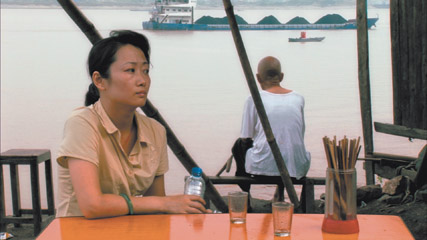
Still Life
THE SPRAWLING MARQUEE THAT IS THE VANCOUVER INTERNATIONAL FILM FESTIVAL (MORE THAN 300 TITLES ARE SPREAD OVER A GENEROUS 15 DAYS) IS SUPPORTED BY THREE MAIN PILLARS: CANADIAN FILMS, DOCUMENTARIES AND EAST ASIAN CINEMA.
These provided two program highlights in this year’s event, one the latest instalment from one of the young masters of contemporary global cinema, and the other a retrospective of one of the medium’s last pure innovators. While China’s Jia Zhangke and Canada’s Norman McLaren could hardly be further apart in aesthetic style, production techniques or thematic preoccupations, both maintain singularly bold visions that successfully resonate widely with discerning international audiences.
east asian cinema
Operating under the banner of Dragons and Tigers, Vancouver’s Asian focus has generated considerable interest for North American critics and local cinephiles. Programmer since its inception in 1992, Tony Rayns’ last ever selection for the festival consisted of the usual heady mix of commercial cinema, underground arthouse projects and cutting edge animation. This eclecticism reflects a healthy film culture that values a diversity of styles across all levels of production. Any program that includes Yiang Liang’s grungy guerilla piece Taking Father Home, Ann Hui’s crowd pleasing, star-studded Post Modern Life of My Aunt, and a stunning anthology of short independent anime from Japan and Korea will be regarded for its breadth rather than for identifying clearly discernable trends. More than just spotlighting the region to Western audiences however, the Dragons and Tigers program can make some claims to launching several notable filmmakers’ careers through its Jury Prize for Young Cinema, which has recognised incipient excellence often well before other festivals and critics. Previous winners include Jia Zhangke (in 1997 for Pickpocket), Wisit Sasanatieng (with the anarchic Tears of the Black Tiger, 2000), Takahashi Izumi (The Soup, One Morning 2004) and Liu Jiayin (Oxhide, 2005, RT67, p22). Jia Zhangke’s latest film, Still Life, appeared in this year’s program (though ineligible for the jury prize), fresh from its much debated winning of the Golden Lion at Venice as the surprise competition entry.
jia zhangke’s still life
Still Life (the actual title in translation is The Good People of the Three Gorges) centres on two parallel stories set in the literally crumbling Fengjie province, primarily in several townships being slowly demolished before flooding by the Three Gorges Dam. A morose, ineffectual middle-aged man is searching for his estranged daughter and ex-wife, while a woman from Shanghai has come looking for her husband, seeking a divorce. The protagonists wander amongst the detritus of the region with an air of quiet desperation, discovering the remnants of a discarded society while they hunt for family members. Villagers cling to their existence, living in houses clearly marked for razing; prostitutes ply their trade in roofless dwellings; and work parties of demolitionists perform life endangering tasks for paltry remuneration. Jia finely balances the mood between mournful and surreal as routine daily exchanges are rendered heroic against the backdrop of the doomed landscape of abandoned towns, meandering rivers and jagged cliff faces.
The opening seconds of Still Life reveal a much grainier High Definition look than Jia’s previous work, there is a more immediate rawness akin to documentary than the cleaner (albeit still digital), sweeping compositions that were the backbone of The World (2004). This is not to say the staging of Still Life is not meticulously crafted; it consists primarily of long takes either tracking over groups of workers or a static frame soaking in the collapsing townships. The length of the shots gives the film a lugubrious pacing that adds, rather than detracts, from its impact as the viewer is invited to explore every facet of the collapsing physical environment and the characters’ internal journeys within it. In an extremely bold manoeuvre, the narratives are framed by two ostentatious magic realist devices (which won’t be revealed here) that further underscore the surprisingly epic nature of the film, rather than jar disconcertingly. As sombre as Still Life can be, it concludes on a cautiously upbeat note, a bravura final shot that becomes a celebration of human capacity for survival, and the film avoids becoming merely an indictment on the bleak social conditions and the emotional malaise of its inhabitants.
Critics of Jia’s work complain that the landscape tends to overshadow his characters, dwarfing them both physically and emotionally, and as a result they seem distant and insignificant in scale; it’s difficult to get too involved in their desires and problems. It is true that again in this film the introspection and underplayed emotions of the characters are in contrast to the louder emotional drum beats on display in more popular cinema, and that their occasional passivity can slow the narrative momentum. However, the time and space given to the performances are refreshing and encourage further reflection and interpretation of action and motivation.
norman mclaren
On watching a wide ranging retrospective of Norman McLaren’s work, it is easy to be impressed with the Scots-Canadian experimental filmmaker’s body of work that combines accessibility with the truly avant-garde. It is a testament to his abilities that McLaren gained a slew of mainstream prizes, in arenas including the Academy Awards and the Cannes, Berlin and Venice Film Festivals when his films rarely contain anything approaching a narrative, and some consist entirely of a swirling, transforming colour palette shifting to a pulsating jazz soundtrack. His films, now well and truly canonised by the Canadians, hold up to scrutiny decades after their production.
McLaren worked primarily through a self-taught form of animation by painting directly on to film stock or manipulating it through scratches and other indentations. But over a lengthy career spanning through the 1940s to the 1970s, his technique became more varied and deviated from his trademark paint and ink (as in Begone Dull Care, 1949), to playful stop motion with ethical underpinnings (Neighbours, 1952 and A Chairy Tale, 1956) to experimental dance pieces (Pas de Deux, 1968). It is his paint and ink work that is perhaps his most striking, and innovative. His mission to “visualise jazz” is remarkably successful, capturing the free form sound through an ever-changing swirl of colour, bubbling textures and anthropomorphic lines: his sketches dance hypnotically. As digital tools are now the stock and trade of the animator, it is with some nostalgia we view McLaren’s engagement with negatives as a literal canvas, but also with amazement at the end result that possesses at least as much visual dynamism as a contemporary music video. McLaren was not afraid to experiment even further with the stock, scratching the soundtrack of the film to provide startling aural effects. He revels in slight imperfections as much as the clear cut successes, the occasional tangible rough edges often adding to a film’s charm.
McLaren’s visual style is infectious, assisted by a playful sensibility that can’t resist turning to humour. His stop motion pieces are marked by a Keatonesque physical comedy, and his jazz pieces are as naturally upbeat as their accompanying scores, the object being to delight rather than to preach through esoteric posturing, a welcome stance from an experimental filmmaker.
Entering the 1970s, McLaren’s musical interests turned to his own electronic compositions, with some synthetic beats that proved his pioneering skills were not limited to the visual. His animations changed proportionately; the rawer, colourful explosion of the jazz period animations were replaced by cleaner, symmetrical, uniform shapes that march rhythmically to the electronic soundscape, encapsulated in Synchromy (1971).
The National Film Board of Canada (NFB) was McLaren’s employer for 40 years, evidently giving him time and space to work on his own projects which he did a prolific rate. The NFB have released a seven-disc box set that comprehensively captures the range of McLaren’s work. His opus is invigorating, an inspiration to continue searching for and celebrating new methods of visual expression.
Whilst lacking the glamour and marketplace components of its eastern cousin in Toronto, the Vancouver Film Festival is focused on bringing quality art cinema to Canadian audiences, and to this end is highly successful. With the continuity of its programming staff and director (Alan Franey has led the festival for almost 20 years) a key factor in its achievements, VIFF acts as a good model for festivals large in scope but wish to keep their focus specialised.
Vancouver International Film Festival, Vancouver, Canada, Sept 28-Oct 13
RealTime issue #76 Dec-Jan 2006 pg. 22
© Sandy Cameron; for permission to reproduce apply to realtime@realtimearts.net

Babylove, Shu Lea Cheang
photo Everett Taasevigen
Babylove, Shu Lea Cheang
IN 1967, A MERRY BAND OF UTOPIAN POP ARCHITECTS KNOWN AS ARCHIGRAM DEVELOPED A REVOLUTIONARY CONCEPT IN URBAN PLANNING: AN ‘INSTANT CITY’ THAT COULD BE DEPLOYED BY BLIMP TO ANY LOCATION.
With great fanfare and hullabaloo, an unheroic suburb or off-season holiday camp would be transformed into a bustling cultural centre overnight. This concept was articulated in a series of drawings showing the changes that would be wrought on a normal English town following the arrival of the Instant City blimp. From a ‘sleeping town’ a bustling urban centre emerges: buildings spring up and the city is transformed. The instant city embodies the great hopes of modernity, the dream of mobility, of people and infrastructure in motion.
Instant City was included in the Edge Conditions exhibition at the San Jose Museum of Art as part of ZeroOne San Jose, an inaugural major festival, partnered with ISEA2006, of new media and “art on the edge” that landed in the capital of Silicon Valley for 7 days in August 2006. Festival director Steve Deitz cited the Archigram drawings as a point of inspiration for parts of the curatorial concept behind the festival. This was evident in the festival’s spirit as much as its theme: Zero One aimed to “transform San Jose into the North American epicenter for the intersection of art and digital culture.” Instead of helicopters and blimps, it did so through a program that encompassed exhibitions in nearly every local museum and gallery, events in every available venue, screenings, gigs, book launches, street performances and public space projects. In addition, it included ISEA2006, a major conference held in a hall worthy of Ridley Scott, where guest speakers were shown live on large video projections, a running commentary was displayed on large screens and the audience sat on rolling office chairs. And, okay, actually there was a blimp: a small artists’ dirigible called the Fête Mobile that perilously patrolled the breezy streets of San Jose throughout the festival, beaming LED displays and wireless networks as it went.
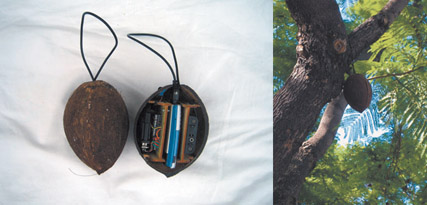
Tripwire, Tad Hirsch
San Jose‘s downtown architecture is notable for being not very tall, but this isn’t because its aspirations aren’t grand. The area is in the flight path to the Norman Y Mineta San Jose International Airport, located just two miles from downtown. As a result, there is a permanent height limit for all buildings. San Jose is a city held in check by its airport: mobility and the city are in conflict. This uneasy relationship with the airport was played out in more than one project at the festival. For the project Tripwire, Tad Hirsch (MIT Media Lab, US) and a team of artistic collaborators installed sensors hidden inside coconuts that were hung in the trees throughout the city. When a low-flying aircraft exceeded a maximum audio level, the system would automatically telephone the airport’s complaint line. The pre-recorded complaints, which can be heard on the project website, appear to reinforce Californian stereotypes. One caller complains that he can’t hear the Steven Hawking book-on-tape on his iPod, and another is totally stoned. Still, Tripwire was an elegant intervention into a very local problem (http://web.media.mit.edu/~tad/htm/tripwire.html).
Another environmental monitoring project took aim at the more general problem of smog, for which the airport can share responsibility with San Jose’s freeway system. PigeonBlog, made by artist Beatriz da Costa (US) and her students Cina Hazegh and Kevin Ponto, employed a flock of carrier pigeons to transport environmental monitoring equipment. Pigeons are filthy animals, and the sheer bloody-mindedness of using them to keep the air clean suggests a kind of poetic justice. But as one conference-goer observed, the pigeons used in the project weren’t dirty at all; they were actually clean and well-mannered, an altogether unfamiliar proposition. Class politics aside, the pigeons of San Jose captured the attention of both local and international media. For once, pigeons had their moment in the spotlight.
Airports were on everyone’s minds at the festival, not just the pigeons’. The Federal Aviation Administration had just announced a ban on any liquids or gels on aircraft, and many conference-goers were subjected to long delays and invasive searches as they made their monsoon-inducing, carbon-belching way to San Jose. Acclair, a project by Luther Thie (Israel) and Eyal Fried (US), tapped into this anxiety with an uncanny sense of timing. The project was a satirical corporation that claimed to offer a service to air travellers: brain fingerprinting, which would collect information from a passenger’s mind before they boarded the aircraft. Some of the information would be used for security clearance, while the rest would be analysed for potential marketing opportunities. The project raised the question of how far a person might surrender their civil liberties to an authority figure, and suggested that the great dream of mobility might come at increasingly high personal costs in the future.
shu lea cheang
Archigram created The Instant City at a time when it was more fashionable to articulate visions of the future before the practicalities had been entirely considered. Many of the projects presented at ZeroOne dealt with the world on a much more logistical level than Archigram was ever able to do: monitoring statistics, intervening into problematic public policy, raising awareness of social and environmental issues. Dealing with the world on this level can be poetic; so much of human experience is encapsulated within small tasks. But in the world of 2006, it takes a remarkable artist to strive to articulate grand visions for the future that aren’t based on criticism and failure, but on potential kinetic energy. Shu Lea Cheang is such an artist. Her installation at San Jose City Hall consisted of a set of teacups, similar to the ride found in many amusement parks, each of which held a large plastic figure of a baby. Visitors to the installation were invited to sit in the teacups along with the baby, steering their way around the foyer space, perhaps colliding gently with other teacups. Each teacup played music that was scrambled and remixed by turning the steering wheel. As with many of Cheang’s works, there was a kind of sci-fi story behind the piece: the babies were clones, the love songs a database of emotional content, and the shared experience of the teacup ride a kind of romantic fantasy. In contrast with prevailing contemporary attitudes and mass media opinion, the piece evoked the possibility of love between human and clone, and elicited the underlying humanity of technology.
not the next new thing
New technologies and visions of the future are so closely linked, they are nearly inextricable. The discussion of the role of new technology in art was a central preoccupation of ZeroOne, as one might expect, and this conversation was articulated through a variety of curatorial stances throughout the festival. The exhibition Edge Conditions, hosted by the San Jose Museum of Art billed itself as being emphatically NOT about ‘the next new thing.’ The introductory text for the show suggested an ambivalent relationship with the field of new media art: “whether it is devices such as pencils and chisels, or ubiquitous aspects of modern life such as electricity, phones, computers and the Internet, technology is simply a set of tools that are more or less familiar at any given time.”
The exhibition offered no shortage of ideas about art in technological times, but these ideas were expressed through a wide variety of media. Ingo Günther’s Worldprocessor may be one of the best examples of this. Between 1988 and 2005, Günther (US) created 300 collage pieces using globes as his source material. Some of the globes are visualisations of data sets, such as television ownership and economic strength relative to land area. Others are more conceptual, such as an image of the earth with every land mass whited out, leaving only the ocean. Like many of the other artists in the Zero One programme, Günther investigates ideas of mobility and the environment, and uses data as raw material, but he does so while still working with physical objects.
Another geography-based project in the exhibition used light as its raw material. Light from Tomorrow by Thomson and Craighead (US) achieved a poetic simplicity despite being awfully complicated to produce. Two weeks before the exhibition opening, the artists travelled to the Kingdom of Tonga, located in a time zone a day ahead of San Jose. They installed a sensor on the island of Nuku’alofa, which transmitted light readings to the exhibition space in California. There, these measurements were translated back into light waves courtesy of a responsive, specially designed light box. A visitor to the exhibition could see the morning light growing in intensity, or the last rays of twilight slipping away—as translated through a sensor, a network, and a light-emitting panel.
In contrast with the thinking behind Edge Conditions, the importance of the tool within art was beautifully articulated in a presentation by Machiko Kusahara (Japan) given as part of the ISEA programme. Kusahara made a presentation based on a paper called “Device Art: A New Concept from Japan.”
It is obvious that the goal of a tea ceremony is not to just enjoy a cup of tea. The importance lies in the whole experience, including the process and the devices used, such as teaspoons and bowls. These tools are functional and made of appropriate materials, and yet there is something more to them than just usefulness. We know that refined tools can make one’s life easier. They also serve as a medium in communicating with others. In a tea ceremony, correctly chosen devices change the whole experience.

Tripwire, Tad Hirsch
This could also be applied to art. It is problematic to separate devices from experiences if the experience is only possible through the use of devices consciously chosen for their purpose.
Kushahara addressed the question of why artists who make games and toys for mass markets could be considered artists, rather than simply product designers; she questioned the distinction between high and low art, an idea which was imported into Japan from the West, and she highlighted the importance of the tool in the creation of artistic experience.
The San Jose Institute of Contemporary Art presented NextNew2006: Art and Technology, an exhibition that likewise placed the digital tool in a central role. The organisers of the show asked five established artists from the region to choose an up-and-coming talent.
The resulting selection was surprisingly coherent, offering a variety of takes on the materiality of digital technology. The centrepiece was Everything Must Go (Grey Market), a floor-based installation by Stephanie Syjuco consisting of paper cut-outs featuring images of e-waste, used and obsolete electronic equipment: calculators, lap tops, mobile phones. Nate Boyce used Jitter and Max MSP to approximate the effects of 1970s video synthesisers, creating psychedelic, pop culture-infused noise videos. Joe McKay’s The Color Game invited two players at a time to use three sliders to match pulsing colour fields projected on the gallery wall. The game was a deconstruction of onscreen colour in the spirit of structural film, asking the viewer to evaluate and isolate the constituent elements that make up a colour display.
Interactive colour fields, telematic light displays, environmental monitoring, digital tools: the ZeroOne programme was wide ranging and diverse. The festival-going experience felt a bit like a walking tour of Alaska, a terrain too large to be properly explored on foot. It was clear, though, that the seeds of a successful biennial festival had been sown. The community was involved, city hall was volunteered as a venue; the programme had institutional and grassroots support, and an international profile. ZeroOne may not have landed from a blimp, but it did succeed in transforming the cultural landscape of San Jose. If ZeroOne didn’t succeed in articulating an optimistic view of technology and society in the future, it did, at least, give us a reason to look forward to August 2008.
ZeroOne San Jose: A Global Festival of Art on the Edge & the 13th International Symposium of Electronic Art (ISEA2006) August 7-13, www.01sj.org
RealTime issue #76 Dec-Jan 2006 pg. 23
© Michael Connor; for permission to reproduce apply to realtime@realtimearts.net
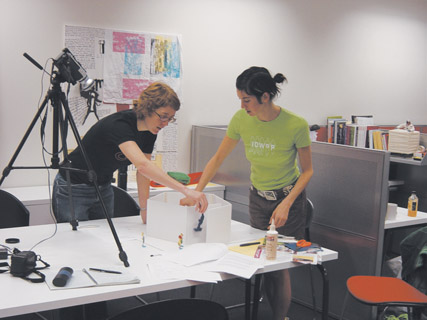
Lian Loke, Kirsten Sadler, prototyping Bystander
photo Toni Robertson
Lian Loke, Kirsten Sadler, prototyping Bystander
ARTISTS HAVE ALWAYS SOUGHT WAYS OF SEEING THE THINGS THEY ARE MAKING THROUGH OTHER EYES. GETTING MORE THAN ONE PERSPECTIVE ON A WORK IS OFTEN AN ESSENTIAL PART OF THE CREATIVE PROCESS. IN THE WORLD OF COMPUTER-BASED INTERACTIVE ART THIS NEED IS INCREASINGLY FOCUSED ON A VERY PARTICULAR KIND OF ARTEFACT: THE PROTOTYPE.
This article is based on interviews with artists and curators involved in prototyping interactive art and a reflection on my own work with Beta_space: a dedicated public prototyping environment.
All artforms have their particular ways of being unfinished: rough cuts, maquettes and works-in-progress. These act as proof of concept and invite feedback. The prototype has been imported into interactive art from its origins in engineering via the interdisciplinary field of interaction design. It refers to an original, functioning model which might be hi or lo-fi, and which might represent component aspects of an art-work or a full mocked-up version. The growing use of prototyping in the field of interactive art reflects the need for artists to learn from design methodologies that deal specifically with the problems of human interaction with complex computer systems.
Lian Loke and Toni Robertson are experts in the fields of software engineering and interaction design. They are also artists with practices in performance art and print-making respectively. In 2004-5 they worked with Ross Gibson and Kate Richards on the design of the interactive art-system Bystander, which included several prototyping sessions involving members of the project team and invited participants.
Toni describes prototyping as part of an iterative process of “bringing into being”, through visualisation:
Prototyping is a way of being able to see and reflect on some aspect of an unmade work as part of its making. It’s a way of seeing things that do not yet exist in order to get them to exist.
Toni points out that many artistic processes are iterative in this way and use “interim representations” to reach their final product. In interactive art, however, these representations are the only way that makers can work with the amorphous and uncontrollable aspect of human use. To create a system that effectively responds to this unpredictable material frequent tests are required to challenge the creators’ assumptions about what people might do, as Lian describes:
In interactive works like Bystander, artists are…experimenting with the way people make meaning and with trying not to direct that…Because of the scale of Bystander there were lots of mockups and evolving prototypes along the way…lots of assumptions got challenged—like how people would behave in the space and react to the material.
The level of involvement of the public in prototyping however is controversial. Kate Richards has a long history of using prototyping as a producer of multimedia projects and in her own creative practice. She prototyped her most recent work, Wayfarer (with Martyn Coutts), to an invited group of colleagues during a Performance Space residency in September. She warns that while prototyping is essential it requires careful use:
What’s important is for artists to ask “what are the appropriate tools [from interaction design] and when to use them?” It can be a problem for artists to be too audience focused. Interactive art has to function, so you’d be crazy not to use these tools…but the tools can’t drive the work. The artist has a vision and they have to create the thing and it’s not going to work for everyone.
How can we use prototyping to open up the creative process and include the audience whilst understanding and avoiding the risks? This question is being addressed in the Beta_space initiative—a partnership between the Powerhouse Museum and the Creativity and Cognition Studios at the University of Technology, Sydney. Beta_space is an experimental exhibition venue in the Powerhouse where artists can develop interactive artworks through feedback and collaboration with an audience.
Involving people in public exhibition settings in the process of prototyping can provide valuable benefits. In terms of technical refinement the demands of public exhibition and public use cannot be recreated in controlled environments. For artists the responses of a diverse audience to a prototype can be incredibly rich and revealing. On the other, hand opening up the creative process takes a lot of courage. It is hard psychologically to leave something ‘unfinished’, open to judgment before it is ready to stand alone. Matthew Connell, Curator of Computing and Mathematics at the Powerhouse, and a driving force behind Beta_space, points out that this can also be uncomfortable for the audience. Showing work-in-progress demystifies the normally closed practice of making and challenges the audience’s notions of how to respond to artworks in a museum as complete expressions of an artist’s intentions.
The first part of the solution to these problems is the way the prototype is presented to the audience. A prototype should not be presented as an ‘unfinished thing’, but as part of an ongoing process of dialogue between artist and audience. The prototype is a way of stimulating and grounding imagination. It offers a tangible, shared experience which can be the basis of discussion. It is important to manage and support dialogue between audience and artist by framing the prototype this way and providing structured opportunities for audiences to contribute to the discussion.
The second part of the solution is in supporting the artists. George Khut experimented with prototyping his work Cardiomorphologies during a Performance Space Residency and at Beta_space. (For a vivid description of the finished work, see Tim Atack’s “Cyborg Dancing”, RT72) Khut describes the experience as “a luxury”, to have the opportunity to “take myself out of my own given point of view and see the work differently.” But for him the question was: “How do you derive meaning from this cacophony of voices?” At Beta_space we concentrate on helping artists to meet the audience half-way by articulating the function of the prototype as a part of a trajectory of developing practice. We work with artists to help them clearly express the experiential objectives they are working towards and their aims for the prototype exhibition.
In the case of Cardiomorphologies, there were two key aspects to the audience experience that Khut was trying to create: firstly a sense of integrated physical and mental engagement with the work and secondly a reflective state in which participants consider correlations between thoughts and specific physiological states. For the prototyping process we established a set of affective aims at the outset which articulated these experiential goals as clearly as possible, such as “sensual and kinaesthetic”, “close fitting”, “explorative/curious” and “enabling.”
During the prototyping sessions, audiences described responses that showed how aspects of the visual and sonic design were generating the visceral experiences Khut was interested in. One of the participants said, “At this point…I’m all engaged by the circles…I think they’re amazing and I was trying to experiment with my own breathing to see how much of the shape I can sustain …I’m trying to create something with my breathing here. It’s a very joyful experience.” On the other hand, collaborative work with audiences in workshop environments showed that some of the more reflective aspects Khut was working towards were not materialising in the work. Unexpectedly we found that the format of the prototyping sessions, in which audiences described their experiences in great detail, either alone or in groups, actually contributed in itself to achieving this “reflective state.” This led to a reassessment of the experiential goals for the work, and also of the means to achieve them.
Seen this way prototyping can be approached as more than just a design tool, but as a form of creative practice. Khut reflects on the impact the process has had on his work:
I am considering how these [processes] might constitute a form of relational or dialogical practice in their own right, developing the idea of the gallery as a place where people can explore and extend their abilities to imagine and relate aspects of their experience and being in interesting ways.
The implications of this approach to public prototyping also reach to the heart of curatorial practice. Prototypes are situated somewhere in the provocative middle-ground between objects and experiences. As museums and galleries make the transition from an object-based to an experienced-based culture, public prototyping can itself be considered as a prototype for a new way of conceptualising their role as cultural institutions. For Matthew Connell Beta_space is itself a test-case, a forerunner of what he describes as “a vision of a new kind of museum space that is all about process, experiment and collaboration.”
Thanks to Matthew Connell, George Khut, Lian Loke, Kate Richards and Toni Robertson for their contributions to this article. If you are interested in showing a prototype in Beta_space please visit www.betaspace.net.au
RealTime issue #76 Dec-Jan 2006 pg. 24
© Lizzie Muller; for permission to reproduce apply to realtime@realtimearts.net
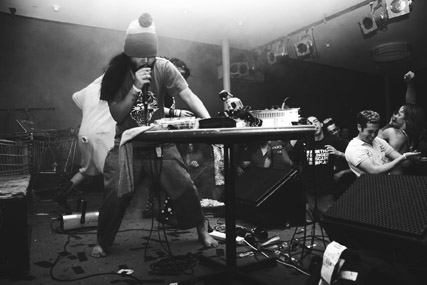
Scotch Egg, Gado! Gado! Gado!
photo Alex Davies
Scotch Egg, Gado! Gado! Gado!
ELECTROFRINGE HAS OUTGROWN THE CHEERFUL AMATEURISHNESS OF ITS ROOTS AND TAKES THE QUOTIDIAN BUSINESS OF FESTIVALS IN ITS STRIDE. THE RUN-OF-THE-MILL BUSINESS OF FESTIVAL, WHICH IS INNOVATIVE AND WELL CURATED EXHIBITIONS AND SHOWS, ARE ALL PRESENT AND CORRECT. MORE CAPTIVATING though ARE THE ODDITIES OF THE MANY-APPENDAGED BEAST.
Because while these events aren’t always successful, neat, or even deliberate, the volume and quality of that bizarre spontaneous insanity is the flesh on the solid Electrofringe bones of conventional festival fare.
It’s a delicate business, the fostering of spontaneity. Hybrid media jam venue Collabrador doesn’t have it this year, not to the same degree as last year’s digital arts debauch of the same name. Unreasonable Adults, however, are doing a solid job over at Gift/Back on Hunter St. Like most things at Electrofringe, if it doesn’t begin in cyberspace, it at least protrudes into it, and I guess that’s the motivation for their inclusion in a new media show. Either that, or their hybrid media nature puts them on the same page of a funding acquittal. Whatever the excuse, they are a stack of frenetic fun, remixing such diverse ingredients as books, videos, ministerial correspondence and chocolate bars from punters into an equally diverse profusion of video snippets, photos and sleep deprivation. In their hands, random items, suggestions and textual snippets from all-comers are the seeds of an ebullient upwelling of things performative. The injunction “make a one-minute musical”, a discarded embroidered red dress, and the SMS poem (or IRC chat log?) ‘she is…’ become possibly the world’s shortest musical to still cram in a toe-tapping tune at one minute and 42 seconds. As such, it’s a marked improvement on the genre of the musical all round, with new media cred to boot.
The Unreasonable Adults’ genius is in the material they coax from their audience. As many media as they are toying with and as dispersed the crowd, the Adults still work the Electrofringe audience with a captivating mix of childishness and wryness. The submissions they elicit in the course of their play are little works of art themselves, and they are preserved on the Unreasonable Adults website: “You have to randomly include numbers one inclusive to 512 into your improvisations in no sequential order. Or sequential if you want more of a challenge.” “When you say the word ‘and’ you have to physicalise a Rodin pose…” Or the items “2 x Multicoloured feather boas; Chimes; a packet of 15 whistles; four leaf clover ‘good luck’; Tetrapak purse with 25 cents and old celery; a piece of coral from Daydream Island.”
Holding the banner for the non-sampling, 100% new material contingent is Spain’s hybrid dance Colectivo Anatomic whose AV dance/musical performance piece RAW is noticeable both for its total absence of any unoriginal or sampled material, and its verbose concatenation of every conceivable funding-ready sounding component of new media art. Custom control interfaces? Tick. Motion tracking eyeball controllers? Tick. Mobile devices? Hybrid media? Custom software? Multichannel live video remixes? Tick. What it lacks, sadly, is coherent vision. It’s not like they are at all unskilled, either. Their custom motion-sensing video projection piece was surely the most tightly integrated, well-rehearsed and smooth motion tracking projection performance I have seen. But it was still two dancers running around without detectable motivation after a projected dot, sandwiched between two other performances, with little coherent justification other than showing off their PDAs.
Back to the world of questionable intellectual property then, where we’re all comfortable. Filastine’s set at the festival was an essay in, among many things, artful appropriation, world cultures of music and industrial zoning chic. From a podium of two shopping carts affixed with auxiliary bullhorns, they mix Cuban, drum and bass and hip hop tracks in at least three languages and play a profusion of percussion instruments, including the shopping carts themselves. It’s a danceable but painfully literate set, crossing smoothly and respectfully between traditional rhythms of South America, the Middle East, India and various schools of music in which I am totally unversed. In terms of source material, if not production techniques, this set is remarkable for the explicit avoidance of the musical hegemony of the West, combining tracks and loops on their own terms. After the somewhat restrained record playing of the prior hour, the crowd explodes. This dreadlock’d gentleman has the advantage of being at one of the moments, if you had to pick two, that climax the festival. The other contender occurs only a few minutes later, an unplanned exploration of collaborative live jam spontaneity: dual-gameboy-and-megaphone gabbacore DJ, Scotch Egg, aka Shigeru Ishihara has taken the stage and incited the crowd into near epileptic convulsions with what afficionados term ‘spastic beats’, and is dancing onstage with a woman in a furry chicken suit. Then Newcastle fixture Peter “Shok” Hore, aka Peter Michael Howard, Serial Pest, crash tackles Shigeru’s precarious bar table of gear, simultaneously invalidating a half dozen warranties and dislodging sundry leads, cartridges and batteries. The most ear crushing silence I have ever heard ensues.
The crew down the stage lights while Hore is bodily ejected from the venue. In the brief window of audibility Filastine has started spruiking his music from an upturned bin by the toilets, and it’s the grimy panic-riddled but desperately fun face of This Is Not Art (TINA) we’ve come to love. I don’t have exact change to buy his latest album… “You can download it with p2p filesharing instead,” he says, “or I’ll throw in my last album for 5 bucks and we can make it a round 20.” Having thus found a model solution to a decade of digital intellectual property conundra and scored me two new CDs in a single act, we are drowned out by the birth cries of Scotch Egg’s rebooting Gameboys. Three minutes later Hore walks back in the other door, which has a different bouncer, and is dancing in the front row to the renewed barrage. Oh yes, we like our intractable madness here.
TiN Radio is the stalwart hold-out of TINA/Electrofringe institutionalised chaos, a kind of grab-bag festival clearing house of podcasts, net streaming and even FM broadcasting. Sandwiched between pine-effect chipboard partitions, behind a sign proclaiming “Newcastle Sight-impaired Radio”, the studios heave with an endless stream of guests through the not-just-metaphorically open doors of the not-quite anechoic space, snuffling and cracking through the not-really-studio-grade mixer. Under-resourced, perpetually late and messier than my bedroom after a housefire, TiN Radio looks like a disaster in waiting, but they reliably produce the goods, particularly in the genre of ‘rawcus.’ The wanton collaboration of The Night Share, for example, is dead on the money. This project is a joint venture between many parties united under the banner of Radio National’s most fearlessly mutating audio project, The Night Air. Although it isn’t quite the debut of their Radio National remixing project, it is the boldest thus far.
The first part of the show, Live Feed’s consensus internet-driven mixing experiment is the most radical in production—a different studio setup with impromptu ill-prepared vox pops, live input, including actual pancake chef, in the studio and production over the net-driven August Black’s browser-based Userradio collaborative software. The product is predominantly smooth and surprisingly subtle, with occasional jarringly repetitive interjections, distinctly close to the typical aesthetic of The Night Air. Which may or may not be an endorsement of The Night Air, depending on your faith in the public. For my part, it makes me exceedingly happy. After half an hour of this, Enter Escape’s more conventionally disco production is a welcome stylistic break, dropping the collaborative impromptu mixing for a solo impromptu bracket, macerating the Radio National back catalogue into a parodic mélange of détourned reportage… The Religion Report, amongst others, is thoroughly raided for funk cliches on the theme of “soul”, and all this is interspersed with the room noise and cheers of a crowd of fellow collaborators in the throes of mixing down their own contributions on this, the final night of the festival. And, of course, it’s all podcast.
Electrofringe, curated by Sumugan Sivanesan, Ben Byrne, Cat Jones; This Is Not Art, Newcastle, Sept 28-Oct 2; http://www.electrofringe.net
Unreasonable Adults, http://unreasonableadults.va.com.au/giftback_newcastle.html
Filastine, http://www.filastine.com/
DJ Scotch Egg, http://www.adaadat.com/artist.php?artist=3
TiN Radio, http://www.tin.org.au/
The Night Share/Electrofringe: live_feed, Sophea Lerner, Andrew Burrell, August Black, Jodi Rose, IONiC, Stephan Wieland, Shannon O’neill, Lloyd Barrett, Lucas Darklord, TiN Radio, http://www.abc.net.au/rn/nightair/stories/2006/1732373.htm
RealTime issue #76 Dec-Jan 2006 pg. 25
© Dan MacKinlay; for permission to reproduce apply to realtime@realtimearts.net
ON A BUSTLING FRIDAY NIGHT IN BRISBANE’S BURGEONING SOUTHBANK PRECINCT, IT WAS HARD TO MISS THE LARGE CROWD GATHERED AROUND WHAT LOOKED LIKE A GLOWING BLUE HIVE-LIKE STRUCTURE, THE [V3] ART+ARCHITECTURE SHOW.
Flanked by the two long, thin canals that run parallel to the Brisbane River and QPAC, the 3D multiscreen installation consisted of five large screens arranged in a hexagon with a space left for entry and perambulation. Projectors were unobtrusive, mounted high on the outside, and though the breeze was fresh that night, the screens, slung between sturdy poles and carefully buttressed, remained resolutely smooth. The steel scaffolding securing the screens with an impressive array of clips and struts, was the first sign that this was no ordinary video art event. As key instigator, Rachel Barnard of the Architectural Practice Academy, noted, “we put a lot of effort into making sure the screens would stay up and withstand the wind.”
Barnard explains how the project came about when she and other architects from yarch.Q, a committee of the Royal Australian Institute of Architects, “were talking about films that are architectural and how it would be great to get a cinema to show a series of these…We’d attended a workshop involving a 360 space simulator to view in 3D moving image analysis of space, which we loved, but hadn’t had a chance to explore it further. So we thought, let’s do it. We then came up with a whole series of ideas and 8 months later actually did it!”
The cinematic reference is important, because the second part of the show, in which the works were screened sequentially, after artists’ introductions, felt a lot like a short film program (albeit a multi-screen, outdoors one). The film program effect was offset by the opening and closing events in which spectators saw images of themselves in the space on the night. Rachel explains: “On arrival, there was a delayed live feed playing—in this way the viewers encountered themselves from the past. This process of looking back in time at oneself aimed to titillate but also emphasise the temporal nature of new media art works. Similarly at the end of the night there was a delayed live video feed which showed the construction and the event itself at the end of the night.”
The program of works included video art by local artists and architectural new media presentations. Christina Waterson’s Concealed Revealed is normally hidden in the urban fabric of everyday life. A series of still images interwoven with video pieces, the fast-paced montage of Concealed featured scenes of quotidian reality overlaid with the kind of analytic frameworks and schematic diagrams architects are privy to but of which the rest of us are generally unaware.
A different kind of architectural analysis of the space was evident in Chermside Theatres, by m3Architecture project team Michael Lavery, Ben Vielle and Emma Healy. This featured a 3D ‘fly through’ of the proposed architectural re-design of the site formerly hosting the Dawn Theatre. For an art audience, it was a reminder of the level of sophistication and aesthetic achievement professional animation can attain. Similarly, in architect Ashley Paine’s untitled 1-minute video produced for the exhibition, a complex layering of appearing and disappearing graphic patterns sought to reveal, according to his statement, “new patterns that reinforce the shifting and subjective nature of vision in the original work, while introducing temporality and instability to its construction of visual space.”
On the relationship between art and architecture, Rachel says the affinities are evident, as “they converge both conceptually and actually. After all, both deal with space. [V3] is an example of this convergence. As architects and designers we wanted to explore the relationship between the moving image and space. What happens if a video work ‘expands’, so to speak, to form a spatial experience? We tried to arrange our screens so that people could not only watch a moving work but inhabit a space defined by the moving works. From this we played with ideas of dimensionality, temporality, and the spectator as spectacle.”
Of the work by artists, Gen Staine’s Time Space Frames was ideally suited to the event, especially since one of its most striking images features an alarming series of cracks appearing on the performing arts building (located adjacent to the installation). I found myself wishing again that this beautiful, subtle work, which comments on photography, urban architecture and memory, was longer, especially in the multi-screen mode.
Chris Bennie’s No Faculty Among Us, consisting of a single moving image of a shimmering swimming pool, was also striking in its simplicity. The ethereal effect of the rippling aqua water and serene lane striations was suddenly upset by the appearance of the swimmer, and made strange by our realisation that our view was upside-down. The emphasis was on the revelation of the purely pro-filmic; according to Bennie, “the work aims to render the repetitious and the common as remarkable and extraordinary without embellishment or pretence.” Formally strong and confidently executed, No Faculty Among Us was shorthand for the assured, creative and revealing exploration of space that characterised the whole [V3] night.
[V3] Art+Architecture event, organisers Rachel Barnard, Ye Ng, Jane McGarry for Architecture Week, Queensland Performing Arts Centre forecourt, Southbank, Brisbane, Oct 27
RealTime issue #76 Dec-Jan 2006 pg. 26
© Danni Zuvela; for permission to reproduce apply to realtime@realtimearts.net
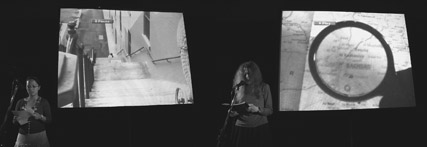
left – Ivy Alvarez, right – J S Harry
Poetry Picture Show
left – Ivy Alvarez, right – J S Harry
THE RED ROOM COMPANY WAS ESTABLISHED IN 2003 WITH THE AIM OF CREATING, PROMOTING AND DISTRIBUTING POETRY TO THE PUBLIC IN NEW AND UNUSUAL WAYS.
Since then it has produced projects such as the innovative Toilet Doors Poetry project in which illustrated poems replaced advertising in the dual public/private space of a number public toilets around Australia, and Poetry Crimes, which used radio and the internet to showcase poems on the theme of crime and justice. In 2006 the first series of The Wordshed, a television show devoted to poetry and writing, was aired on the Sydney community television station, tvs. For The Poetry Picture Show 10 established and emerging poets were commissioned to each write a single poem that engaged with the moving image, to write poems that ‘moved.’ The Red Room Company then made 10 one-minute films inspired by short sections from the poems. The work resulted in a one-off performance of films and poems, augmented later by podcasts, videocasts, a DVD and a continuing blog devoted to discussion of the project.
The night began with JS Harry’s long poem “Journeys Digital—& ‘Other’ Worlds.” Somewhere, around halfway through, these lines reverberated with me:
It is over five months since Saddam’s huge statue
was pulled down — & that act — & scene
turned into photographs,
& recycled, for money,
sometimes with enigmatic US soldiers’ faces
& a few close-ups of excited teenage Iraqi boys, & men,
with stories about the ‘fall’ of Saddam’s regime
on newspaper front pages around the world.
The decision for Harry to read first was a good one as the poem prepared the audience for the complex issues that the dialogue between film and poetry opens up. Harry’s poem dealt with the entanglement of life with the bracken of visual technologies that increasingly construct it, and how this plays out in one of the most watched (and, perhaps not coincidentally, hidden) countries: Iraq. “Isn’t it rather soon for it to be released as a DVD?”, one of the characters asks, articulating a generation’s unique anxiety about the relation of the image to the real. The density of bodies—from the dictator’s statue to real flesh bodies—was continually brought up against the surface of the television and photographic images that represent them.
Other poets took the brief to write poems that move in various ways. John Tranter—whose work, at least since his 1973 collection, Red Movie, has been engaged with cinema and the moving image—contributed a bizarre and hilarious reading of Martin Ritt’s Paris Blues (1961). David Prater did something similar in revisiting the 80s flick Can You Feel Me Dancing?, while Sarah Holland-Batt’s The Limitations of Form was written after Michelangelo Antonioni’s Blowup (1966). Briohny Doyle’s poem, The Widest Wide Shot, used the conceit of the film pitch to explore the connections between memory and image, while Felicity Plunkett’s The Negative Cutter: An Introduction to Editing borrowed phrases from the technical language of film editing as jumping-off points for poems.
The film inspired by JS Harry’s poem was an abstract piece constructed from various images deployed in the poem: the audience saw a magnifying glass scrolling over a map of Iraq, a huntsman spider, and heard horrific effects that sounded like they were derived from ice cubes being snapped out of a tray. Having just heard Harry’s poem, the audience seemed unsure what to make of this work. Was it a film translation, or an accompaniment? Furthermore, what kind of film, if any, could have taken this poem—already so critically engaged with image-culture—somewhere else? Possibly it was the absence of narrative in Nathan Shepherdson and Sarah Holland-Batt’s poems that encouraged the filmmakers to extend the poems into their own filmic spaces. But apart from these two examples, the filmmakers chose to respond literally to the poems’ images, depicting only their most ‘visual’ aspects.
The films were projected after each poet had finished reading. Guarding the integrity of each poem and film in this way meant there was little opportunity for the artforms and their various elements—spoken language, moving image and soundtrack—to work in combination. There was a sense that this meeting of poetry and film was a bit over-determined: that two forms, always necessarily connected, were being introduced as if for the first time. An imbalance in the organisation of the show became apparent: while the poets were commissioned to produce their work, the films were produced by members of The Red Room Company themselves in collaboration with the poets, meaning there was a similarity of style and approach across the 10 films. Taking on different filmmakers might have brought a fresh approach to each ‘film-poem.’ Other text-image projects from the last few years have worked successfully in this way: the Red Room’s own Toilet Doors Poetry project and the 2002-2003 project Cornerfold (www.cornerfold.com.au), which commissioned artists and designers working in computer media, comic artists, zinemakers and writers to create online animations.
Over the last four years The Red Room Company has expanded the reach of Australian poetry, distributing and broadcasting online, on radio, TV and in public spaces. Its projects have given people who might not have otherwise had a chance to encounter poetry, and to meet it in ways not normally presented. The challenge for the Red Room now is to allow poetry the room to change and evolve as it starts to engage with new media, while keeping those things that poetry already does best: the quiet work of language in a room or on a page. Hopefully the Poetry Picture Show and its online existence has opened up a dialogue in this area that will continue.
Ten of the poems and films from The Poetry Picture Show are available as podcasts, CD, DVD or online at www.redroomorganisation.org and with commentaries in The Poets’ Guide to Picture Shows blog at the same address.
The Red Room Company, The Poetry Picture Show, Old Darlington School, Redfern, Sydney, Oct 6
RealTime issue #76 Dec-Jan 2006 pg. 26
© Tim Wright; for permission to reproduce apply to realtime@realtimearts.net
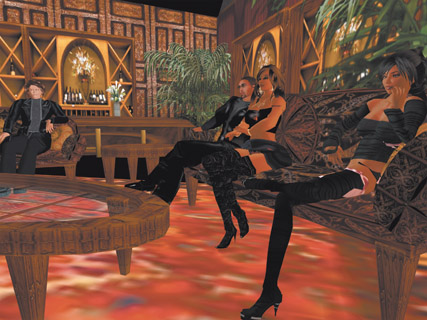
Image Lythe Witte (front left) and Property Resistance (back right) lounging with friends at the Oasis Jazz Club
SECOND LIFE IS LEGO FOR ADULTS. RATHER THAN BUILDING MINIATURE HOMES WITH COLOURFUL PLASTIC BRICKS, GROWN-UPS ARE PUTTING THEIR HARD-EARNED CASH INTO TRANSLUSCENT CLAY: PIXELS.
Second Life (SL), if you haven’t already heard, is an online virtual world with over one million registrations. It’s a 3D space that you enter and move around. Unlike massively multiplayer role-playing games like World of Warcraft, Linden Labs (the company behind SL) decided to offer no game, no missions, no tasks or roles to play. It is up to the residents of SL not only to inhabit but create it and everything you can do in it, pixel by pixel. So what do the SL residents, who are on average 32 years of age, choose to create?
everyday avatars
In Hinduism, an avatar refers to the embodiment of an immortal being. In virtual worlds, an avatar refers to the embodied representation of each player or resident. I have an avatar, but cannot claim any access to divine knowledge. And, unlike the imaginative incarnations of Hindu beings, such as Hayagriva’s human body with a horse head, the bodies preferred by SL residents are surprisingly vapid. Most avatars in SL are ‘ideal’ forms such as tall, slim, glamorous women and men with washboard abdominals and even musclier arms. Unlike real life, it is harder to put on weight, age and be ugly in SL. In order to corrupt your avatar you need to either tweak your appearance or buy another. You can look, dress and act any way you like in SL, for a price.
You can choose another gender or species, various personae (Brad Pitt, Yoda), an abstract installation or create your own. Your decisions about how you portray yourself in this world are important because other avatars judge you on those choices. Many residents choose idealised forms for the experience—how it feels and how you are treated. As well as a body, SL residents can buy clothes, hair, hats and nail polish. Everything you try on fits: jeans, dresses, jumpers, tuxedos. These personalisation practices are not unique to SL or virtual worlds, but the facility to be infinitely bold is embedded in the option to program yourself, literally. SL also provides the capacity to weave this construction beyond the avatar to a home and lifestyle.
virtual house and garden
Residents of SL can purchase land and build homes. Rather than suburbia or futuristic hover cars (although they are there), the landscape of SL is a collection of islands that can be tweaked to your heart’s desire. There are tranquil waterfalls, three-storey homes with waterfront views and yachts docked out the front, castles, shopping malls and casinos. Homes can be fitted out with stainless steel kitchen fittings, fireplaces, shag carpets and swimming pools. Residents buy their homes, goods and services from small or large inworld department stores and, wait for it, their favourite designers. Just like real life, there are celebrity fashion and furniture designers and architects in demand. Indeed they often have their own websites and print magazines to advertise and discuss their businesses. Parallel to these SL-specific designers are real world ones that have come in to SL to extend their ‘brand’: residents can buy Adidas sneakers, sip cola out of Coke cans and drive a Pontiac. Why do residents choose to work in a world where they don’t have to?
taking home virtual bread
There are two factors that facilitate this activity: Linden Labs “recognizes Residents’ right to retain full intellectual property protection for the digital content they create in Second Life” (Second Life website) and the inworld currency (Linden Dollars) can be converted to US dollars and deposited into your real life bank account. There are residents, therefore, who earn a living from the money they make in SL. Anshe Chung, for instance, earns over one hundred thousand (real) dollars each year from selling virtual real estate (www.anshechung.com). A resident doesn’t have to run their own business though; they can earn Linden dollars from the services they provide as model, lap dancer, escort, DJ, wedding planner, bouncer, bar person or artist. There are also many real life visual artists, filmmakers, musicians and writers creating inworld representations of their works and streaming live performances.
is SL all work and no play?
Irrespective of the seemingly infinite potential that SL provides as a creative platform, it is a ghost town without the richness of interaction. It is not until people socialise and converse about scientific theories, business practices or relationships that visitors become residents. This shift to seeing oneself as part of a world is facilitated by the cultural and intellectual activity within SL and the ability to communicate more richly. Rather than rely on voice or text, you can run scripts that animate your avatar to laugh, hug and even seduce. Indeed, residents start relationships with varying degrees of real life consequences, get married and have virtual children. However, you can participate in many ways without such intense bonding.
How about dancing and sucking on a cigar at a jazz club or attending an inworld concert with Suzanne Vega or U2? You could also check out The New West, an exhibition of resident—created virtual art which was part of ZeroOne San Jose/ISEA2006 (www.ludica.org.uk/NewWest/). Or, if your inclination is literary, attend Cory Doctorow’s book launch and read his book inworld. If it’s theatre you’re after, see a play at The New Globe or play an elf in a Lord of the Rings simulation. If it’s knowledge you’re after, then attend a lecture streamed in from the Harvard Law School (blogs.law.harvard.edu/ cyberone) or take a class in international new media at Second Lifes’ NMC Campus (www.nmc.org/sl). Or, you could learn about rockets via a live video feed from NASA at the International Space Flight Museum (slispaceflightmuseum.org). If all this ‘high’ culture is a bit too much in a cartoon land, you can always fly over Big Brother in SL and watch fellow avatars throw scripted tantrums over virtual food (www.bigbrothersl.com). Doesn’t this sound like an ideal world?
straw homes
Virtual homes are like houses of straw in that they can be easily blown down by the big bad corporation. When SL is down because of a ‘griefer’ attack or for updates, people are locked out of their second life, their mode of interaction with friends and family, their businesses and classrooms. Sal Humphreys, a post-doctoral Research Fellow from the Queensland University of Technology, has observed the implications for people moving their social lives online to proprietary spaces. So, why do people invest so much time and money in a world that they do not own? Residents do not see themselves as subscribers paying to access Linden Labs’ proprietary world.
Instead, some see themselves as paying LL to manage the world on their behalf. LL is in service to them. This is a paradigm shift in the way ‘users’ are approaching many so-called user-generated sites…a shift that is not shared by the corporations who run these sites. Players, residents and staff persist however. Why?
beyond holodecks
Many online virtual worlds trigger fantasies that the Star Trek holodeck has been realised. A holodeck is that mutable space where the crew of a future spacecraft can summon any scene their imagination conjures. Just like Lego constructions scattered over the loungeroom floor, the holodeck is a space where fantasy takes place. Virtual worlds like SL, however, induce the butterflies-in-the-stomach feeling that a pervasive parallel world is emerging around us. If you can socialise, marry and work in this second life, then isn’t it an equal reality? Irrespective of the intangible nature of the SL world, for many it’s the beginning of a new world and a new species.
Second Life: www.secondlife.com
RealTime issue #76 Dec-Jan 2006 pg. 27
© Christy Dena; for permission to reproduce apply to realtime@realtimearts.net
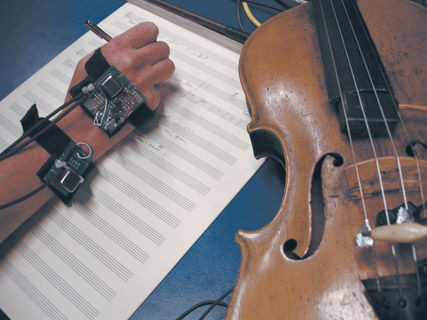
Quartet, Margie Medlin
MARGIE MEDLIN’S QUARTET EXPLORES MULTIPLE PERSPECTIVES ON THE MOVEMENTS OF MUSIC AND DANCE THROUGH REAL, VIRTUAL AND MECHANICAL MEDIUMS.
In this second article on Australian/UK-based artists in receipt of prestigious Sciart Awards from the Wellcome Trust in the UK (see Gina Czarnecki, RT 75, p33), RealTime talks to Margie Medlin about her Sciart project.
Medlin is completing the performance stage of research on the project throughout the UK winter with shows scheduled for February 2007 at the Great Hall of St Bartholomew’s Hospital in central London. In this ornate historical setting, Medlin and her team will place a dancer, a musician, a robot camera and two screens, one framing a virtual dancer, the other the point of view of the robot camera.
The idea of using a musician’s gestures to effect a virtual dancer is fascinating—it raises questions of a kinaesthetics of music—what movements produce which sounds which in turn produce new choreographies…? How does it work in Quartet?
A duet between the musician and virtual dancer [created by Holger Deuter] uses both gestural and audio data. Stevie [Wishart] plays the violin, works with her voice and controls 3 virtual instruments based on computational models of human hearing created by Todor Todoroff with the Physiological Lab at Cambridge. Stevie is wired with sensors so that any single action from her can do several things at once—creating sound from any of the 5 instruments, effecting the virtual dancer’s body parts, speed of movement…The virtual body control interface for the project was created by Nick Rothwell.
Is Stevie improvising this performance live?
We are going to have to set a lot of it although she is primarily an improviser and we began with this. We have tried out many of Stevie’s violin playing techniques, such as cross-bowing and plucking, to discover which are the most useful actions in terms of effecting the dancer’s movements and also which have the most intuitive relationships for Stevie as an instrumentalist. Our work together in July and August this year was the first chance we’ve had to connect the two systems as a creative investigation rather than systems testing. The idea is that we make presets or states of sensitivity in the virtual body that Stevie can improvise within. This is very refined work and needs a lot of concentrated effort from Stevie and the team to calibrate her instruments and the interface with the virtual dancer. And at the same time we are looking for visual keys for the audience to understand the connections playing out in real time.
So Stevie is really choreographing the virtual dancer…?
That’s it, or rather her sound and gesture. The other duet is between the live dancer and the motion-controlled robot camera that Gerald Thompson, Glenn Anderson and Scott Ebdon created for the project. The dancer [Carlee Mellow] is wearing three sensors, two 2D sensors, one on her shin and one on her thigh, and a 3D sensor on her chest. The data collected from her sensors becomes the information that runs a motion controlled robot camera.
The robot has three limbs and five motors each operating on an axis and then there’s a small surveillance camera mounted on the robot’s ‘forehead’ capturing its real time point of view. This will be projected during the performance. So the actions of the real dancer are being replicated by the robot and there will be a video projection of the footage shot by the robot camera. This moving image is a representation of the dancer’s movement—from her point of view.
And the data from the real dancer is also going to the virtual dancer, to her left leg and chest. The data from Stevie is going to the virtual dancer’s head, the right leg, the arms the hands and right fingers. Part of the reason we did that is because it’s incredibly difficult for Stevie to meaningfully control the virtual body, to get a sense of connection or flow through the body. In the first stages of Stevie’s connection to the virtual dancer we could only work with ‘close-ups’ on an arm or a leg. We needed to make connectivity through the whole of the virtual body and expand the connection between the dancer and the musician. This is a crucial point because the project is about the transfer of information, how it changes from medium to medium. So the musician and the dancer are controlling different parts of the virtual dancer’s body, but the live dancer’s stuff isn’t programmed at all—it’s responsive.
So the ‘real’ dancer is filling a gap in the information—and is the dancer responding to the musician?
Sometimes yes. There are a number of segments within the performance, for example there’s a duet between Stevie and the real dancer, a duet between Stevie and the virtual dancer, a duet between the real and virtual dancers, a trio between the robot, the virtual dancer and the real dancer etc, building to the quartet.
So the project is about the relationship between the virtual, real and mechanical, but also the observation of those relationships?
An observation and a highlighting of each of those relationships and what happens with the transfer of material, data, intention between them. But also the essence of where that information is coming from—for instance the real people, the musician and the dancer. I’m hoping that the nature of the source of the data will be highlighted as well—what you are drawn to, what’s alluring, what catches and holds attention, where you think the power lies between the virtual, the mechanical and the live elements.
Your interest in the dancer’s point-of-view was apparent in the film you did with Sandra Parker, In the Heart of the Eye. What is it about this particular line of research that keeps you coming back?
It’s about the choreography of cinematic space. There’s been a whole other stage in relation to this research in between, with my three screen work Miss World 2002 which has not been shown in Australia, and it started with Elasticity and Volume [installation, 1998]. When you look at the footage of the dancer’s POV alone, it doesn’t make any sense and can’t hold your interest, its confusing and irritating. As soon as you put the dancer with it, it makes complete sense and is really fulfilling. I’m interested in the relation between that out of control image and the sense of embodiment you get when you put that image in a relationship with the ‘source’ dancer. It’s about the poetics of looking, creating an imagination of looking.
Rebecca Hilton has been the choreographer involved in the first two stages of development. The other choreographers involved in the project are Lisa Nelson (USA), Lea Anderson (UK) and Russell Maliphant (UK). What will they each contribute?
Rebecca made some of the material that Carlee will develop for the performance—a set of alphabetic building blocks—but Lea, Russell and Lisa haven’t been involved at all yet. They’ll come to the rehearsal and each have 10 days. I have asked Russell to work with Carlee on the dancer’s solo and to work with Stevie on the gestures and sounds that she makes and how that impacts on the virtual dancer or vice versa. I’ll ask Lea to work with Carlee and the robot camera and I’ll ask Lisa to work with Stevie and Carlee on the improvisational relationship between the two ‘real’ elements.
They are all very different choreographers in terms of style. Will that complicate things?
I think it’s all very complicated. Having different artists exploring these complicated systems gives an expanded idea of what is possible. I am interested to see how people can use these systems. They will not be given any time to make technical developments but will be asked what they can get from the systems we have developed.
Quartet will be presented at The Great Hall, St Bartholomew's Hospital, London, February 14-18, 2007. Quartet has been funded by Sciart Production Awards 2005-6 in collaboration with the Physiological Laboratory at Cambridge University and the Arts Council of England. It is co-produced by the Performance and Digital Media Department at the Institute of Contemporary Arts, London, with support from the Australia Council for the Arts, Arts Victoria, and ZKM Center for Art and Technology, Germany. www.quartetproject.net
RealTime issue #76 Dec-Jan 2006 pg. 28
© Erin Brannigan; for permission to reproduce apply to realtime@realtimearts.net
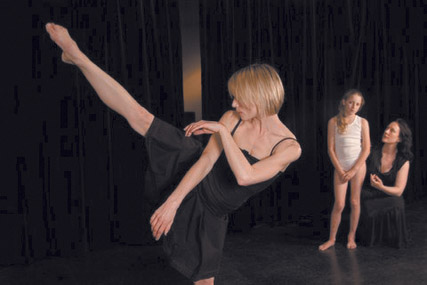
Lisa Griffiths, Isabella Trigatti, Amanda Phillips, Crush
photo Sam Oster
Lisa Griffiths, Isabella Trigatti, Amanda Phillips, Crush
ADELAIDE’S AMANDA PHILLIPS AND MELBOURNE’S FRANCES D’ATH HAVE UNITED TO CHOREOGRAPH A POWERFUL AND AT TIMES GRUELLINGLY INTENSE NEW WORK, CRUSH, AS PART OF I HEAR MOTION, A NEW PLATFORM FOR PROGRESSIVE DANCE ARTISTS PRESENTED BY THE CITY OF TEA TREE GULLY’S GOLDEN GROVE ARTS CENTRE.
Exploring the polarity of the word ‘crush’ and all the bittersweet yearnings it evokes, Phillips and D’Ath guide the audience through a journey that begins innocently enough but travels into the literally crushing extremes of human experience. From the coy uncertainty of young love into the battle that is parenthood (the child always on top) through to confronting, orgiastic images of lust and substance abuse, the rape of other cultures and the struggle to be acknowledged as an individual, Crush rolls with all the highs and lows of a rollercoaster. It must have been quite a ride too for the choreographers, given two weeks to create the work and collaborating for the first time.
Raceless, genderless and indistinguishable from one another, a small group of hooded dancers arrives quivering in the dark, clinging to walls and gliding softly through the space, generating tension and mystery but also a very clear sense of cohesion, a functioning unit.
The dancers take on more individual personas. With these come personal interactions, almost as though noticing each other for the first time. Sexuality awakens: the dancers play out the magnetism and uncertainty of first heterosexual love, and the consequence—a headstrong and demanding child, delightfully portrayed. The playful, cartoonish interactions between weary mother and energetic daughter are the lightest in the piece.
But life isn’t just light, and the work quickly descends into darker territory. Writhing bodies connect in ugly, lusty displays as the music kicks into heavy metal grabs. Distorted expressions of sexual ecstasy are etched into the dancers’ faces, conjuring images of hazy nights on the town peppered with drugs and anonymous couplings. Revelling in this grotesquery, the dancers hold nothing back—daring the audience to be at once titillated and appalled.
Curiously removed from all of this, one performer [Fang Ling] sits on a couch and watches. Later she is dragged to the floor, and overwhelmed in what appears to be a savage attack. Whether intentional or not, the symbolism of cultural rape remains one of the most enduring images of the production.
Children emerge in white and mimic their black-clad elders. There is a sense of rising chaos and then the dancers notice their audience for the first time, silently recoiling in horror. Planted audience members take to the stage, one emptying her handbag and declaring a need to be acknowledged. Daring maybe, but the effect is anti climactic—a teasing performance, fascinating in its mix of sharply contrasting imagery, has been spelt out for us.
Moving from the melancholic to the erotic and exploring the fragility and innate cruelty of social experience, Crush is original contemporary dance performed with commitment and passion. The demands on the dancers are considerable, encompassing routines that are sensuous and languid, fast-paced and highly synchronised. Whether gently discovering each other or clawing furiously, the dancers sustain their personas in a dark and dangerous yet familiar circumstances, in the end with enough energy and sense of hope to survive a mad, crushing world.
Crush, co-choreographers and co-directors Amanda Phillips, Frances D’Ath, dancers Lisa Griffiths, Gala Moody, Adam Synnott, Alison Curie, Kuo, Fang Ling and ensemble, composer Alexander Waite Mitchell, lighting designer Sue Grey-Gardner, rehearsal director for ensemble Jo Naumann; I Hear Motion, City of Tea Tree Gully Golden Grove Arts Centre, Adelaide Oct, 12 & 13
RealTime issue #76 Dec-Jan 2006 pg. 29
© Alex Vickery-Howe; for permission to reproduce apply to realtime@realtimearts.net
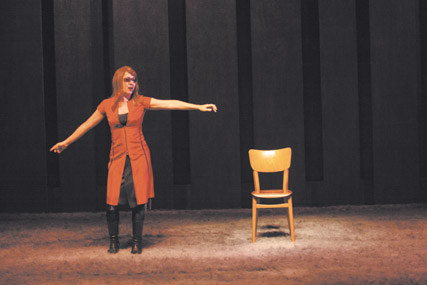
Marie Brassard, Peepshow
photo John Sones
Marie Brassard, Peepshow
THE 2005 MELBOURNE INTERNATIONAL ARTS FESTIVAL OFFERED AT LEAST THREE WORKS WHICH HAD ME GUSHING WITHOUT APOLOGY TO ANYONE WHO WOULD LISTEN. THIS YEAR, HOWEVER, THERE WAS ONLY REALLY ONE WHICH PROVOKED THE SAME EMBARRASSING DISPLAY.
Not to overstate things: there were many, many pieces which were very good, but only a handful which were great, and only Marie Brassard’s Peepshow was an absolute must-see.
an issue of space
The problem wasn’t in the programming, but came down to space. Firstly, several shows were negatively affected by being placed in inappropriate venues. This was most notable in works staged at the Arts Centre—though blame cannot be levelled at artistic director Kristy Edmunds, since a quarter of the festival budget is allocated to hiring the Arts Centre before she even begins to select the year’s offerings. Secondly, and conversely, some truly exceptional works have the ability to reinvent the spaces in which they’re set. This year, Malthouse was the big winner in this regard. Though I’ve seen countless stagings in the Malthouse’s Merlyn Theatre, each night I attended the venue during this year’s festival I felt I was entering an undiscovered space.
Last year’s festival highlights were almost all set in unconventional locations: the concourse of Flinders Street Station; a pair of hotel rooms at the Grand Hyatt; the majestic, cavernous Exhibition Buildings. This added to each work’s uniqueness, and made for some unforgettable experiences. I can’t help but think that no matter how good this year’s works were, however, some were still hampered by an inability to transcend the restrictions of their location.
Robert Wilson’s I La Galigo is a perfect case study. It is, as expected, a piece of mammoth scale, both in duration and physical size. A retelling of Sureq Galigo, the ancient, epic poem of Indonesia’s Bugis people, it features a cast of 50 and a sizeable number of musicians accompany the story’s telling. And like most creation myths, of course, it’s a gripping narrative that maintains interest throughout with plenty of bloodshed, incest, omens and outrage. Played out across the entire stage of the State Theatre, Wilson ensures the opera is suitably grandiose and carefully paced.
But the program notes for I La Galigo note that audiences are free to wander in and out of the auditorium throughout the work’s unfolding, as would occur in a traditional piece of Indonesian theatre. This is a pleasing allowance, given the show’s three-hour span, but clambering past 20 pairs of knees for a breath of air isn’t really something most Arts Centre patrons look well upon. Despite the opera’s excellence, I couldn’t help but feel it would work better in an open-air amphitheatre, or a venue which really encouraged the audience to appreciate the work in a more involved, less reverential way. When several patrons whispered to one another near my seat, there was no shortage of hostile glances from others nearby: Shhh! This is art!
romeo castellucci
Romeo Castellucci’s fourth instalment in the 11-part Tragedia Endogonidia series, BR#04: Brussels, would likely have suffered a similar fate had it been staged to too large an audience. In the Merlyn, however, it created an intimate and immediate experience that for me made it an unqualified success. Castellucci’s method with this series was to travel to a European city with his company and create an impressionistic tragedy without chorus, a sequence of scenes without dialogue that responds to, but does not explicitly comment on, that city’s history, culture and place. In the case of Brussels, Castellucci’s performers enact ritualistic displays which connote governance, relationships of power and brutality, and the passing of time as played out upon the human body. Images are sometimes strikingly simple: a curtain opens on a baby, perhaps eight months old, gurgling away on a blanket, while a robotic head at the rear of the stage recites numbers. Simple, yes, but hugely evocative of all sorts of ideas: vulnerability, growth, education, emptiness, immediacy. The fact that the unattended baby is in no way directed by Castellucci also drives home the work’s ineffable liveness, and the accompanying chance and unpredictability that go with any form of live performance.
Theatre of this type can be the most difficult to create, since Castellucci does not generate fixed meanings, nor deny such meanings, but establishes the conditions required for meaning-making. The sequences we bear witness to, and their juxtaposition, allow their audience to mentally wander through vast chasms of possibility, echoing with notions of religion, mortality, power and the passing of time. We’re never sure what Castellucci’s intentions are, but surely we’re past the need to find such authorial intentions. This is the kind of work which trusts its audience’s capacity to interpret, and offers a rich abundance of material with which to do so.
At the same time, Castellucci’s is not merely an intellectual exercise. Many of the provocative scenes don’t simply appeal to our cerebral, analytical side: bloody police violence, the decrepitude of an aging body or the frailty of an infant all call forth immediate, bodily responses, whether revulsion, sympathy, abjection or delight. It’s an excellent deployment of theatre’s liveness, its temporary nature, in which an audience and performers share a space and a moment, both of which will soon be gone. While many conceptual performances would seem as vital on paper as in actual production, this work, at least, is utterly and necessarily alive.
marie brassard
I’ll confess that, despite the enraptured reports I’d heard, I wasn’t too optimistic about Marie Brassard’s Peepshow. The promise of a solo piece whose main point of interest was the electronic alteration of its performer’s voice conjured up images of, at best, a Laurie Anderson-style experiment with technology that might have had some urgency two decades ago or, at worst, the kind of gimmickry that kept many a BBC sound engineer in business during the Doctor Who years of my youth. The moment Brassard uttered her first words, though, I was instantly converted. Over the next hour and a half, she became, variously, a child of six, a deep-voiced man, a guttural ogre and much more besides. The technology she employs is so effective that, indeed, I have no idea what the ‘real’ Marie Brassard sounds like; this is entirely in keeping with the chameleon-like nature of the work as a whole.
Peepshow is about the mutability of identity, most especially as expressed through desire. Brassard wears a heavy blonde wig and oversized sunglasses, concealing her face, and a long red coat and black boots which equally serve to cover rather than reveal. She is the lone figure in a setting of thick rusted pillars and dense shagpile carpet, and for most of her monologue is lit by a dim, shifting lightscape that often creates the effect of viewing the performer through murky water. Her voice always pierces that space between stage and audience, however, and acts as a tour guide through a tangled maze of taboo, horror and sensuality.
She begins with a retelling of the Red Riding Hood fairytale, but despite the story’s iconic familiarity we hang on every suspenseful word, unsure what twist will emerge in the next sentence. From here, her narratives spiral out to encompass childhood humiliations, wistful memoir, fears of what lurks beneath the bed and several disturbing sadomasochistic journeys into what may be fantasy, but may be all too real. Like every other aspect of this compelling work, however, it’s clear that Brassard is far too confident in her ability to construct and exchange masks for us ever to mistake confession as autobiography. At the same time, in donning these masks Brassard produces the sense that at that moment, at least, these identities are a kind of truth, and that fantasy itself offers an experience both real and unreal.
I La Galigo, direction Robert Wilson, adaptation, Rhoda Grauer, music Rahaya Supanggah; State Theatre, Victorian Arts Centre, Oct 19-23; Societas Raffaello Sanzio, Tragedia Endogonidia: BR#04 Brussels, direction, design Romeo Castellucci, writings, direction, vocal, sound, dramatic score Claudia Castellucci, original music Scott Gibbons; Malthouse Theatre, Oct 12-15; Peepshow, devisor, director, performer Marie Brassard, music & sound design Alexander MacSween, lighting Simon Guibault, Malthouse Theatre, Oct 24-28
RealTime issue #76 Dec-Jan 2006 pg. 30
© John Bailey; for permission to reproduce apply to realtime@realtimearts.net
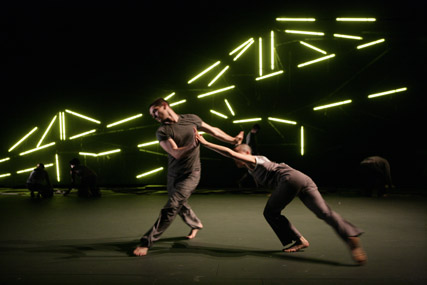
Byron Perry, Kirstie McCracken, Lucy Guerin Inc, Structure & Sadness
photo Jeff Busby
Byron Perry, Kirstie McCracken, Lucy Guerin Inc, Structure & Sadness
ACCORDING TO JÉRÔME BEL, TO WATCH CONTEMPORARY PERFORMANCE IS TO GAMBLE AGAINST THE ODDS. “DOES ANYONE ASK FOR THEIR MONEY BACK?”, ASKS CLASSICAL THAI DANCER, PICHET KLUNCHUN. “NO, THEY ACCEPT THE RISK”, SAYS BEL.
I prefer to think of that risk in other than economic terms: that we go to performance to risk ourselves and that, every now and then, the risk pays off. We become smitten, taken over, inhabited by a power beyond and below who we are. A crowd of individuals walks in, lights dim, marking a break with theeveryday. There is an energetic connection between the audience and a work, poised to dissipate but sometimes, sometimes it explodes. At its most animal, it bites, like Marie Brassard’s wolf (Peepshow) or pounds like Romeo Castellucci’s truncheon (Tragedia Endogonidia). The wound is our human mortality, an opening which may be covered but never closed.
brassard
Marie Brassard uses sound distortion to assume multiple shapes, the wolf who stalks Little Red Riding Hood, a young woman stalking an older man, a child, a man, a woman. Eyes shrouded in dark glasses, her impenetrability contrasts with our own, for we are invaded by her voice, his voice, its voice. There is a corporeal immediacy about sound. It sets moods, timbres of feeling outside the sagging impact of language. In Brassard’s case, however, the texture of sound is melded with text, compelling us to take a journey, following crumbs in a dark forest. Like Bel, Brassard too speaks of a gamble. Here it is a child’s expectation that school will take the student beyond the obvious, through unexpected doors. The child is disappointed but we are not. Our final destination is the wolf’s lair, a series of doors leading beyond the known world. Like Herman Hesse’s novel Steppenwolf, this theatre is for the madman within.
castellucci
Romeo Castellucci’s epic consideration of creation through the book of Genesis—Genisi, from the Museum of Sleep (MIAF 2003)—provoked a visceral excitement, from the small flickerings of light to the blinding whiteness of Auschwitz, the antithesis of creation. This year’s Tragedia Endogonidia was also performed in white, white marble, splashed with red. The horror of a police beating, reminiscent of Dario Fo’s play Accidental Death of an Anarchist, was magnified by the sounds of the truncheon. Sound does something beyond the visual. We can watch from a distance, but sound enters the body, it touches us in the passages of the mind.
wilson
Robert Wilson’s collaboration with Indonesian artists operated in other ways. A highly visual work, recalling shadow puppetry, I La Galiga performed an epic consideration of human desire and spiritual fulfillment based upon Sureq Galigo, the epic poem of the Bugis people of South Sulawesi. Wilson’s refined sensibility manifested in the most delicate of colour changes, shifting tones and frames, allowing for the collaborative contribution of Indonesian dancers and musicians, resplendent in texture and textile, musical mastery and narrative power. If Tragedia Endogonidia was a meditation on time, I La Galiga occurred before time began, in the netherworld of gods made human. While the story hails from early Bugis society, Wilson’s dancers and musicians provided a corporeal link, a bodily genealogy reaching towards the cultural origins of Sureq Galigo. One of the great pleasures of the work was seeing fantastic performers from a tradition quite outside the Western canon. Their energy, their use of form, gravity and focus was quite particular, forming a hybrid of Indonesian art and Western theatre tradition. Having seen some Japanese Noh theatre recently, I was reminded how a work over several hours unfolds rhythmically, unable to be contained in the one thought, the one soundbite familiar to conventional Western theatre.
warby
Unlikely works also achieve vastness. Ros Warby’s Monumental was performed alone in a large space yet was equally compelling in its own attempt to address the philosophical question of being and time. Through engaging with non-human life, Warby immediately extended the realm of the solo dance form into larger questions of existence. Her work as bird was not produced through mimesis but arose through a powerful evocation of the being of the bird. This was boldly enhanced by black and white projections of birds, that opaque look of the bird, its stare. Warby rendered the jointedness of birdlike action through a choreography of line and angle, an inhuman collage of movement without sentiment. Margie Medlin’s lighting design and (with Ben Speth) her wonderful images of sections of Warby’s body in movement amplified the sense that this was not about the person. Black and white enlargement of bodily sections achieved a kinaesthetic abstraction beyond the human. Warby’s skill manifests in the ability to differentiate qualities of movement in motion, to sustain change within a body over time. If art relates to our becoming animal rather than the rarified human (Deleuze), Ros Warby has allowed the spectator to experience much more than the celebrated dance of personality.
guerin
Lucy Guerin’s Structure and Sadness also looks beyond the human, at the interaction between animate and inanimate. Taking its lead from the collapse of Melbourne’s West Gate bridge in 1970, Guerin’s work explores physical forms of dependence. A meandering house of cards is slowly assembled, snaking through space. While we might admire the domino effect played out in miniature, the actual meaning of the collapse was tragic, not aesthetic. Fiona Cameron represented the way we live and die, blind to the fortune which lies around the corner, as distinct from the god-spectator who is able to predict disaster. Structure and Sadness was moving, combining physical meditation with human predicament. The movement leant on the materials of the work in a way which mirrored the theme of dependence and vulnerability at a kinaesthetic level. We watch the assemblage of fluorescent tubes over time—construction, destruction, construction—into a neon iconography of the bridge that fell.
Guerin also showed a work that she developed in Japan, a double bill with Koto Yamazaki. Guerin’s Setting was a gentle rendition in danced form of an interaction which might occur between people who share neither language nor culture. Objects were used onstage to delineate space and life aspiration. The gentle yet quirky affection between performers suggested something similar from the choreographer. The domestic proportions of Guerin’s collaboration contrasted with Yamazaki’s epic aspiration to depict the Australian landscape, a bold vision, but the piece looked like a satire of B-grade horror movies, minus the humour. The dancers worked really hard and with great integrity but I found myself emotionally outside rather than inside Chamisa 4¾C. Such are the risks of making and showing work.
yamazaki; bill t jones
I am sorry to kick a choreographer when he’s down but I also found Fluid Huh-Hug’s Rise:Rose underwhelming. It began with a certain refined energy, and Yamazaki’s own dancing melded seamlessly with the choreography but, by the time Paul Matteson performed a series of earnest ballet moves, the piece had begun to unravel. Its earlier sections with the three performers had some lovely interactions, and Mina Nishimura’s dancing was really interesting. But the piece seemed to lose the plot, lacking an editorial sensibility which might have saved the day. The same problem was evident in Bill T Jones’ Blind Date, a commendable critique of American militaristic, God-bothering imperialism. Its overload of images, text and movement detracted from the power of the work. Although Blind Date avowed continual questioning, attempting to break open American forms of certainty, the dancing itself was so confident, without question. Whilst performers took the risk of falling backwards into the arms of fellow performers, this looked more like a game than an expression of vulnerability. What Blind Date did offer was a palpable sense of community, of support, attention and emotional concern between the dancers.
bel
Finally then to Jérôme Bel’s Pichet Klunchun and Myself. I loved this piece, for its performative gems (Klunchun was superb), its ability to represent theatrical difference and for its sheer stimulation. The interaction between the two men was a lesson in the kinds of corporeal literacy implicit in each artist’s work. Although national differences were addressed, the work did not degenerate into cross-cultural banality. Specific questions were entered into, such as the representation of death, the territorial specificity of Klunchun’s body within space, and Bel’s disruption of the canons of Western theatre. Through conversation and enactment, the work allowed for multiple perspectives, for the wandering of the audience around issues of kinaesthetic investigation. Space was made for our own relation to the work. The focus of both performers was intense. Klunchun’s demonstration of walking was so clear, so physically differentiated and nuanced. And lest we imagine that he simply replicates the canon, he also explained the sense in which he has deconstructed and reconstructed his dance form. Bel and Klunchun are highly thoughtful artists, able to articulate their concerns in words and deed in ways which inform the experience of watching.
–
Melbourne International Arts Festival: Romeo Castellucci, Tragedia Endogonidia BR#04 Brussels, Merlyn Theatre, Malthouse Oct 12-15; Ros Warby, Monumental, Playhouse Oct 13-15; Lucy Guerin Inc, Structure and Sadness, Merlyn Theatre, Malthouse, October 18-21; Robert Wilson, I La Galigo, Arts Centre, State Theatre, Oct 19-23; Kota Yamazaki/Fluid hug-hug, Rise:Rose, Arts Centre, Playhouse, October 22-23; Marie Brassard, Peepshow, Merlyn Theatre, Malthouse, Oct 24-28; Bill T Jones, Blind Date, Arts Centre, State Theatre, October 25-28; Kota Yamazaki, Lucy Guerin, Chamisa 4ºC/Setting, Beckett Theatre, Oct 25-28; Pichet Klunchun and Myself, Arts Centre Playhouse, Oct 26-28
RealTime issue #76 Dec-Jan 2006 pg. 31
© Philipa Rothfield; for permission to reproduce apply to realtime@realtimearts.net






























































 JOHN PILGER IS A PARTICULARLY DISSONANT FIGURE IN PRESENT DAY AUSTRALIA. THE DVD RELEASE OF HIS DOCUMENTARIES ABOUT THIS COUNTRY CREATES AN OPPORTUNITY TO LOOK AFRESH AT THIS CONTROVERSIAL EXPAT JOURNALIST AND FILMMAKER.
JOHN PILGER IS A PARTICULARLY DISSONANT FIGURE IN PRESENT DAY AUSTRALIA. THE DVD RELEASE OF HIS DOCUMENTARIES ABOUT THIS COUNTRY CREATES AN OPPORTUNITY TO LOOK AFRESH AT THIS CONTROVERSIAL EXPAT JOURNALIST AND FILMMAKER. The CarriageWorks, built in the 1880s in Sydney’s Redfern and now with radically redesigned interiors, is Performance Space’s magnificent new home. This new contemporary performing arts centre has two wonderful performing spaces (800 and 300 seats), one of them huge, with flexible seating and rigging and accoustically excellent, roomy high-ceilinged rehearsal studios, offices and a vast naturally lit balconied foyer ideal too for performance. In our hard hats with architect Tim Greer of Tonkin Zulaikha Greer, journalists and NSW Arts Minister Bob Debus, we heard the centre’s Director/CEO Sue Hunt describe Performance Space as “an anchor tenant”, “a key partner” and as “providing a backbone” for The CarriageWorks. Asked about the new home, Performance Space Director Fiona Winning is “very excited about the move, by the new environment for some of the things we’ve always done and the opportunity it offers us to do things we’ve never been able to do. Collaborating with artists, audiences and some new partners in the local area, we’ll be opening in March with a program that places radical experiment alongside meditative community events and politically charged physical performance next to place-based installation. We’re up for the challenge of the change and can’t wait to get in there.” Resident with Performance Space at The Carriage Works will be physical and outdoor theatre companies Stalker and Erth. The first outside hirer will be the Sydney Festival opening the centre in January 2007 with the Australian Dance Theatre, Akram Khan & Sidi Larbi Cherkaoui and Israel’s Bathsheva Dance Company, a fitting prelude to this long-awaited adventure.
The CarriageWorks, built in the 1880s in Sydney’s Redfern and now with radically redesigned interiors, is Performance Space’s magnificent new home. This new contemporary performing arts centre has two wonderful performing spaces (800 and 300 seats), one of them huge, with flexible seating and rigging and accoustically excellent, roomy high-ceilinged rehearsal studios, offices and a vast naturally lit balconied foyer ideal too for performance. In our hard hats with architect Tim Greer of Tonkin Zulaikha Greer, journalists and NSW Arts Minister Bob Debus, we heard the centre’s Director/CEO Sue Hunt describe Performance Space as “an anchor tenant”, “a key partner” and as “providing a backbone” for The CarriageWorks. Asked about the new home, Performance Space Director Fiona Winning is “very excited about the move, by the new environment for some of the things we’ve always done and the opportunity it offers us to do things we’ve never been able to do. Collaborating with artists, audiences and some new partners in the local area, we’ll be opening in March with a program that places radical experiment alongside meditative community events and politically charged physical performance next to place-based installation. We’re up for the challenge of the change and can’t wait to get in there.” Resident with Performance Space at The Carriage Works will be physical and outdoor theatre companies Stalker and Erth. The first outside hirer will be the Sydney Festival opening the centre in January 2007 with the Australian Dance Theatre, Akram Khan & Sidi Larbi Cherkaoui and Israel’s Bathsheva Dance Company, a fitting prelude to this long-awaited adventure.












